Polytone Amplifiers Field Guide
Created 2/16/2025, Last updated 9/3/2025
By Paul Marossy
This webpage attempts to provide an overview of all the various Polytone amplifiers that were offered while the company was
producing amplifiers in North Hollywood, CA from approx. 1968 to the early-2000s(?). It is very difficult to find much info about Polytone amplifiers, and
it is further complicated by the fact that the same amplifier model number might have completely different features, such as the Model 102 below. I don't know
if that is an example of a transitional model, if one type superceded the other, or if the two types were being manufactured concurrently. Another example is
the Mini-Brute II. There was at least four different versions of it, and the features they employ depends on when they were made.
Polytone had more than two dozen different models of amplifiers. There is quite a variety of features that never seemed to be consistent.
For example, a Polytone amplifier may have a chassis with black silkscreening on bare aluminum. It might be red & white graphics on black, or simply white
graphics on black (on the later models). This does correspond with what time period the amps were manufactured, although in some case it appears that some
of these silkscreend graphics schemes were being used concurrently (the black on silver and red & white on black), but this could also indicate a transitional period.
The style of knobs changed many times. The speaker grilles on the early models were made of foam, and even amongst those, there were at least two different styles.
Some of those foam speaker covers survive to this day and some types disintegrated long ago. Some of the later date amps used expanded metal to protect the speaker(s)
instead of foam. Some of the later amps have an actual grille cloth like most of us are accustomed to. The Polytone brand badging also underwent several changes,
which seems to sort of conincide with approximately the timeframe in which certain amps were manufactured. The coverings on the cabinets could range from a
diamond pattern vinyl (aka diamond Tolex), a "soft touch" sort of velvet-like material or something that looked like actual Tolex, and that could be black, blue or various
other colors. I'm not sure these inconstencies and constantly morphing aesthetics would fly in today's world, but that's how Polytone chose to do things. On the other hand,
it does make for quite a variety of different looking amps with the same model numbers, which may or may not actually be the same in terms of the features they employ.
It can be a little difficult dating specifically when Polytone amps were made but here is a rough guide:
First series (1968 to early 1970s) -- Hard, rough surfaced black Tolex-like covering; silver-gray cloth applied directly to speaker baffle; rectangular metal Polytone label somewhere on the
front (later the full size speaker cover became black foam with squares); chassis is bare aluminum with black graphics.
Second series (about 1974-1980) -- Soft, velvet-like black covering referred to by Polytone as "Soft Touch"; white/gray baffle with semi-exposed speaker(s); rectangular metal Polytone label somewhere on the speaker baffle; bare aluminum chassis with black graphics; some models have a "Bi-Amp" feature; some models have Tremolo & Reverb and some have Harmonic Divider, Reverb
and Octave Divider; Distortion feature introduced.
Third series (1980-1984) -- Black diamond-pleated "Tolex" covering; full size foam speaker cover with diamond-shaped design; chrome & red cast Polytone logo with model name at bottom attached to upper left corner of speaker cover; control panel is black with white and red graphics, instead of bare aluminum with black graphics used on previous models.
Fourth series (1985-1990?) -- Black, grained Tolex covering; actual black grille cloth (not foam); plastic "P" Polytone logo on lower left of speaker grille; first models to have "mid" knob; the "RS Modulator" (chorus) is introduced on some models; graphics changed to white on black chassis.
Fifth series (1991-1998?) -- Blue grained Tolex-like covering with stackable corners (could also be in other colors like red or tan); metal speaker grille; long, full width plastic Polytone label across lower edge of baffle; amps have master volume and second preamp with edge control.
Sixth series (1999 to death of founder Tommy Gumina in 2013) -- Black Tolex with stackable corners; metal speaker grille; long, full width plastic Polytone label on lower baffle; amps have two preamps, second with "sonic" circuit.
There are outliers that don't exactly match what is described above but you can get a general idea of the time period the amp is from. The only way we could know anything for sure
is if the amp could talk! So all that to demonstrate that Polytone was constantly changing the appearance of their products. The only real way to date a Polytone is by date codes on pots, IC chips and speakers. If the speaker is original, that is. It seems
to be rare to find original speakers in a lot of Polytones. I've read that they had a tendency to blow in some models. For sure some people have changed the speaker to make it
"sound more like a guitar amp" because they are used to the giant mids scoop of other well known amps (which I dislike very much). Anyway, the OEM speakers used in the older Polytone amps
generally have a flat response, so they are more like a PA/monitor speaker, not the typical guitar speaker. This allows these amps to be used with a variety of musical
instruments such as acoustic guitar, bass, accordian and keyboards. This type of speaker seems to also work well with the simple Bass & Treble Baxandal tone stack
found in the earlier models. Later models added a mid control and it appears that the speakers used moved towards a more guitar-like frequency response. In any case, Polytone even offered one amp with a presence control, an open back model called "The Fusion". The Fusion is likely the definite exception with the speakers as the amp was designed specifically for guitar. My understanding is that CTS made their speakers from 1968-81 and after that the speakers were made by Eminence (apparently CTS was at some point absorbed by Eminence). I've asked Eminence for the specs on the speakers they made for Polytone but only received a generic response that basically told me to ask the internet. Some
people like to deride Polytone for their use of foam for the speaker covering, but I am pretty sure it was chosen for the acoustics, and not as a cost cutting measure.
Unfortunately some of the types of foam they used have chemically broke down and literally disintegrated some years ago.
As if that weren't enough, at least five different types of power amps were used in the Polytone amps line. The PA378 & PA378A were designed
around the LM391 IC chip. It appears that the PA378A power amp added a thermistor and protection diodes, I assume because they may have had problems
with power amps having meltdowns. The PA378B was substantially re-designed, and it does not use the LM391 IC chip. These power amps were generally 100 watts. There is
yet another type of power supply which is 55 watts and another one which is 110 watts. I am not sure if these pre-dated the PA-378 type or not. See the power amps section towards the
bottom of this page for more details.
Footswitches. Here's another area which can be quite confusing. There's about four different versions of Polyone foot switchers, and that can also be confusing as
to which amp they were intended to be used with. Below I have attempted to figure that out.
Schematics. Good luck finding any! At the bottom of this page I provided a link to the ones I could find. There are a couple of websites you can purchase schematics
from and I did in fact have to to do that for my Polyone Model 104 "Maxi-Brute" project.
I hope this helps anyone that is curious about these forgotten, criminally underappreciated and today relatively unkown amplifiers. They really do have a wonderful warm sound and if you are like me and don't like the giant mid-scoop of typical guitar amps, you might want to check out a relatively inexpensive Polytone amplifier such as the Mini Brute series. Big sound out of a small package!
Mini Brute
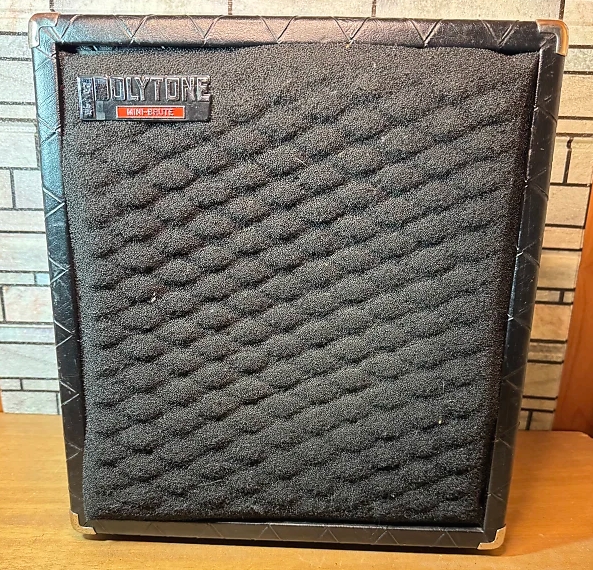 |
This is the most basic and possibly most well known Polytone amp. This is the classic 70s Polytone styling with the diamond shaped pattern vinyl cabinet covering and diamond shaped foam speaker cover. This little approx. 27 lb 100 watt amplifier is only 16" tall x 14" wide x 10" deep and houses a 12" speaker. This example is from 1980. The Mini Brute was introduced in 1976 according to the Polytone website. |
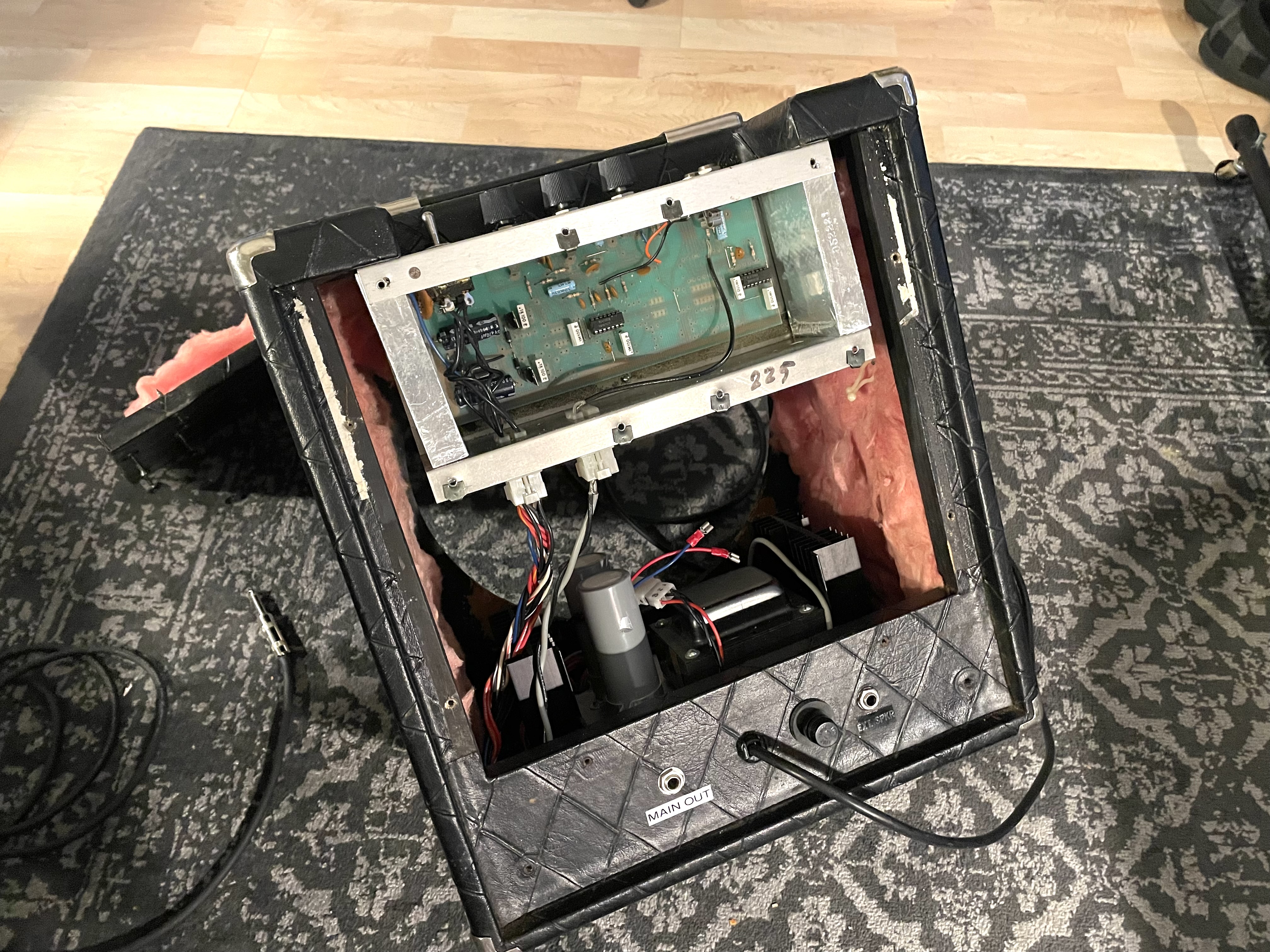 |
With the back cover removed, you can see the vertically mounted aluminum chassis and power amp mounted on the bottom. The cabinet is built very sturdily. |
 |
Here is the chassis pulled out of the cabinet. This is as simple as it gets: a bass control, a treble control and a volume control. Like on almost all Polytone amps, there is a hi and low input and a brite/normal/dark switch. |
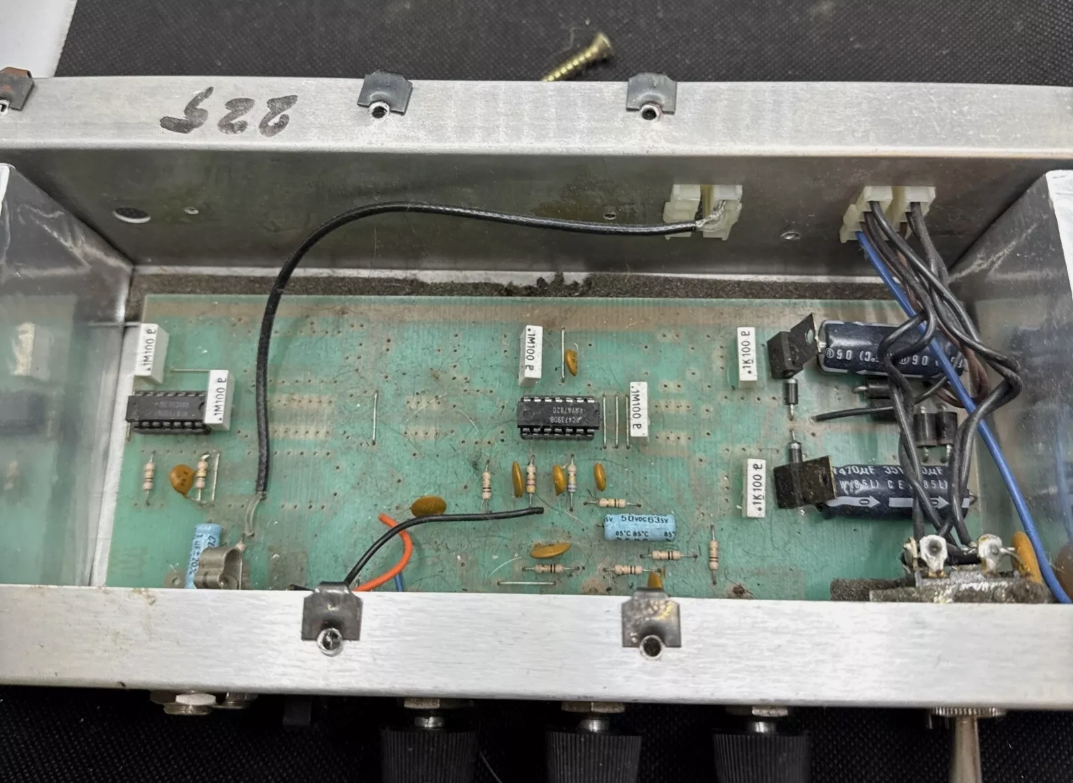 |
Looking at the component side of the PCB, you can see there's not much to the circuit. It uses a bipolar power supply and the tonestack is a Baxandal, which works well. The circuit board appears to be common to several models and you can see that all of the holes have been drilled and soldered but not much of it has been actually used. The component layout is essentially the same as the left side of the PCB layout I generated for my Maxi Brute Model 104. See links at bottom of page for the PCB layout I created. |
 |
This example uses the PA-378A power amp. Here it has been pulled from the cabinet. |
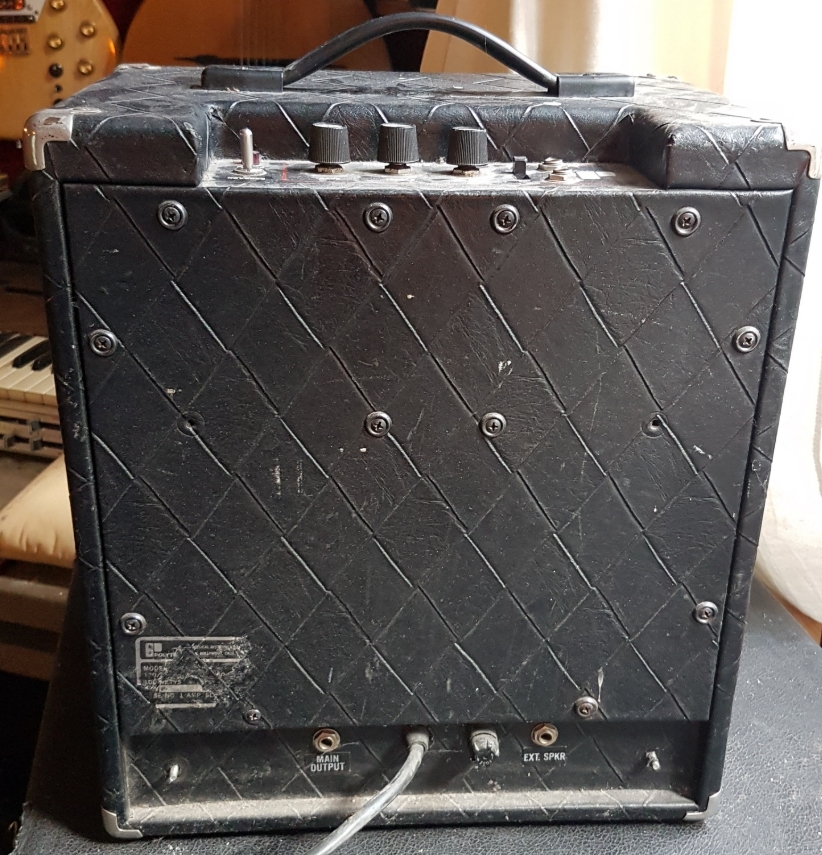 |
This is how the back looks with the back cover on. |
Mini Brute I
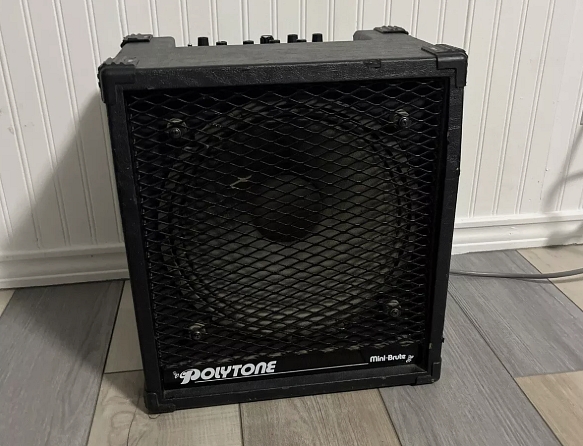 |
Here is the Mini Brute I. This is a good example of Polytone model numbers not necessarily being sequential. It was obviously manufactured some time after the Mini Brute II & III models. Power output is 100 watts and weight is approximately 27-28 lbs. Note this has the expanded metal speaker grille found on the later models. |
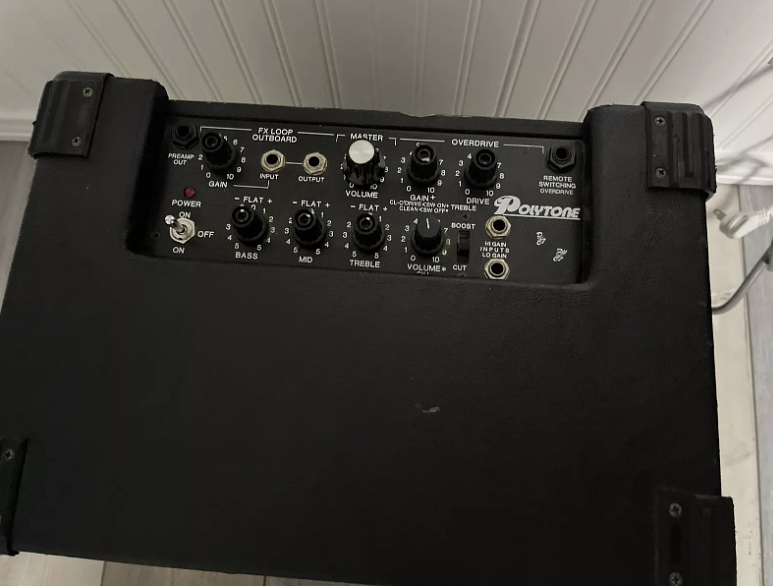 |
There's Bass, Mid, Treble, Volume controls and a Treble Boost/Cut switch. A Master Volume and there's an Overdrive circuit which has Gain and Drive controls. At upper left is an FX Loop with its own Gain control. And of course, the usual Hi & Low Inputs. At upper right is a jack for the overdrive remote foot switch. |
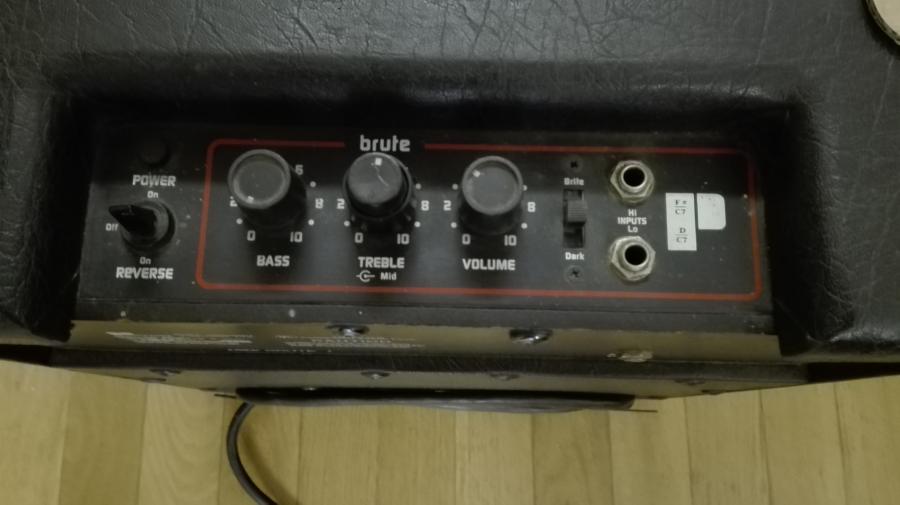 |
On this earlier model, which I believe is from the early 80s and clearly states it is a Mini Brute I model, the control scheme is like the Mini Brute above with the only difference being is that a Mid control has been added. All these variants of an amplifier with the same model name but very different features can certainly cause a lot of confusion for those unfamiliar with Polytone amps! |
Mini Brute II (1st Iteration)
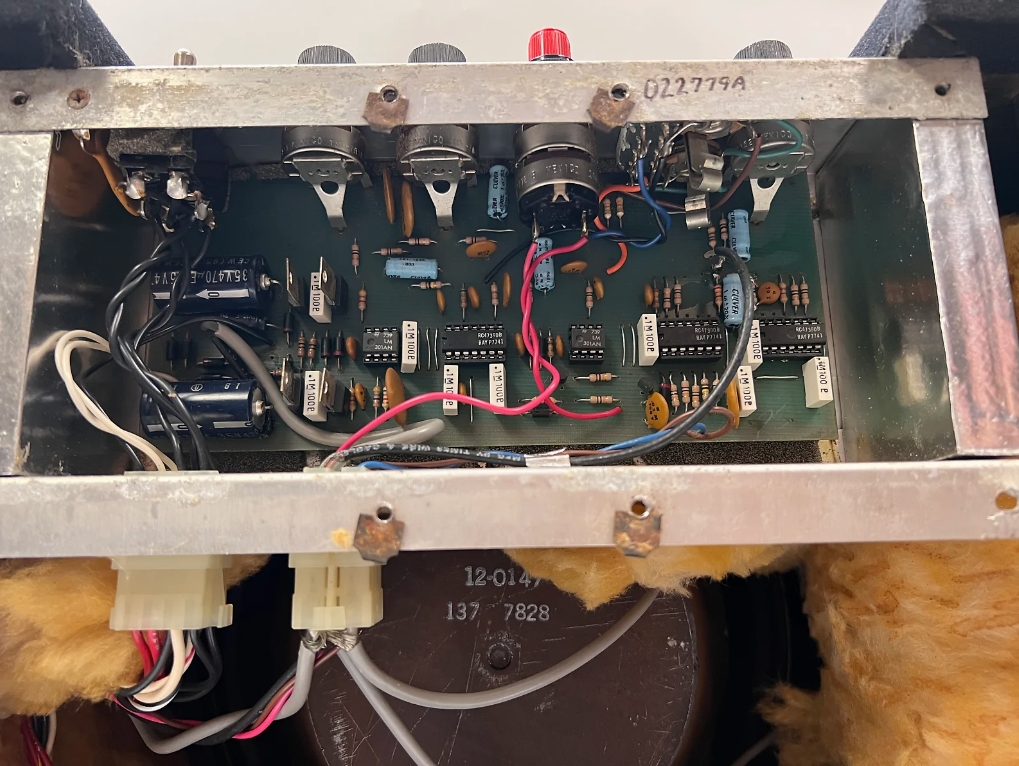 |
Cosmetically, the earliest (as far as I can tell) version of the Mini Brute II looks the same as the Mini Brute at the top of this page, but the badge attached to the foam speaker cover will say "Mini Brute II". What I wanted to show here is that the PCB layout is same as the Mini Brute at the top of this page but it is fully populated because it has the reverb and distortion circuits added. The foil design on the back side is roughly the same as the left side of the PCB layout I created for the Model 104 Maxi Brute (linked at bottom of this page). There is a link for a PCB layout I created specifically for this amp at the bottom of this page. |
 |
The DC power supply is at far left. The first opamp at left is an LM301. This is for the reverb circuit. The opamp to the right of that is an RC4739 and serves the inputs and tone stack. |
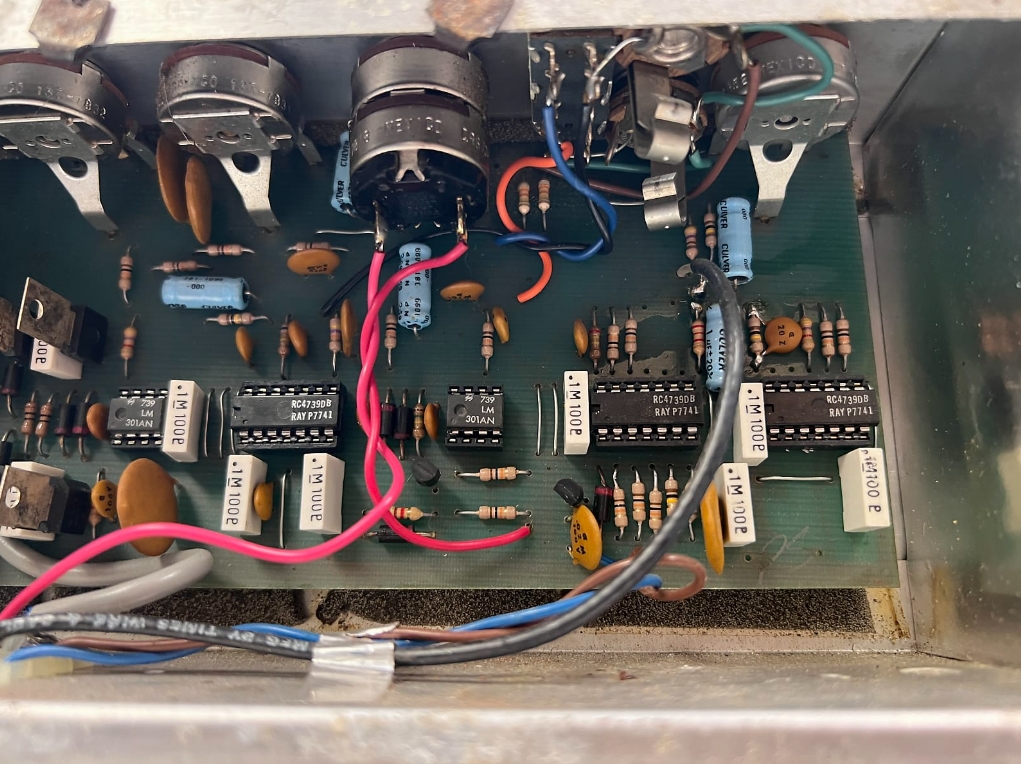 |
The opamp in the middle is also an LM301. It is the for the distortion circuit. The opamp second from the right is an RC4739, which is the reverb summing amp. The opamp to the right of that is also an RC4739 and is the main summing amp. |
 |
Here we can see the entire PCB from a different perspective. |
Mini Brute II (2nd Iteration)
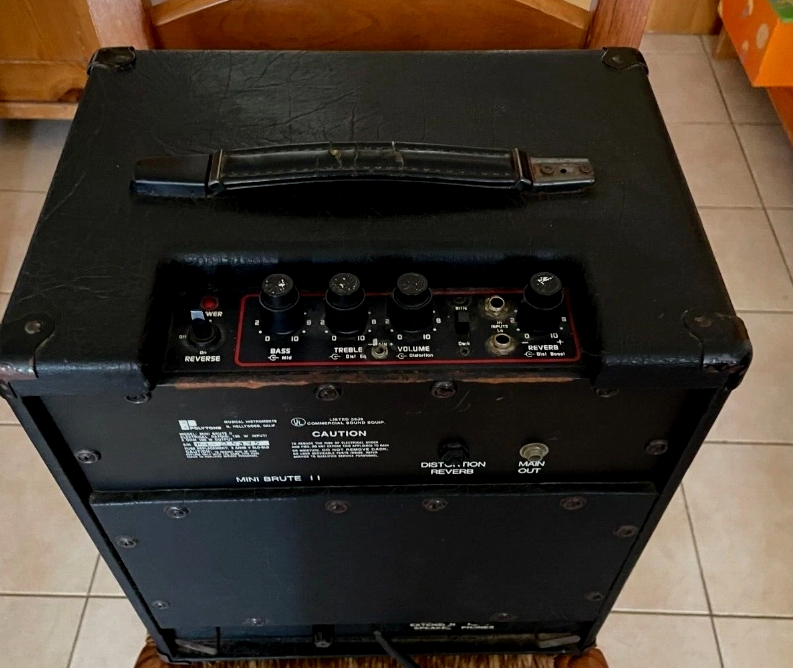 |
Cosmetically, this version changed the type of "Tolex" covering the cabinet and the arrangement of the back panels are different. Graphics are now red on black and a Dist Boost and Dist EQ knob have been added in addition to a Gain+/- switch which globally affects the gain of the circuitry. The front is similar to Iteration #3 below. |
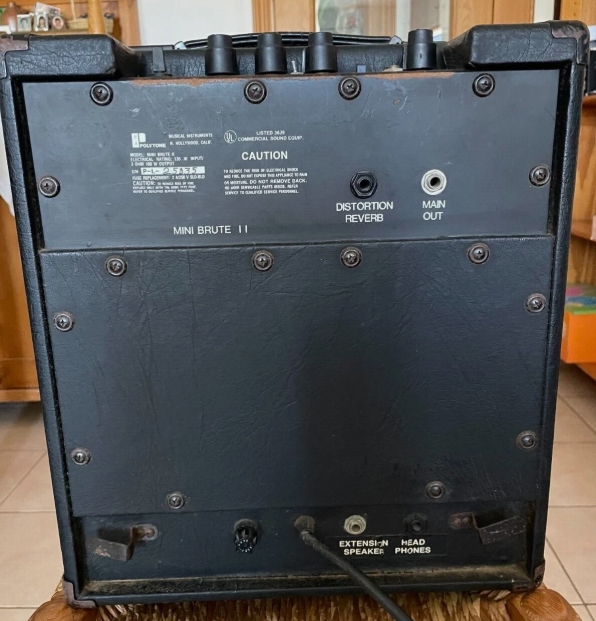 |
The back panel no longer covers the entire back and has been split into two pieces. One piece covers the chassis and has jacks for Main Out and Dist/Reverb footswitch. At bottom there are jacks for Extension Speaker and Headphones. Removing the other back cover gains access to the speaker and power amp mounted in the bottom of the cabinet. |
Mini Brute II (3rd Iteration)
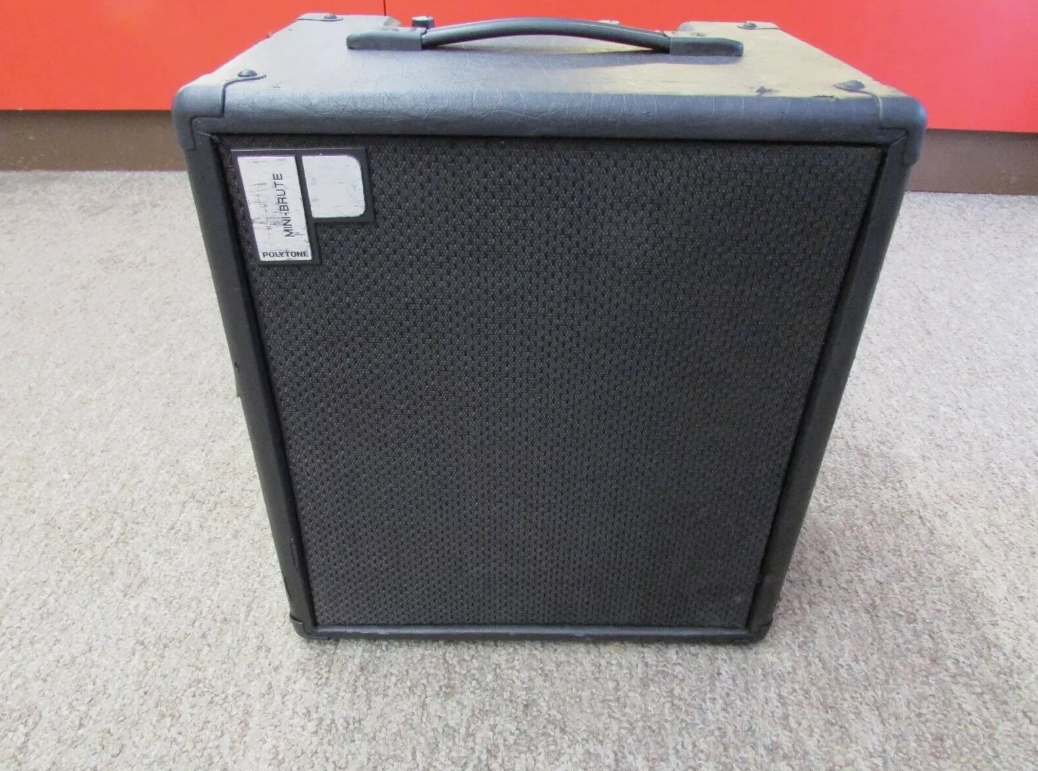 |
Here is the second version of the Mini Brute II. I'm not sure of the date of manufacture but I know of one example dated 1990. You can immediately see that it has a more modern look to it. The Mini Brute II is nearly the same as the Mini Brute I, but reverb and distortion has been added. Some models also have a Mid tone control and a Gain +/- switch. It uses a small vertically mounted 2-spring Accutronics reverb tank (marked as 8DB2C1C), which sounds decent considering its small size. |
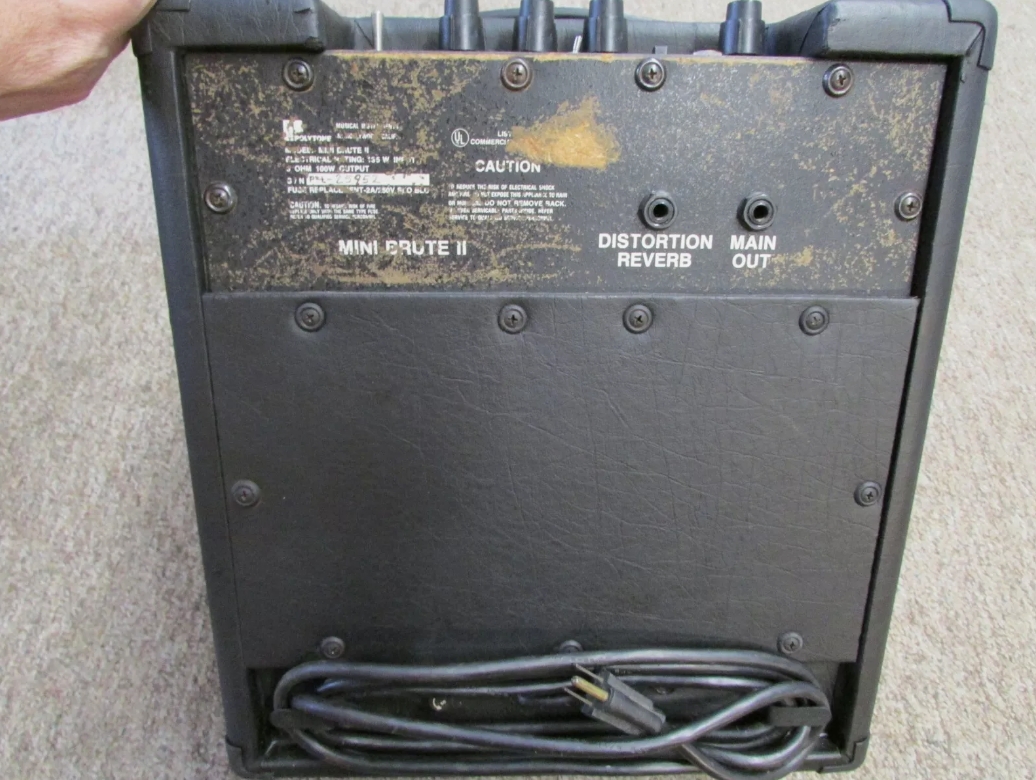 |
When looking at the back, you can very readily see the changes that were made on the back side of the amp. It looks a lot different than the Mini Brute I. There are jacks for Distortion/Reverb and Main Out. |
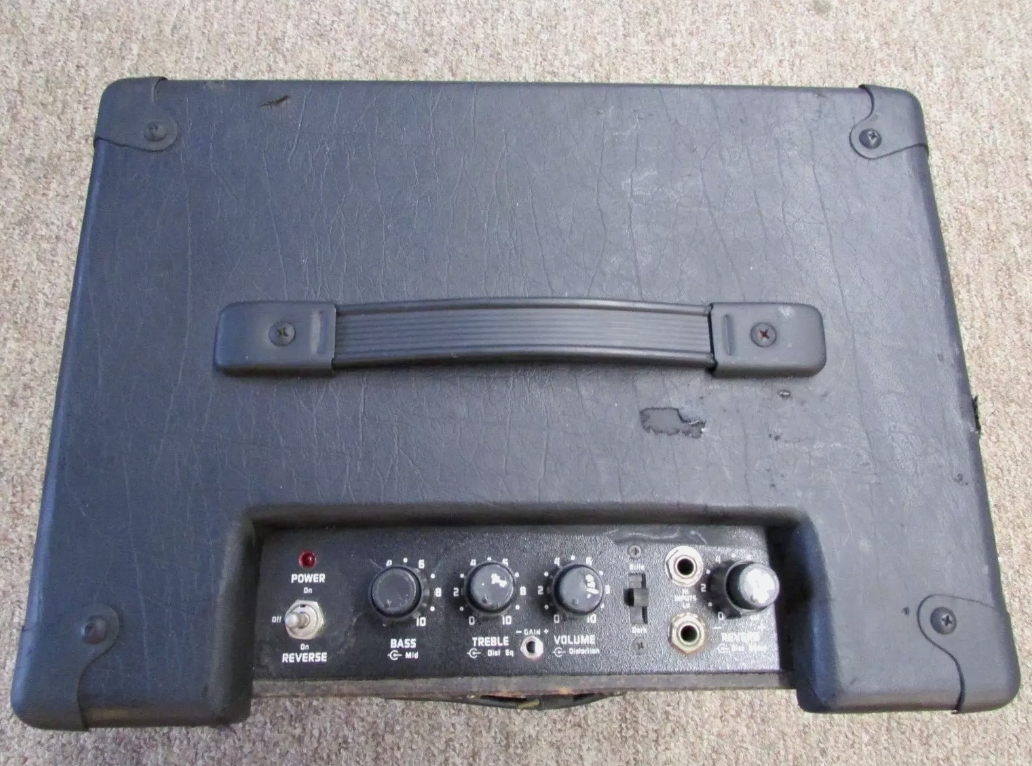 |
The controls from left to right are Bass, Treble, Volume and at far right, Reverb. There is a switch which is Gain -/+. Note on the this example the graphics are white on black. I think they changed to this scheme in late 80s/early 90s. |
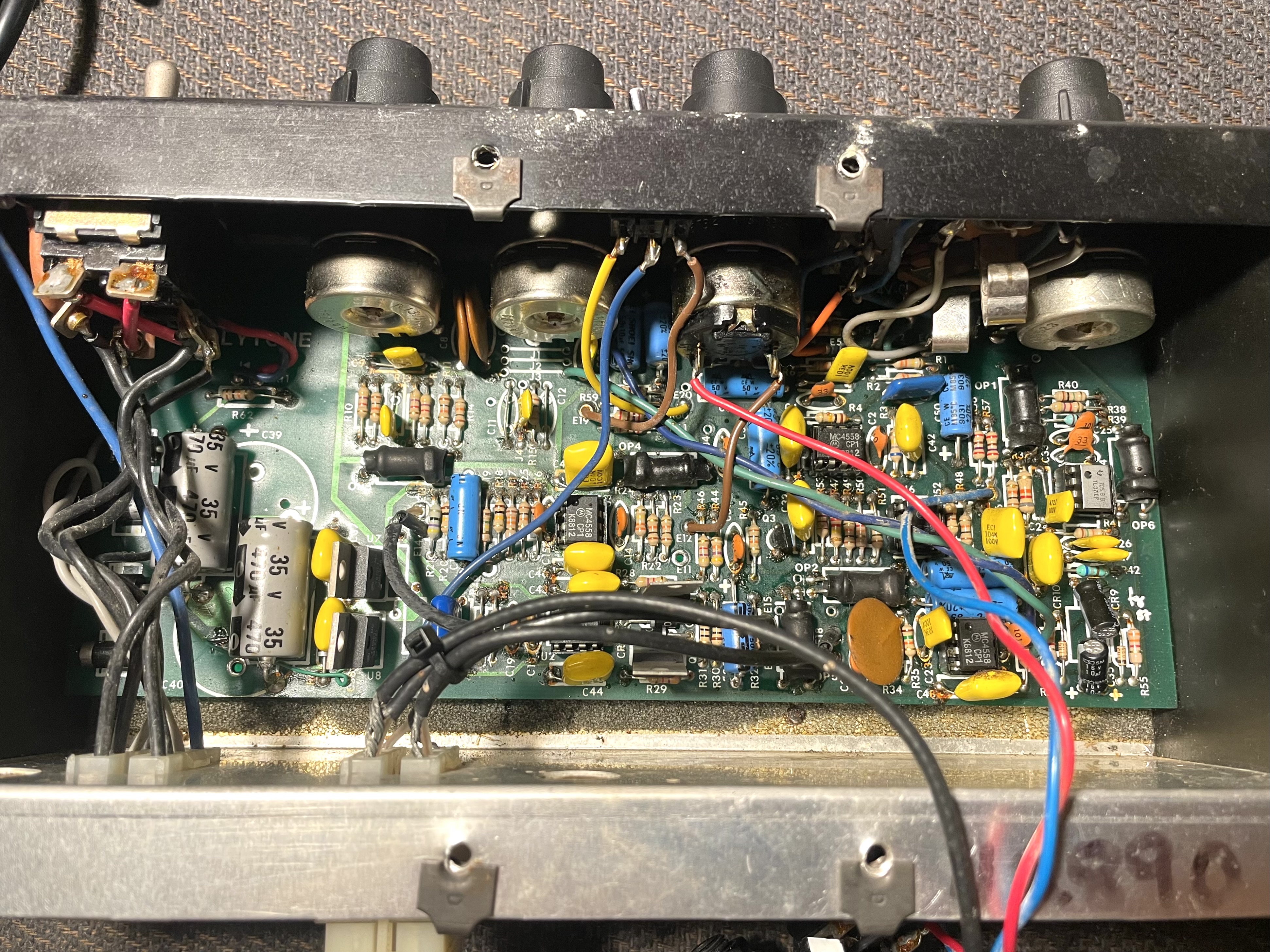 |
With the back removed you can see the component side of the PCB. It is a new PCB and circuit design which uses six opto-couplers (LED/LDR combo). This version has Mid tone control and Gain +/- switch. |
Mini Brute II (4th iteration)
 |
Here is yet another, and I believe, final version of the Mini Brute II. This one has the so-called "Sonic cicuit". On the Polytone website circa 2004 these had an MSRP of $845. Jim Hall apparently was using one at the time. Webpage also claims power output is 110 watts and weight as being 26 lbs. The features are different than the previous two versions - they are essentially the same as the Mini-Brute IV below. I believe it was around this time that Polytone switched from a 2-spring reverb tank to a 3-spring type. |
 |
The aesthetics have changed once again. Now there is no speaker grille cloth but rather an expanded metal grille that protects the speaker. The cabinet corners have also departed from metal types to the larger stackable plastic types ubiquitious on amps from this era. |
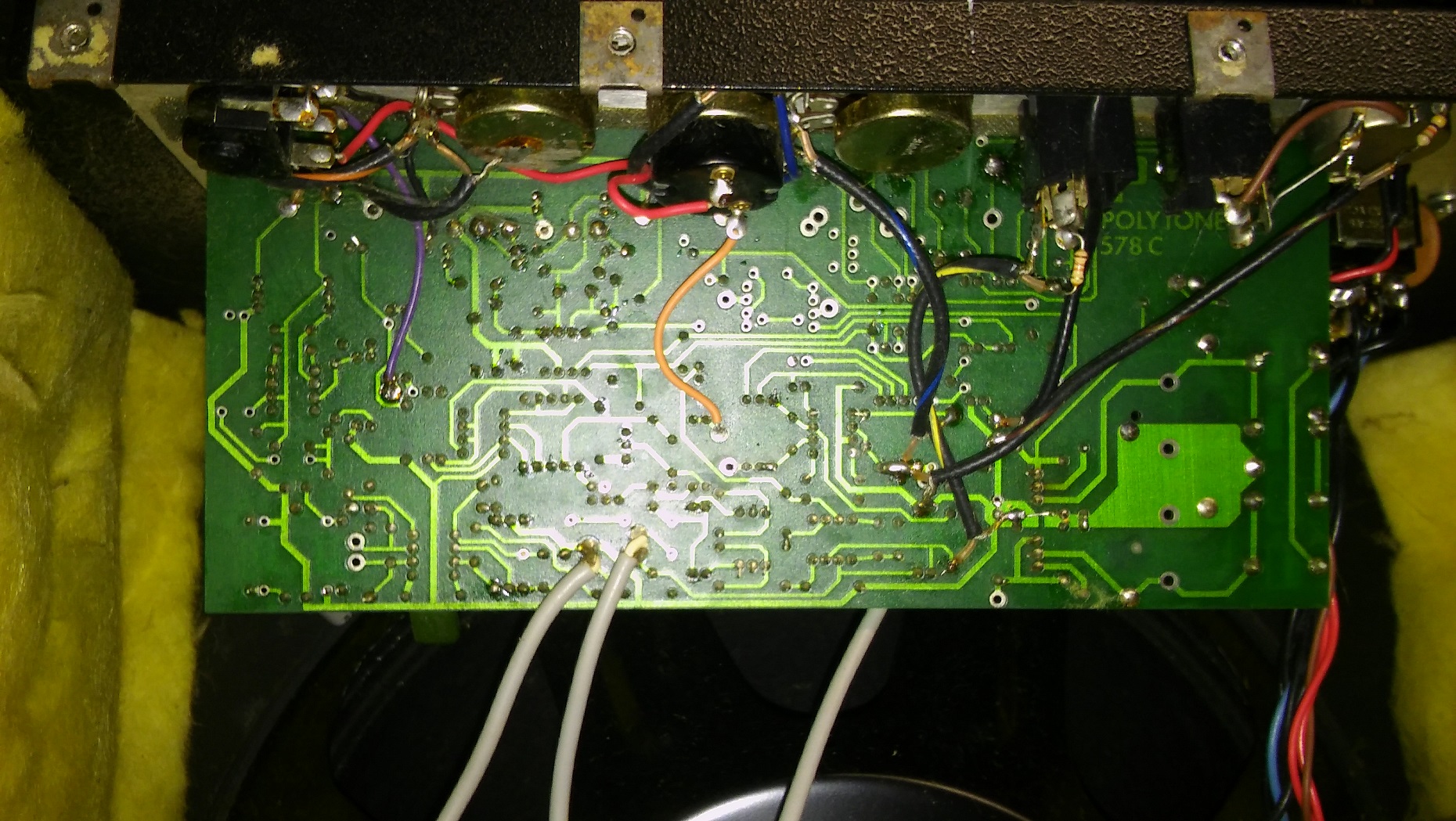 |
With the back removed you can see the foil side of the outer PCB. It's a completely different arrangement than earlier Polytone amps, and it kind of hangs there via the PCB mounted pots. Simpler and cheaper to manufacture the amp using this method but seems a bit questionable to me. Although, the PCBs in earlier amp models also hang inside the aluminum chassis too (but at same time it has an extra layer of protection being completely enclosed by the chassis). While this may be interpreted as Polytone being cheap, I think it was simply what they had to do to keep the form factor of the amp the same as the previous versions. |
Mini Brute III
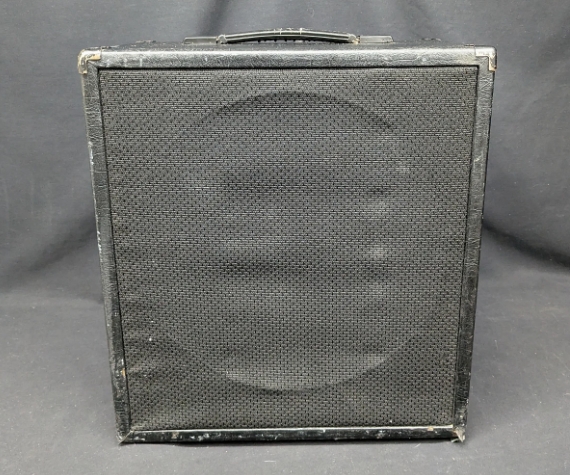 |
Here is the Mini-Brute III. It is essentially the same as the Mini-Brute I but it has a 15" speaker. It appears this one may have its original grille cloth but has lost its Polytone badge. Your guess is as good as mine. |
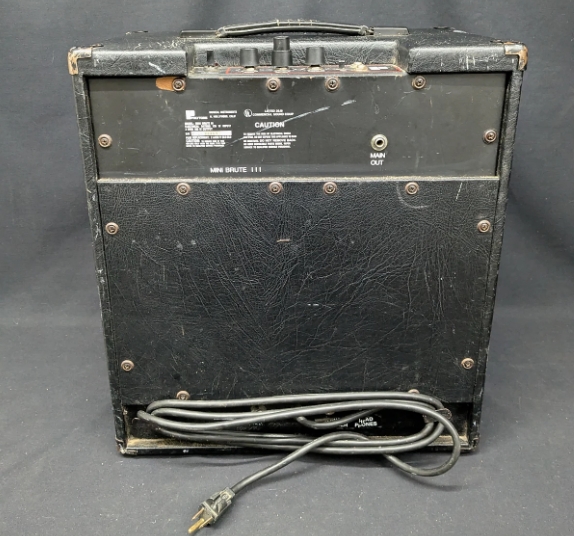 |
Notice the back looks very much like the Mini Brute II above. |
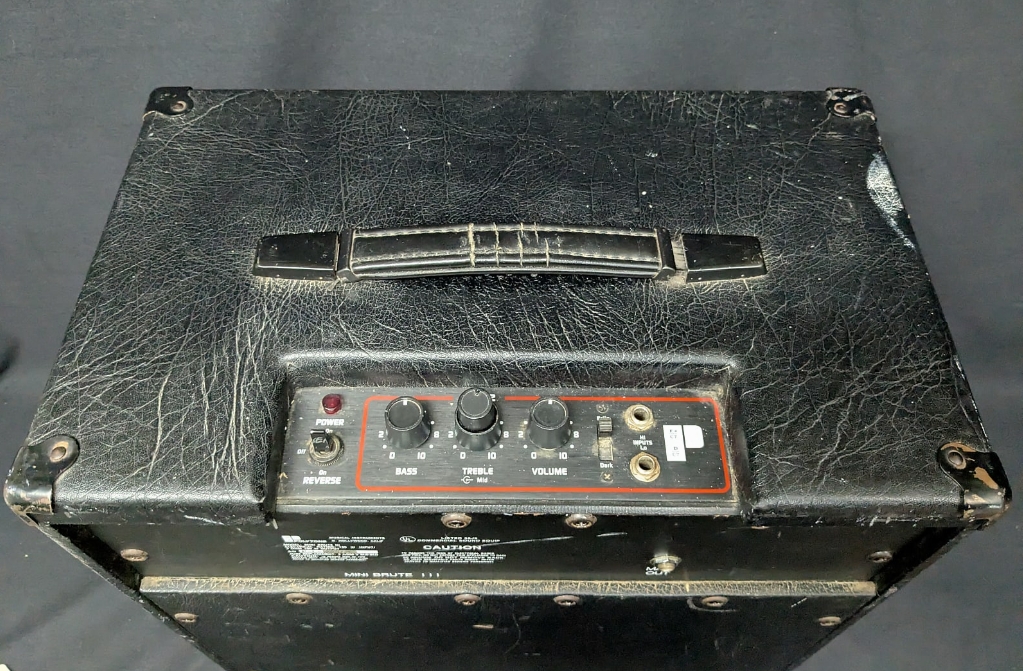 |
Here is a top view. This one has a quasi Tolex-like covering on the cabinet. |
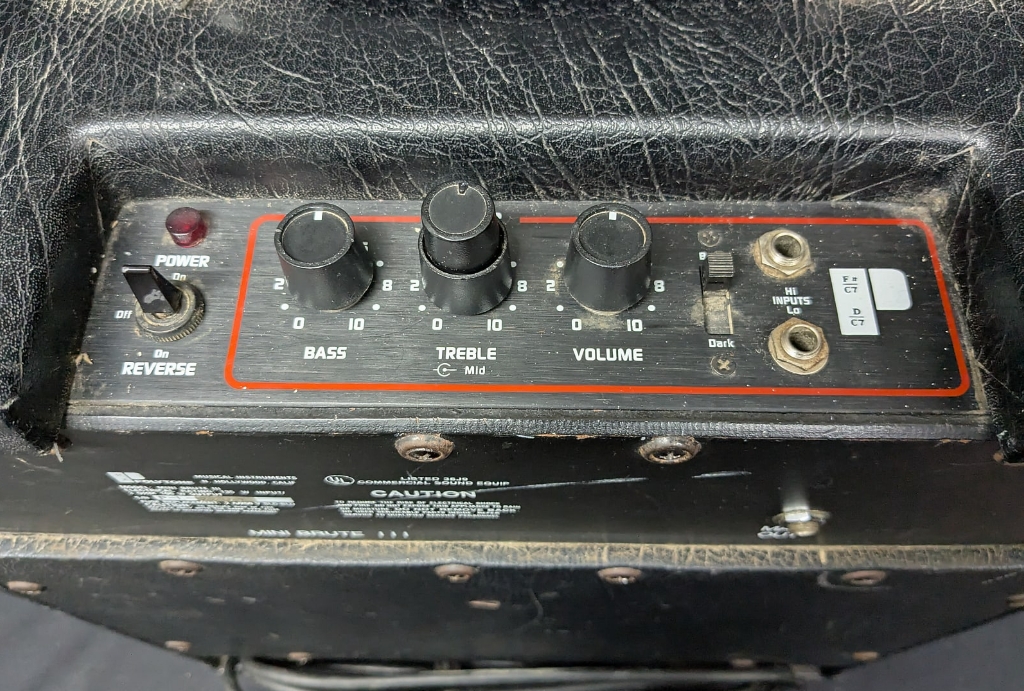 |
Controls are same as the Mini Brute I above - Bass, Treble & Volume. Note that the graphics are red on black. |
Mini Brute IV
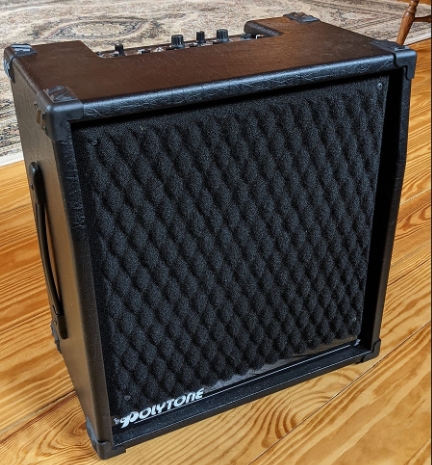 |
Here is the Mini Brute IV. While it is similar in size and format to the Mini Brute I, II & III the similarities end there. This one is a 2-channel affair with different styling yet again. Note the carrying handle is now on the side of the cabinet. On Polytone website circa 2004, the MSRP was $895. This was listed under the Special Orders section on the Polytone website |
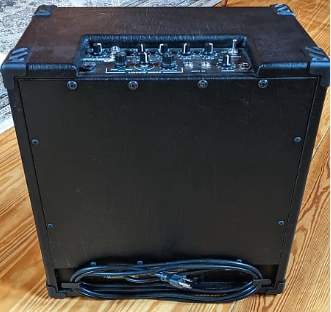 |
Here is the back. On this example we are now back to how they were doing things in the 70s. This is what I mean by inconsistencies at the top of this webpage. |
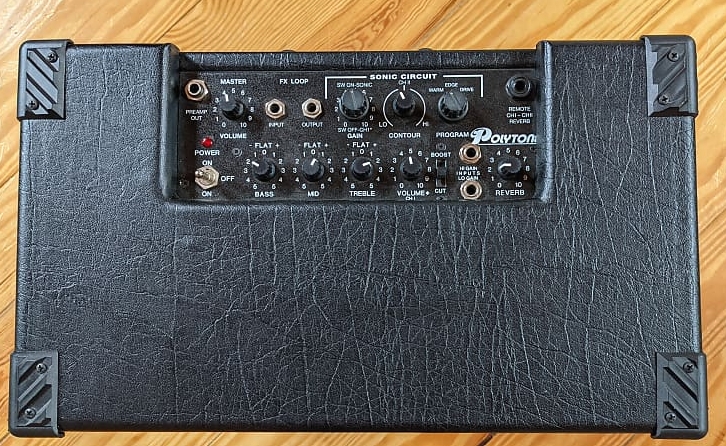 |
Channel 1 controls are Bass, Mid, Treble and Volume. Channel 2 adds a "Sonic Circuit" with a Gain, Contour and Program (Edge) control. There is also a Boost/Cut switch, Master Volume, Reverb level control and a jack for a remote foot switch. |
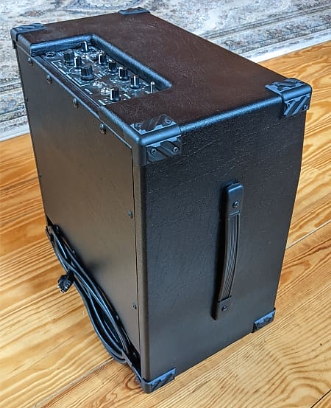 |
Here is a side view with a better view of the carrying handle arrangement. |
Mini Brute V
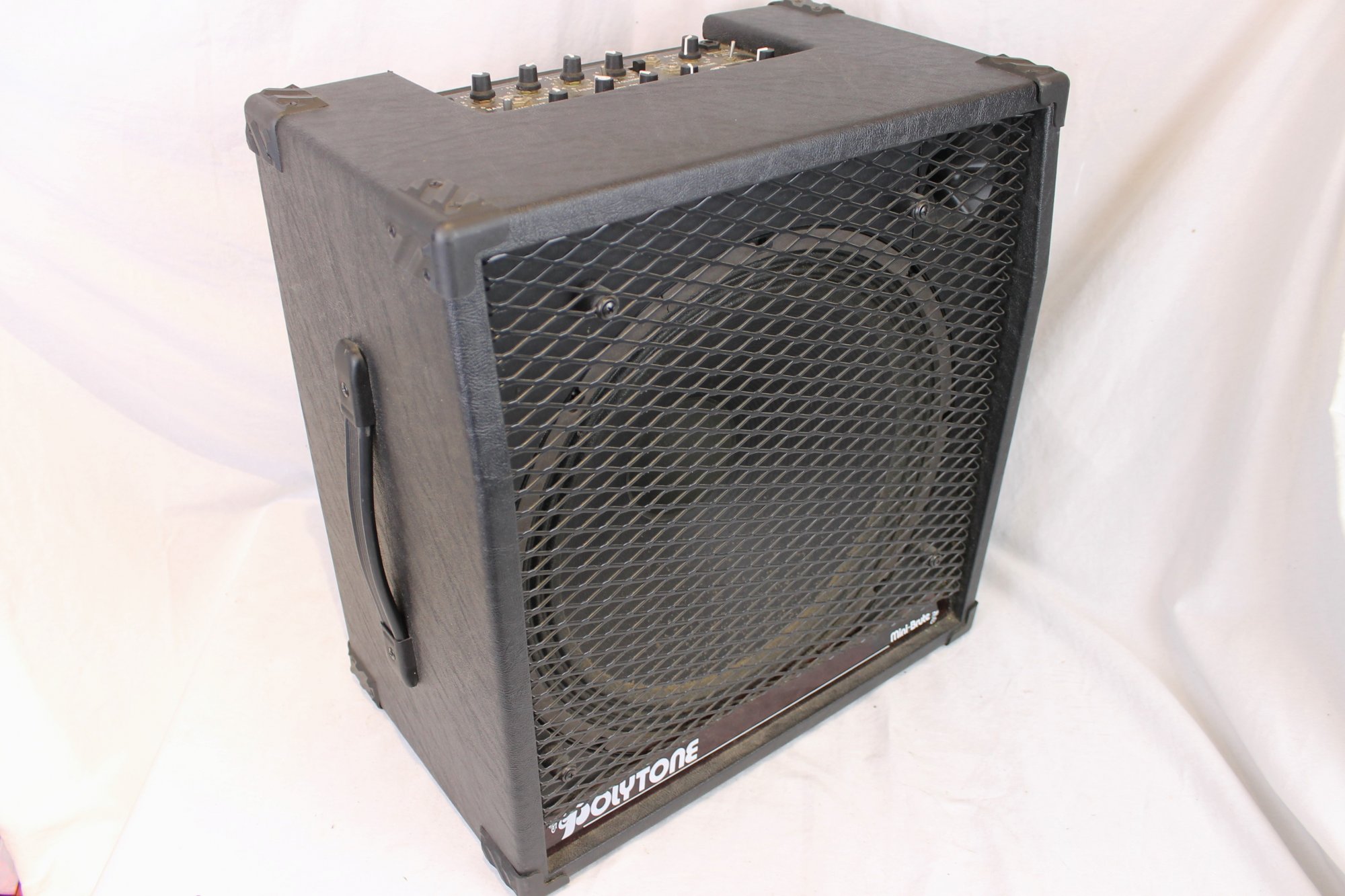 |
The Mini Brute V is the same as the Mini Brute IV but with a 15" speaker. Features are otherwise the same. 140 watts output and weighs 37.5 lbs. According to Polytone website circa 2004, this is the amp George Benson was using at the time. This was listed under the Special Orders section on the Polytone website. |
 |
Note that the back on the Mini Brute V is different than the Mini Brute IV example above. |
 |
Chassis and controls are the same as the Mini Brute IV. |
Mini Brute SK
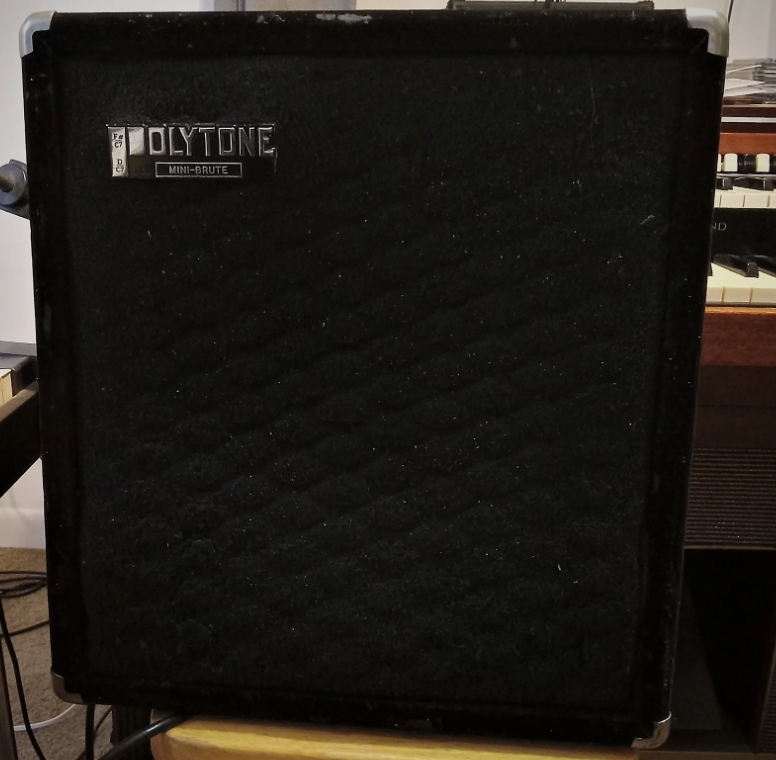 |
The front of the Mini Brute SK doesn't look much different than the Mini Brute I, but it is hiding a secret. More on that below. There is a single 12" speaker and the power output is 100 watts. |
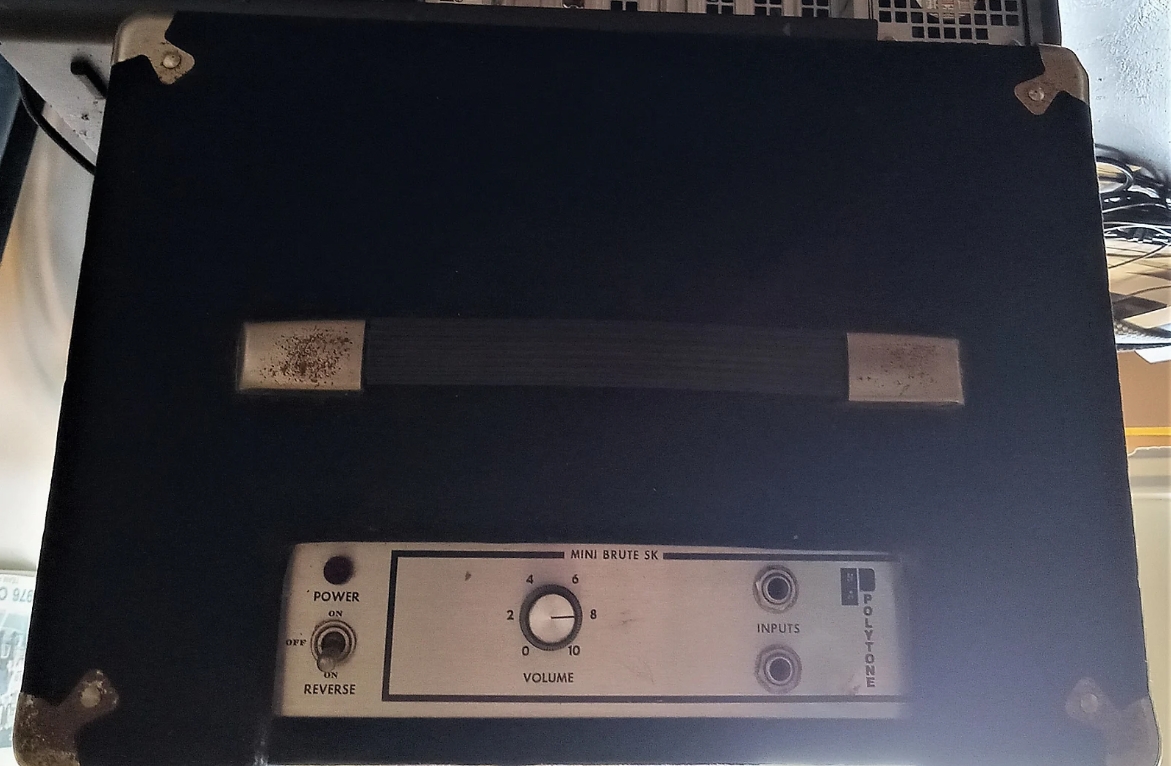 |
There is only one control - volume! The Brite/Normal/Dark switch found on almost every Polytone amp is also absent. This apparently is a very uncommon amp. There is some debate as to what it was intended to be. Some say it's essentially a powered speaker cab, and that would be correct.On Polytone website circa 2004 it lists passive speaker cabs with MSRP of $595 and powered speaker cabs with MSRP of $725. These were both listed as accessories on the Polytone website. No other details were given though. On 2014 version of website there were extension cabinets and powered "sidekick" cabinets. This is what the "SK" would denote. |
Mega Brute
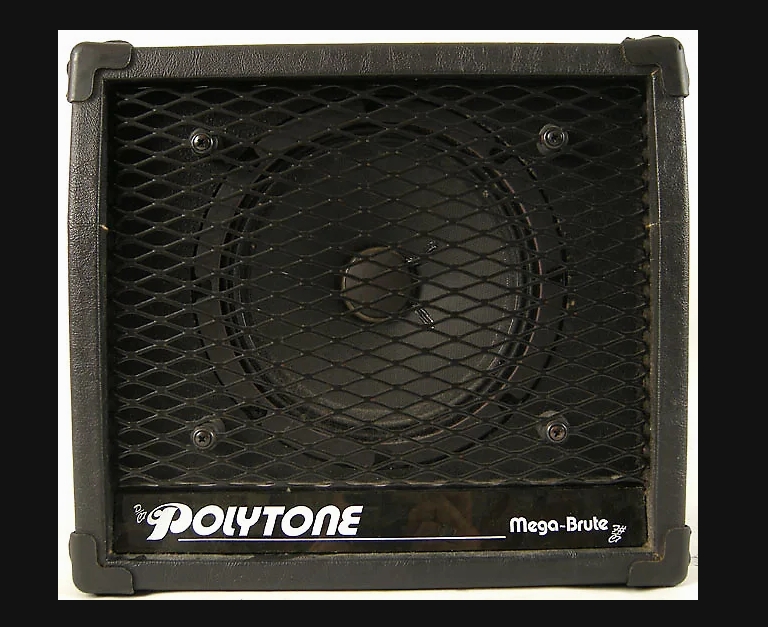 |
This cute little "Mega Brute" is like the Mini Brute IV but with an 8" speaker and 120 watts RMS output per the 2011 version of the Polytone website. It weighs 22 lbs. There was also a Bass Mega Brute version according to the Polytone website. |
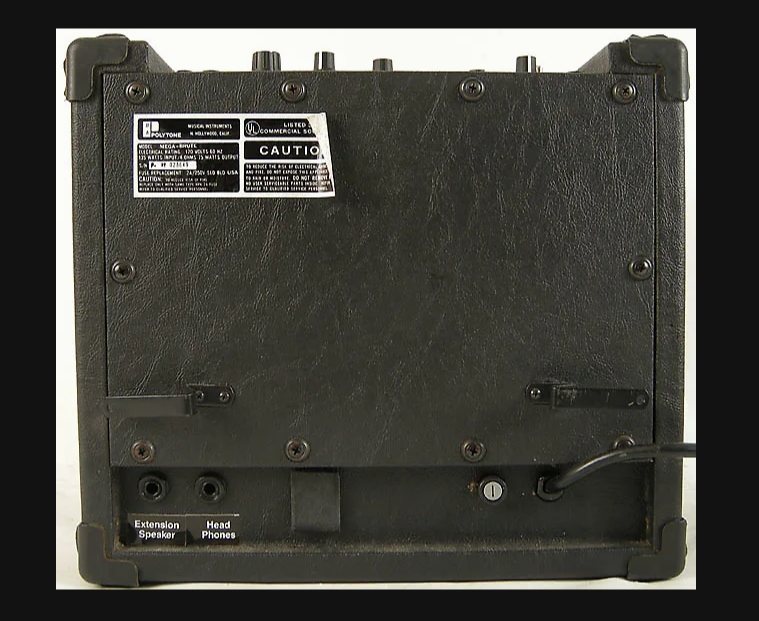 |
The back of the amp loosely follows other 70s/80s models but they changed the part that the power cord wraps around. |
 |
Here's a top view. Pretty much the same as the Mini Brute IV & V. |
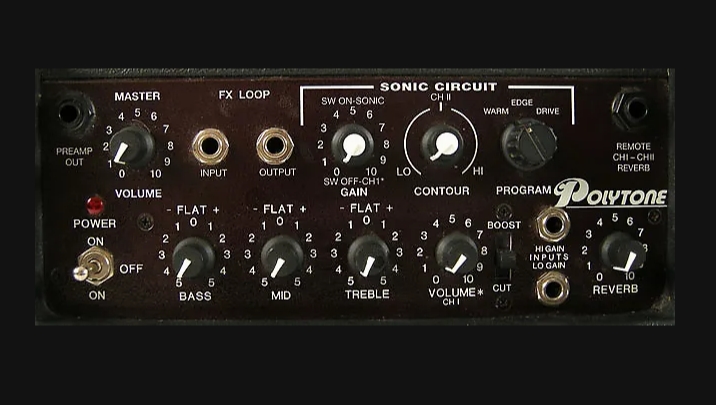 |
Close up of the controls. |
Mega Brain
 |
The "Mega Brain" is simply the Mega Brute in an adorable amp head format. I'm not sure of the power output rating. |
Mini Brain
 |
The "Mini Brain" is roughly the Mini Brute II in a tabletop 75 watt amp head format. Controls are Bass, Mid, Treble and Volume. Has the usual Hi & Low inputs and Brite/Normal/Dark switch along with Gain -/+ switch. According to Polytone website these weigh 8 lbs. Website also claims 120 watts RMS. Not sure which wattage rating is correct. These appear to have been introduced in 2009. MSRP was $995. |
Teeny Brute
 |
The Teeny Brute is essentially the Mini Brute with an 8" speaker and in a smaller cabinet. |
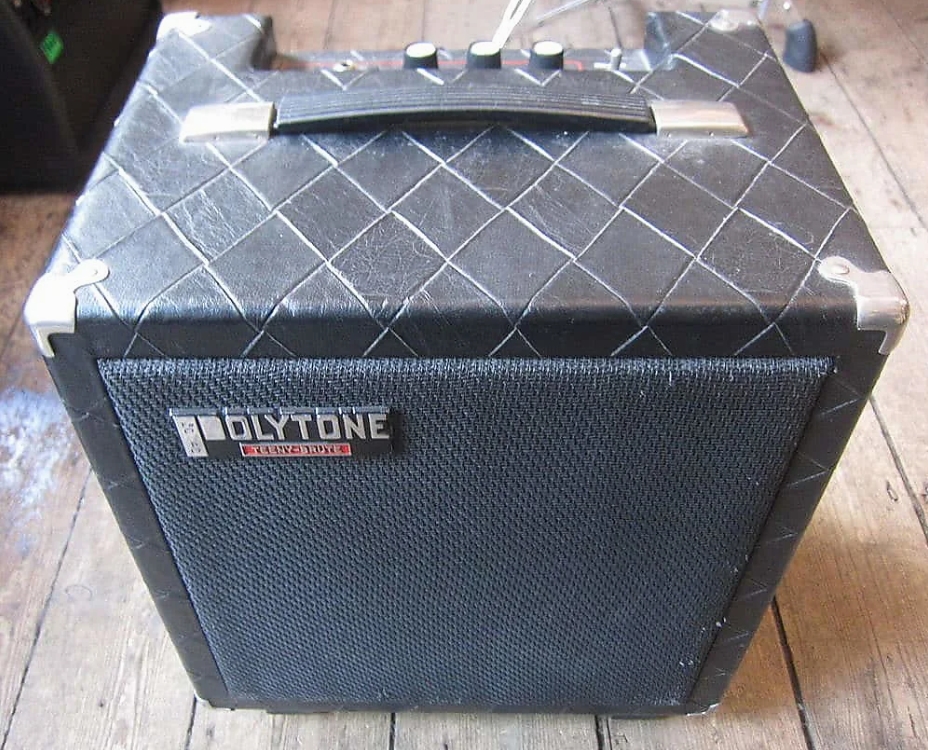 |
This example has the same diamond shaped vinyl covering on the cabinet. I do not believe that is the original grille cloth. I believe it would have had the same speaker covering as the Mini Brute at the top of this page. |
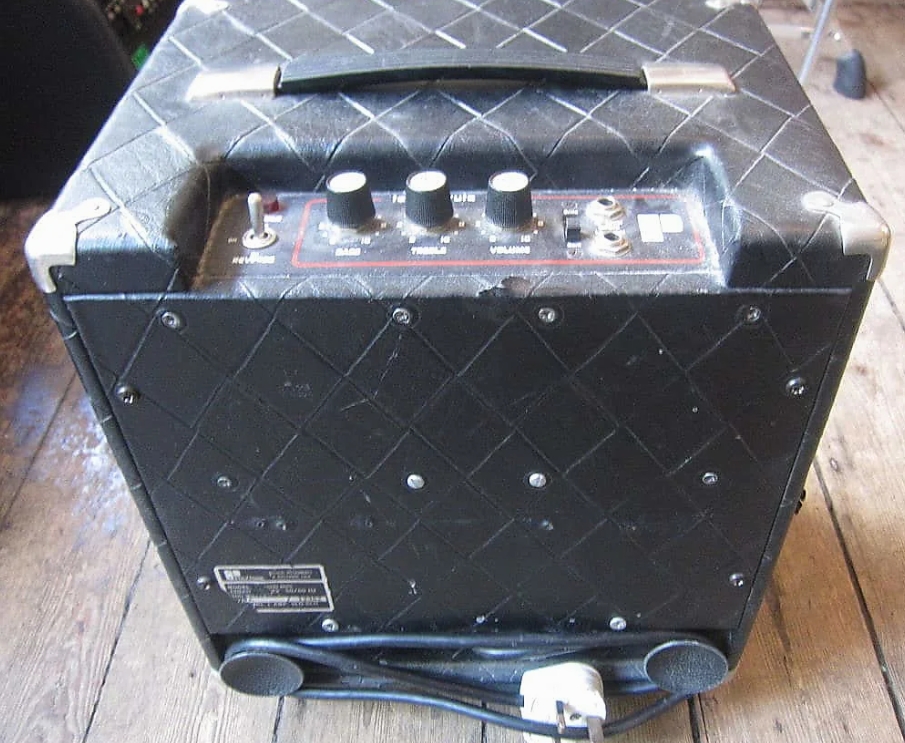 |
The back looks just like the Mini Brute at the top of this page, just a little smaller. |
Teeny Brute 3-Channel Version
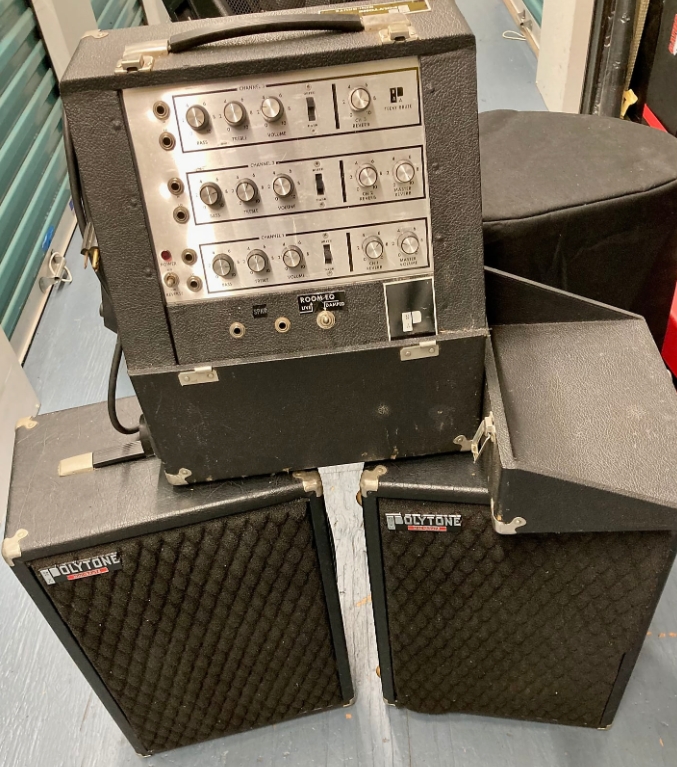 |
This version of the Teeny Brute is an odd one which has three indentical channels. Maybe it was meant to be something like a mini-PA system? It is sitting atop two speaker cabinets, each of which contain one 12" speaker and a pair of 2" tweeters. |
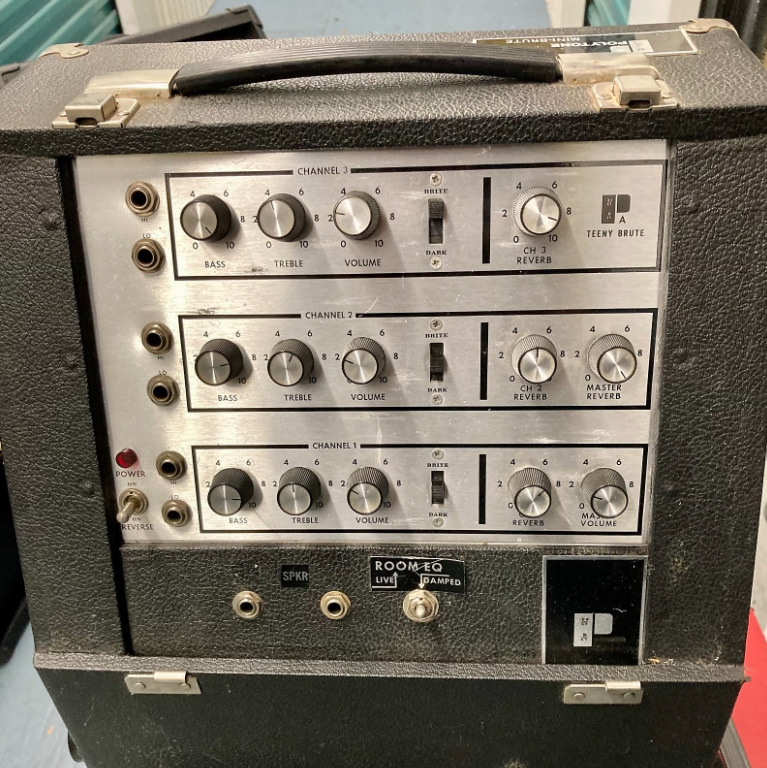 |
Each channel has the standard Bass, Treble & Volume control along with a Brite/Normal/Dark switch and Hi & Low inputs. Each channel also has its own Reverb level control. Notice the "Room EQ" switch, which has a Live and Damped setting. |
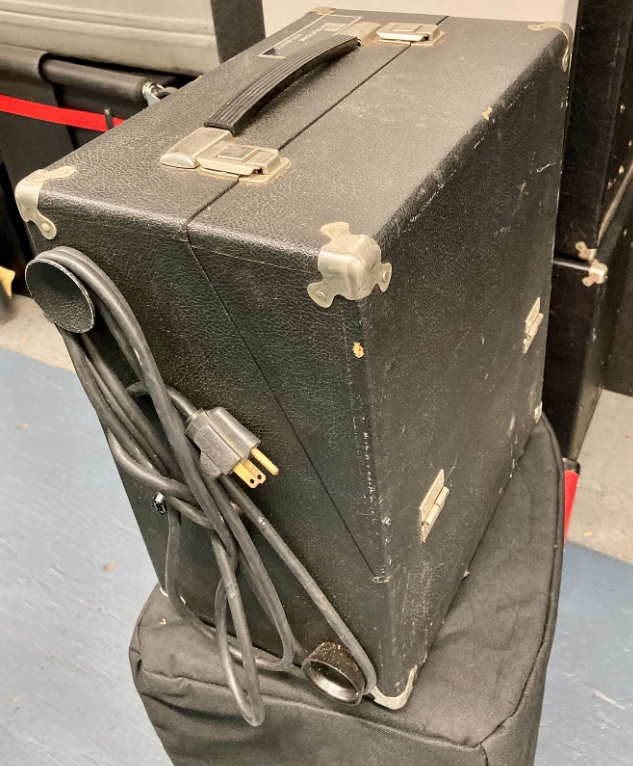 |
In this side view you can see how the front cover attaches to the case when everything is closed up. |
Mini Brute 2x10
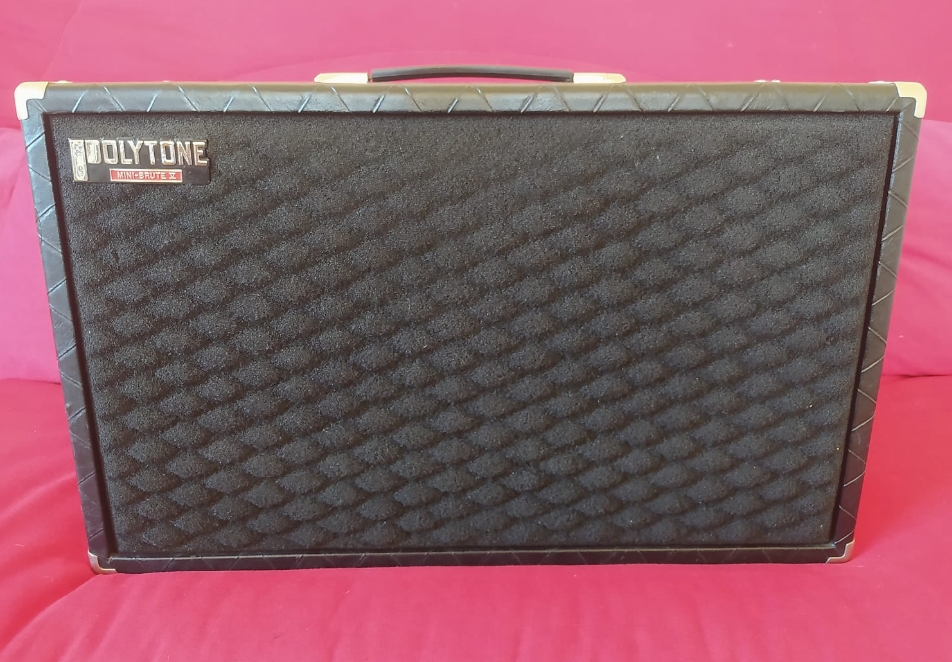 |
This looks like the Mini Brute at the top of this page but stretched out so a pair of 10" speakers could be fitted. This amp is a 2-channel affair with distortion and reverb. In terms of features, it's similar to the Model 102 version 1 shown below. |
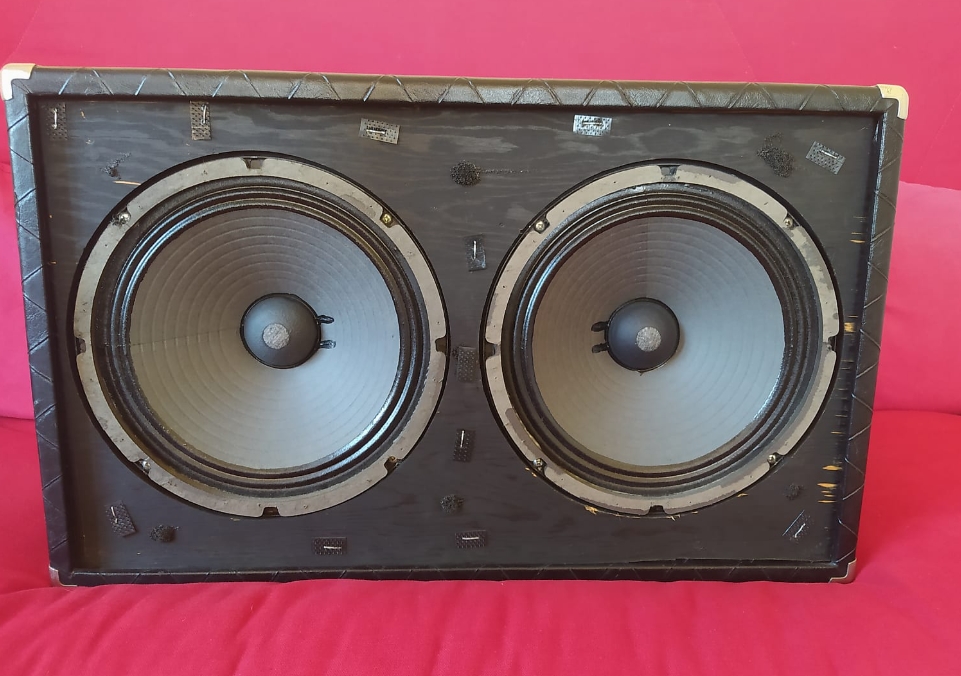 |
With the speaker cover removed you can see the two front loaded 10" speakers. |
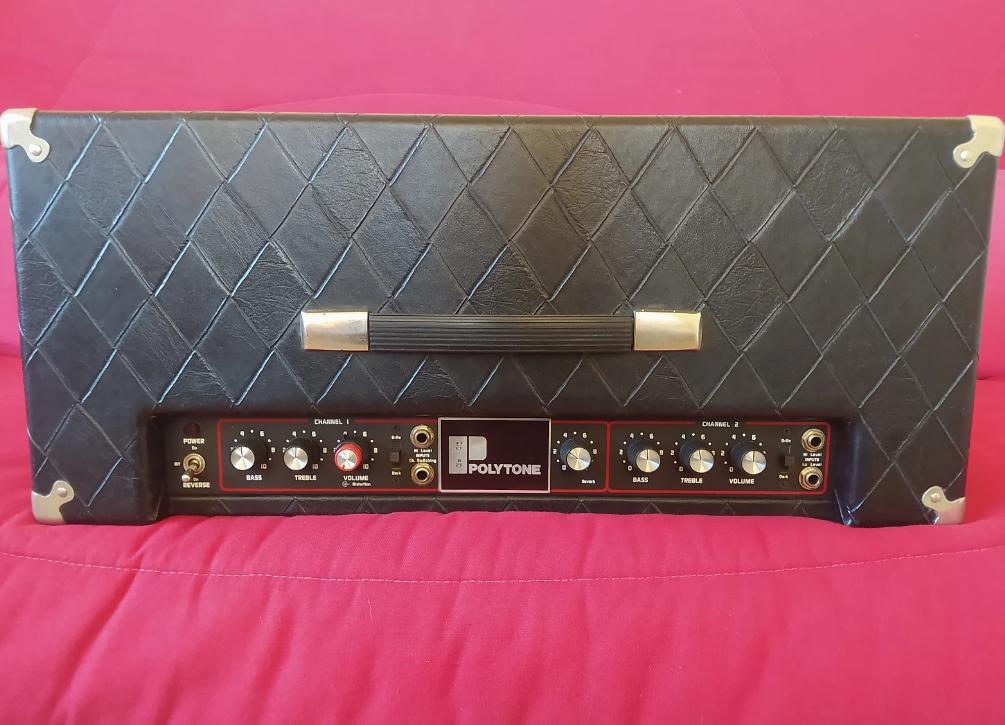 |
Here is the top view. It is essentially the same as the Model 102 version 1 shown below but with red & white graphics over black. The Polytone logo affixed to the middle of the chassis is curious. |
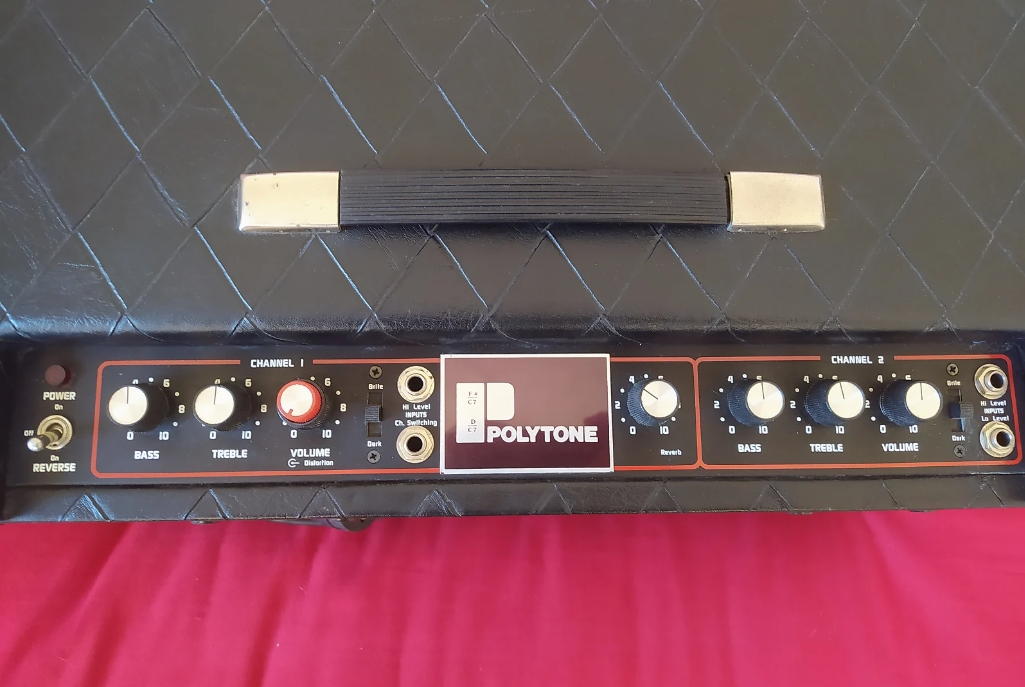 |
It appears that this logo was perhaps used to cover up a different model of chassis or to cover up a mistake. Your guess is as good as mine. |
 |
Channel 1 controls are the standard Bass, Treble, Volume plus Distortion Volume. There is no gain control for the distortion circuit. Has the usual Brite/Normal/Dark switch and Hi & Low inputs. |
 |
Channel 2 controls are the standard Bass, Treble and Volume. Also has the usual Brite/Normal/Dark switch and Hi & Low inputs. |
 |
With the back cover removed it's apparent that only half the PCB is populated. They used the same circuit board for multiple models and populated it as required for each model type. |
 |
One of the few things that seems to be consistent with Polytone amps is the circuit boards used. |
Mini-S12L
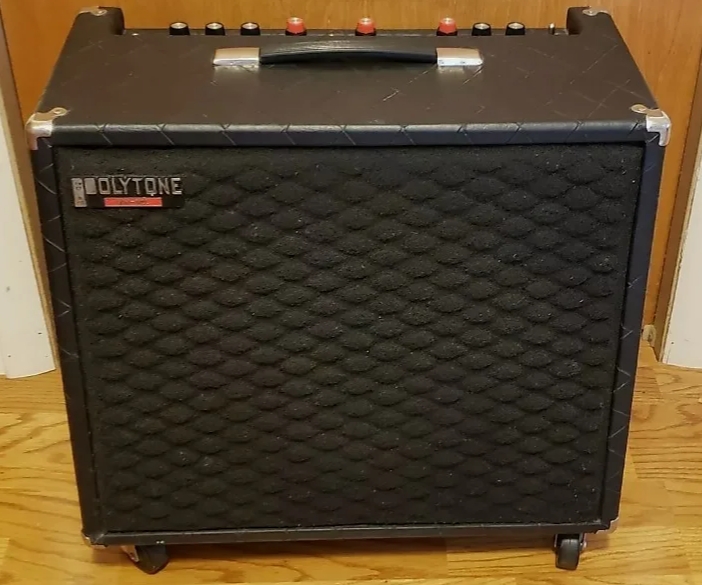 |
The Mini-S12L is a 1x12 combo amp that also has two horns, one in each upper corner. It has a power output of 75 watts. It has the same features as the 2x10 Mini Brute above. Has the same diamond pattern vinyl covering on the cabinet and the diamond pattern foam speaker cover as well. |
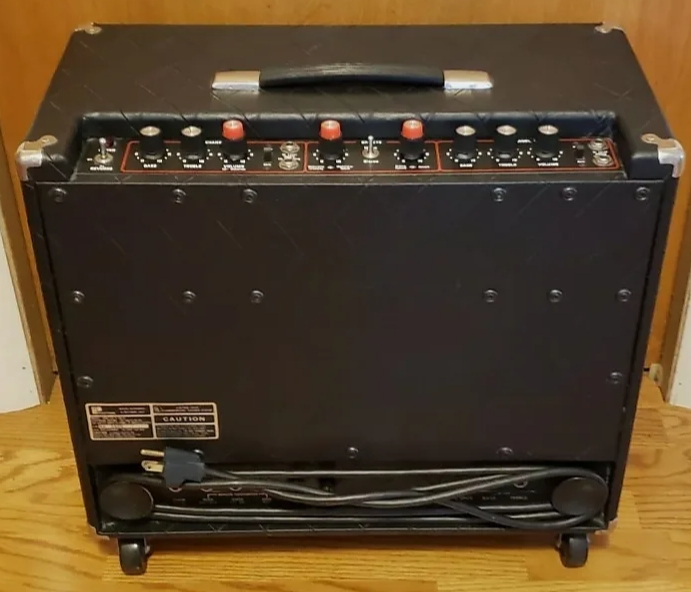 |
The back of the amp looks very similar to the Model 101, 102 103 & 104. |
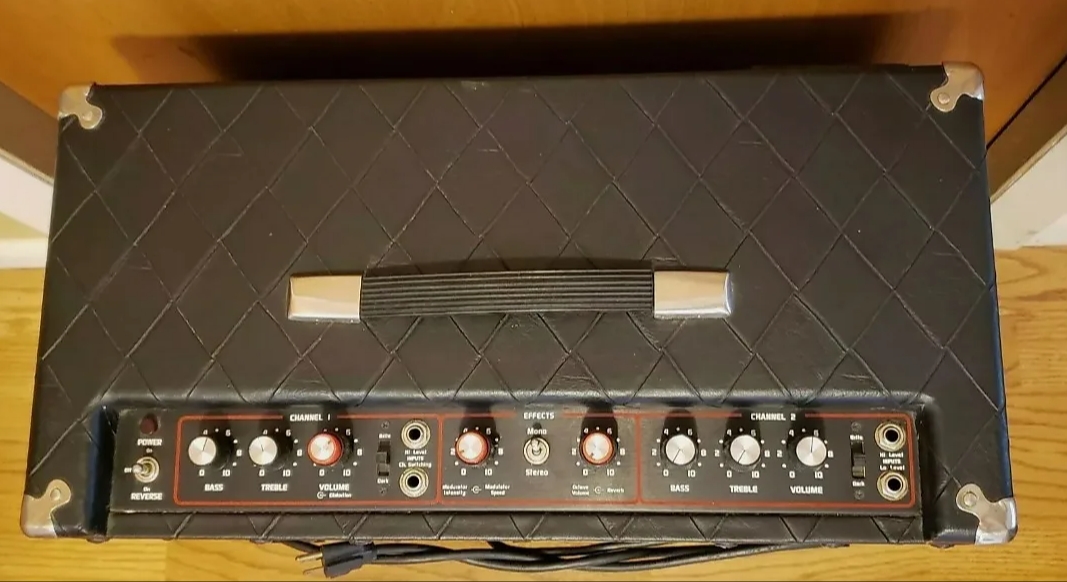 |
Here is a top view. Features are similar to a few other Polytone amp models. |
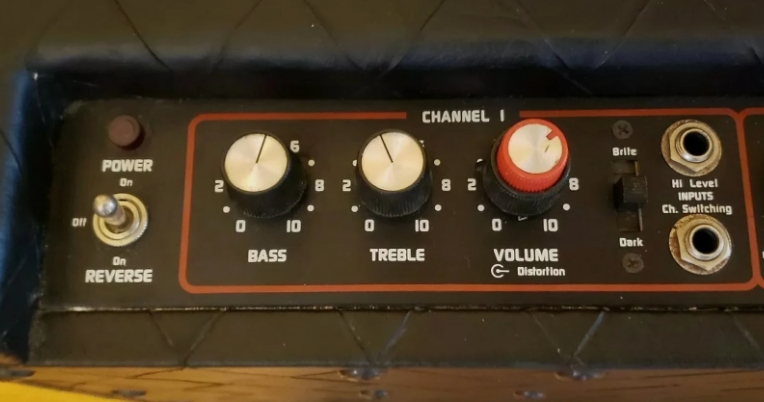 |
Channel 1 controls are the standard Bass, Treble, Volume plus Distortion Volume. There is no gain control for the distortion circuit. Has the usual Brite/Normal/Dark switch and Hi & Low inputs. |
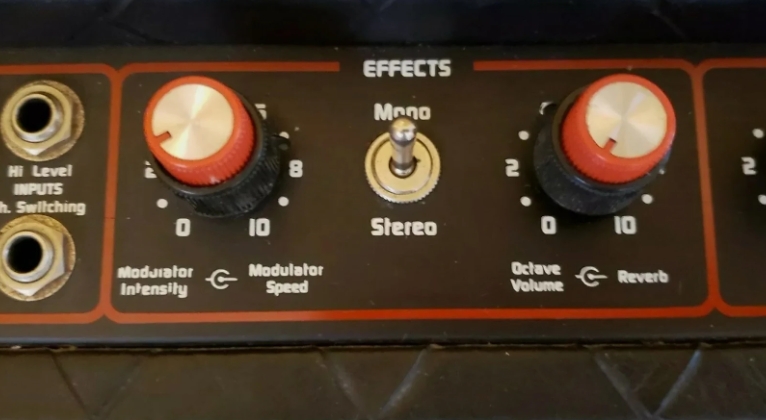 |
The Effect section has controls for Modulator Intensity & Speed, Distortion & Boost level Master Volume and Reverb. This is essentially the same as what can be found on the Taurus I. |
 |
Channel 2 controls are the standard Bass, Treble and Volume. Also has the usual Brite/Normal/Dark switch and Hi & Low inputs. |
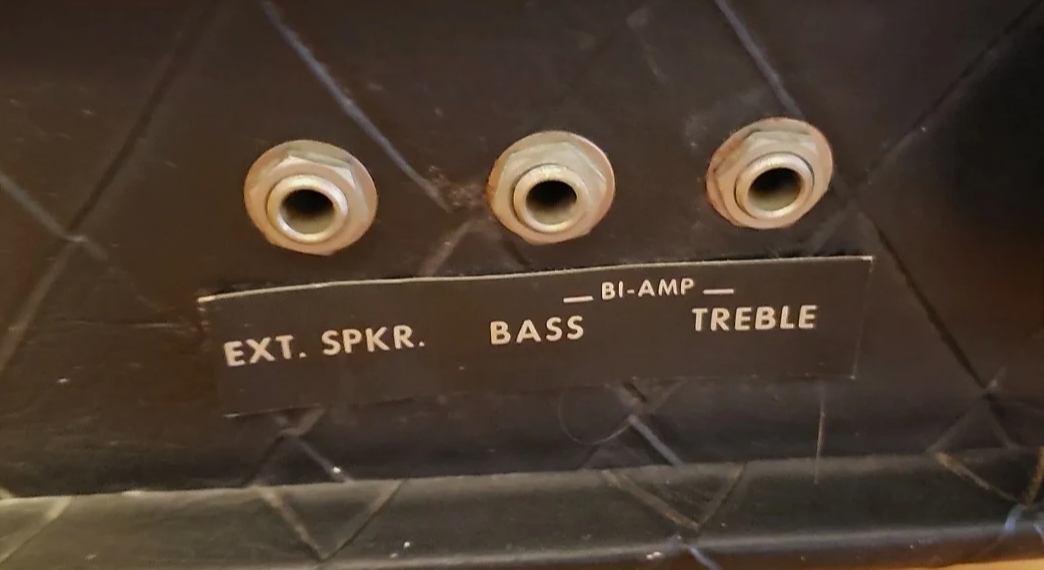 |
On the rear at bottom left there are jacks for External Speaker and Bi-Amp Hi & Low Outputs. |
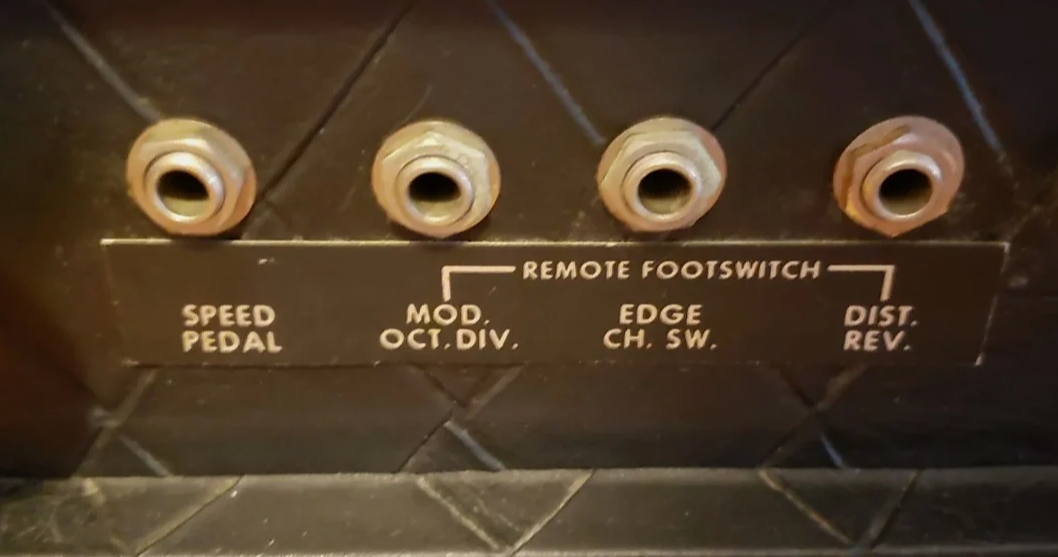 |
On the rear at bottom right are jacks for Speed Pedal, Modulator/Octave Divider, Edge/Channel, Reverb and Distortion. |
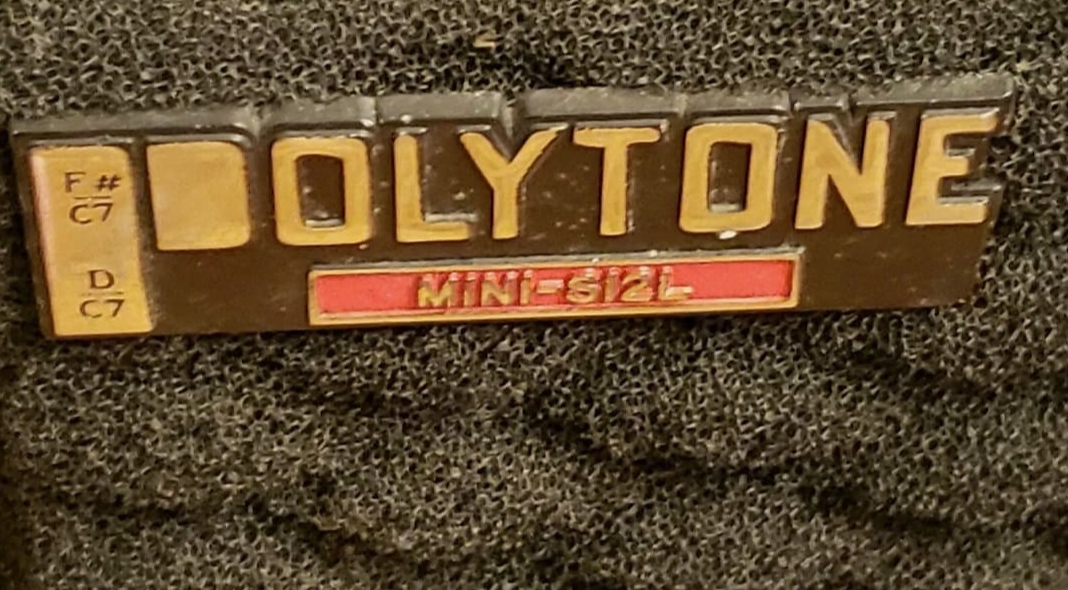 |
Close up of the name plate in the upper left corner on the front of the amp. It appears that all of the amps with this styling had the same type of name plate badge with the amp's model name on it. |
Mini-S15L
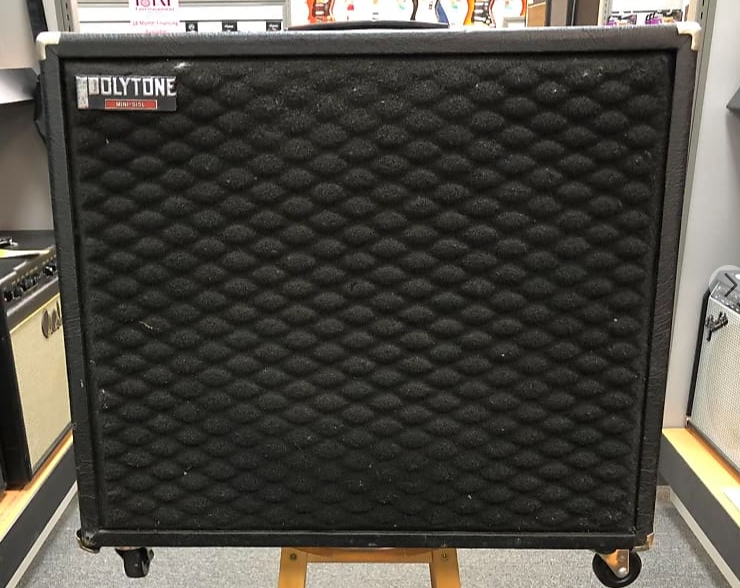 |
The Mini-S15L is a 1x15 combo amp with a power output of 75 watts. It has the same features as the Mini-S12L above. It also has the same diamond pattern vinyl covering on the cabinet and the diamond pattern foam speaker cover. |
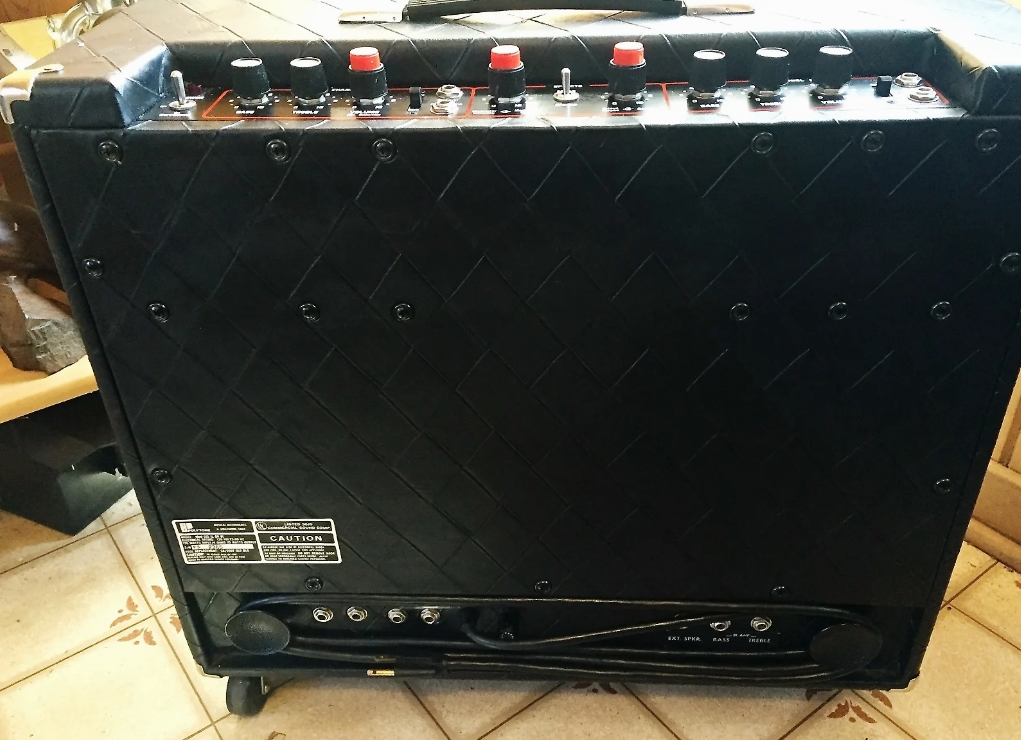 |
The back of the amp is same as the Mini-S12L and looks very similar to the Model 101, 102 103 & 104. |
 |
Here is a top view. Features are same as the Mini-S12L above. |
Model 212-300 & Model 215-300
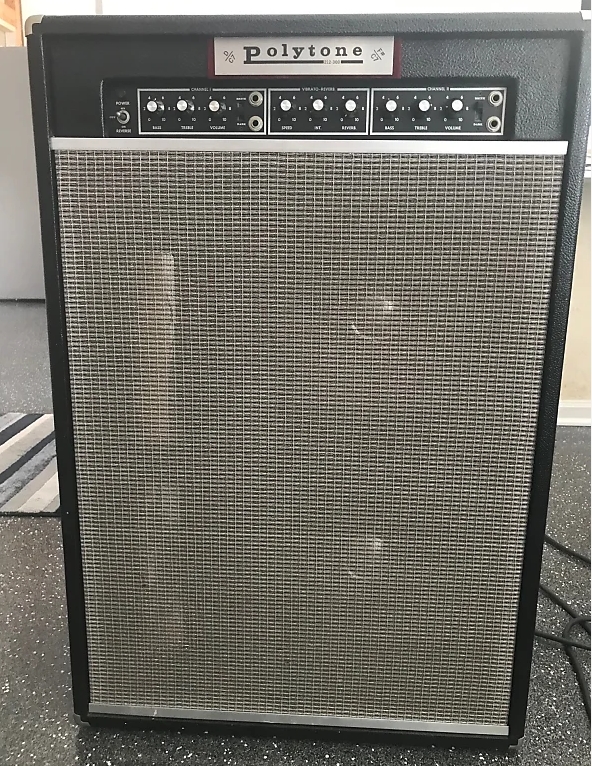 |
The model 212-300 is a 2-channel 110 watt amp with a pair of 12" speakers in a tall cabinet. The model 215-300 is the same amp but with a pair of 15" speakers. I believe these were intended for use with bass guitar but they seem to also work OK for guitar. |
 |
Here is the 212-300 with the back removed. |
 |
Channel 1 has the classic Polytone control scheme of Bass, Treble and Volume. Hi & Low input jacks and a Brite/Normal/Dark switch. |
 |
In the center of the chassis is controls for the Vibrato (Speed & Intensity) and a Reverb level control. |
 |
Channel 2 is same as Chanel 1 with Bass, Treble and Volume. Hi & Low input jacks and a Brite/Normal/Dark switch. |
Model 100
 |
The Model 100 is a two channel 1x15 bass amplifier. Each channel has a Bass, Treble and Volume control with Hi & Low inputs. Power output is 90 watts. On the back there is a Room EQ switch with on and off positions. |
Model 101
 |
With the Model 101 we get into amps with a larger format. This amp has two channels and was intended to be a bass amplifier. Output power is 180 watts and it has an interesting speaker arrangement of 1x12 & 2x8, three speakers in total. Note the casters. These larger Polytones are heavy enough to justify having casters on the cabinet. The foam speaker cover has somehow survived. Output power is 180 watts. |
 |
With the foam speaker cover removed we can see the speaker arrangement. The foam is held in place with plastic strips that have pokey things that stick into the foam. The speakers are protected by something akin to the screen on a screen door which is glued to the surround. They used this method seemingly on most of their amps. Kinda crude and some may say cheap, but it seems to work OK. |
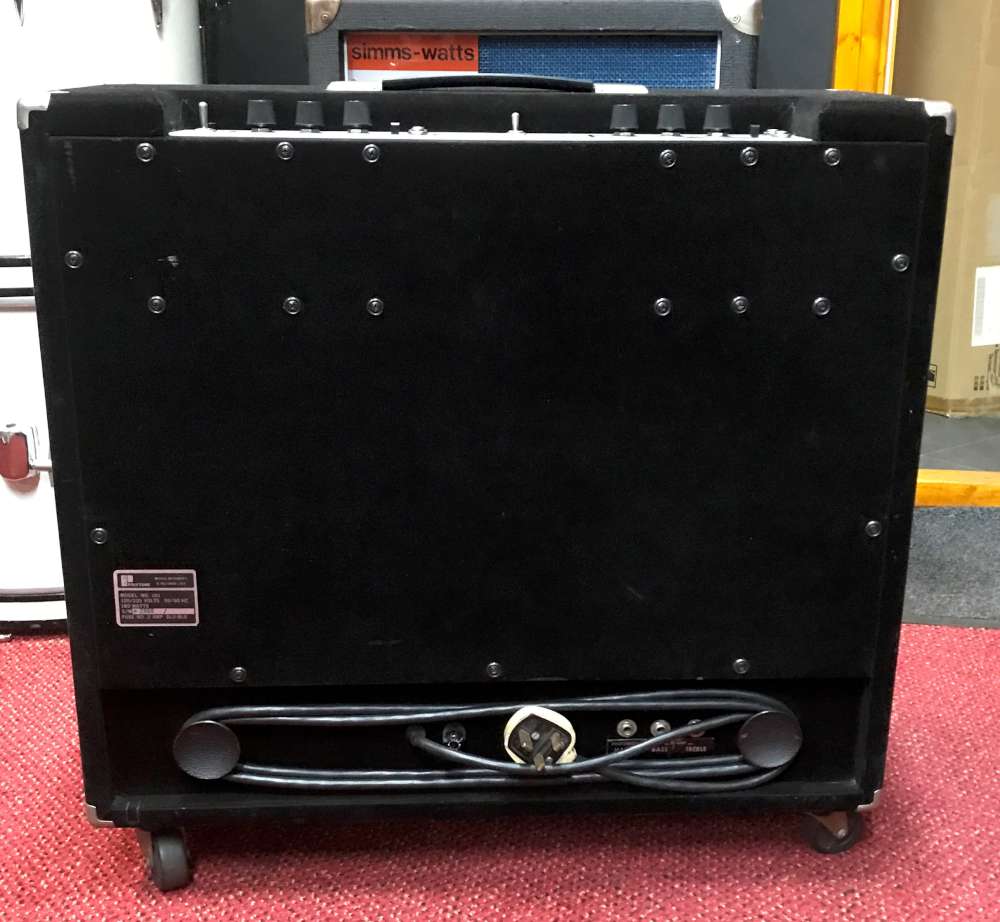 |
Here we can see the back. At the bottom we can see a variety of jacks for the foot switch that would have been used with this amp. The Model 10-something series seems to have introduced and velvety covering on the cabinet that Polytone called "Soft Touch". From what I can tell, these amps in this series were made in the late-70s up to something like 1981. |
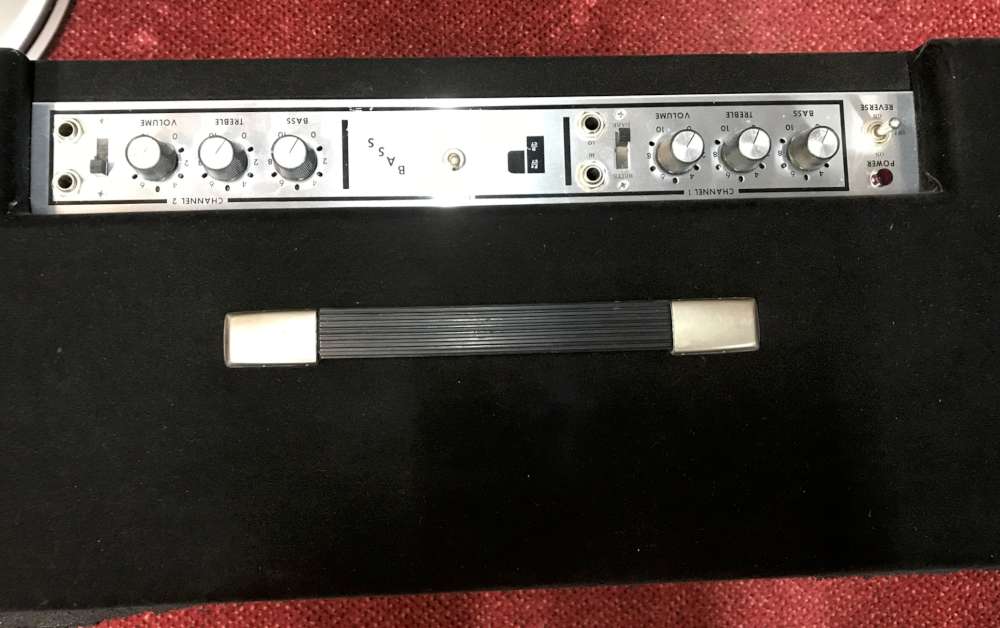 |
Here is the top. With this amp we have the black graphics on a bare aluminum chassis. |
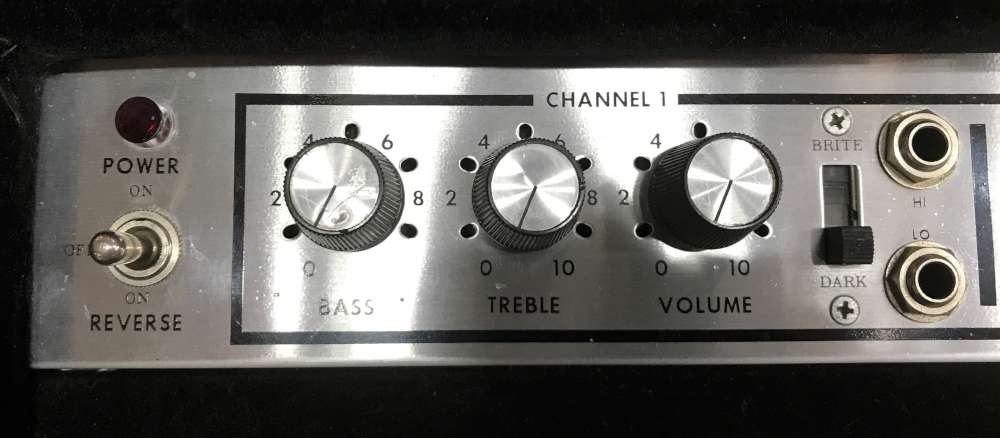 |
Channel 1 controls are Bass, Treble and Volume with the customary Hi & Low inputs and a Brite/Normal/Dark switch. |
 |
Channel 2 controls are same as Channel 1. In the middle is a Stereo/Mono switch. Some Model 101s will have "Custom Bass Amp" in this middle area between channels and no switch. These would be the mono only version. |
 |
Here is a peek inside the chassis. It appears this chassis and PCB were used in all of the Model 10-something amps. |
 |
Looking in the back of the enclosure, we can see the 15" speaker at right. |
 |
As with all of Polytone amps, the power amp is mounted on the bottom of the cabinet. |
Model 102 (version 1)
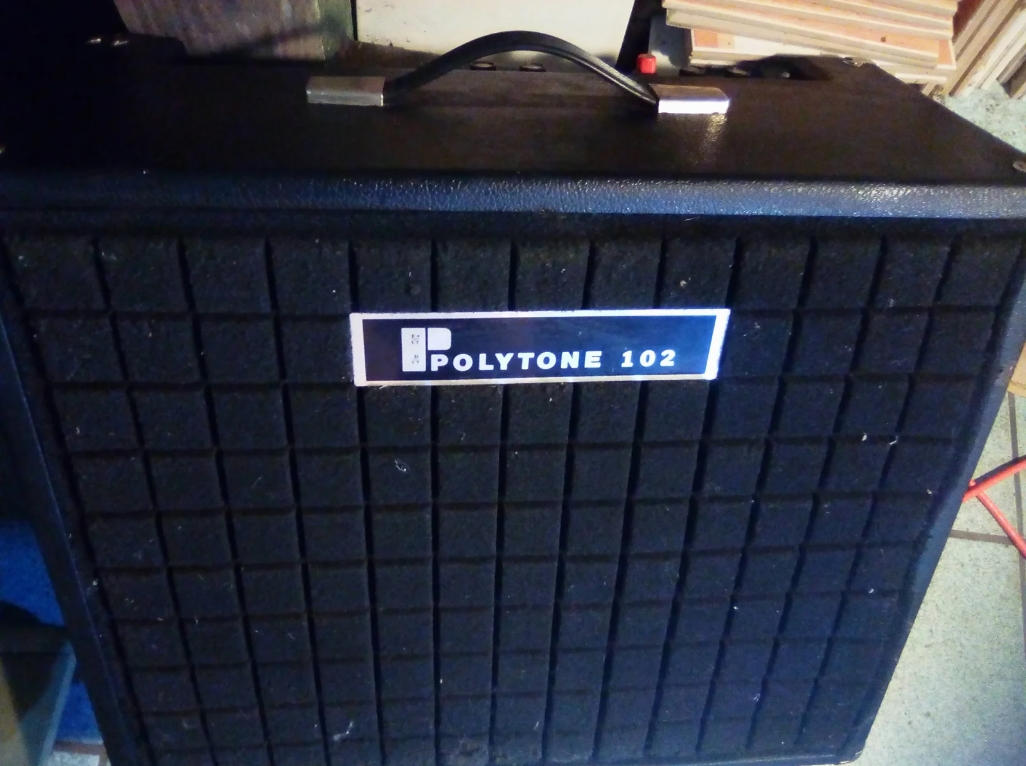 |
The Model 102 is a little confusing. There are two different Model 102s. In this example we have a 1-channel amplifier that features tremolo and reverb. Here we can see an entirely different sort of foam speaker cover from the diamond pattern types shown farther up on this page. This amp also uses a 1x12 & 2x8 speaker configuration like the Model 101 but is designed for guitar. Output power is 180 watts. |
 |
The back of the amp follows the format from this time period. Note that this amp has a Tolex-like covering instead of the "soft touch" type on the Model 101. At lower right are the foot switch jacks and a "Room EQ" switch. |
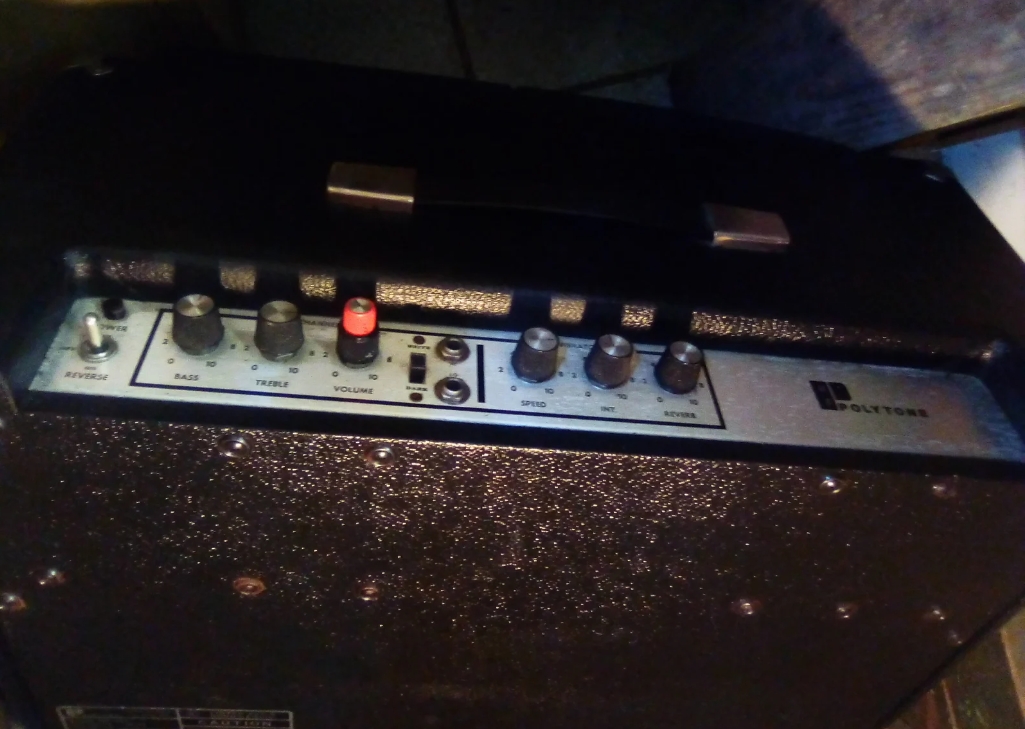 |
A view of the chassis. Controls from left to right are Bass, Treble, Volume, Speed, Intensity and Reverb. |
Model 102 (version 2)
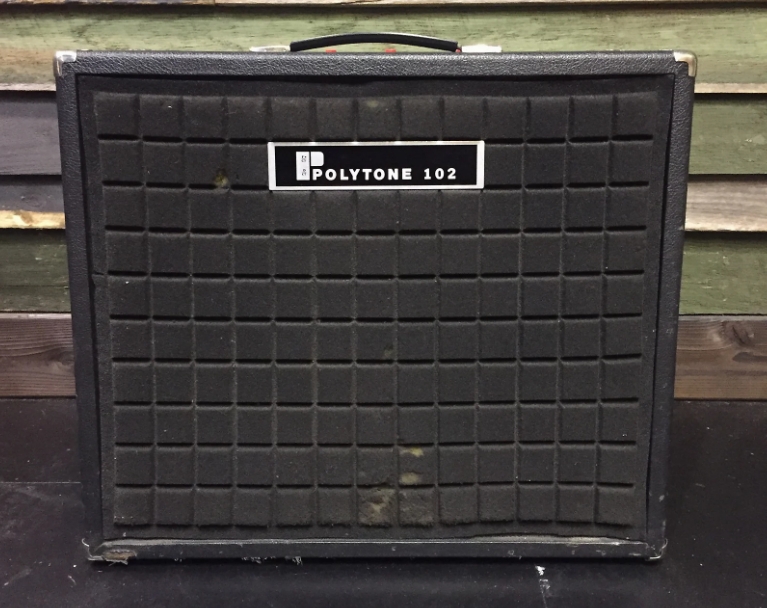 |
Here is another version of the Model 102. It is similar to the Model 102 directly above but instead of the tremolo it features a Harmonic Divider and Octave Divider circuit, plus there is a Distortion circuit (which only has a volume control). Output power is 180 watts. The Harmonic Divider is pretty cool... sort of like an electronic vibrato. It's hard to describe but it can sound pretty nice! |
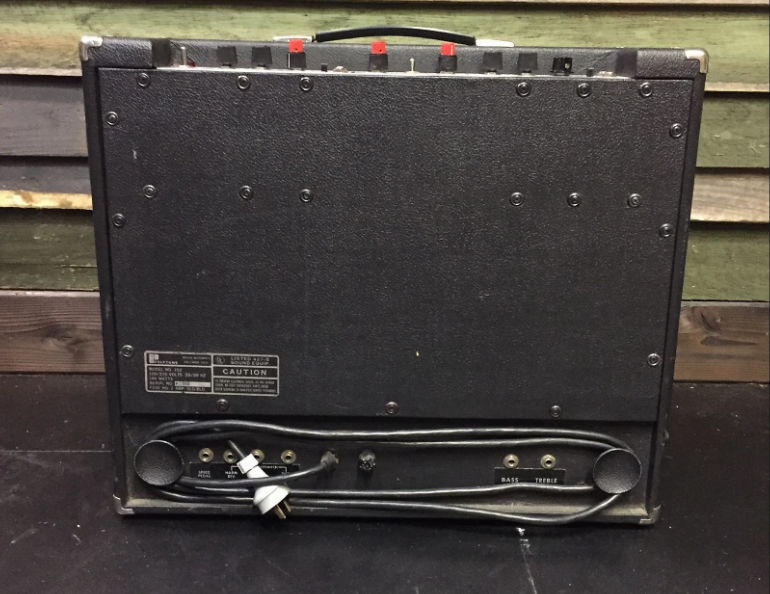 |
Back is similar to the Model 102 above but the footswitch jacks have been moved to the left, the Room EQ switch has been deleted and there is the addition of two Bi-Amp jacks at lower right. |
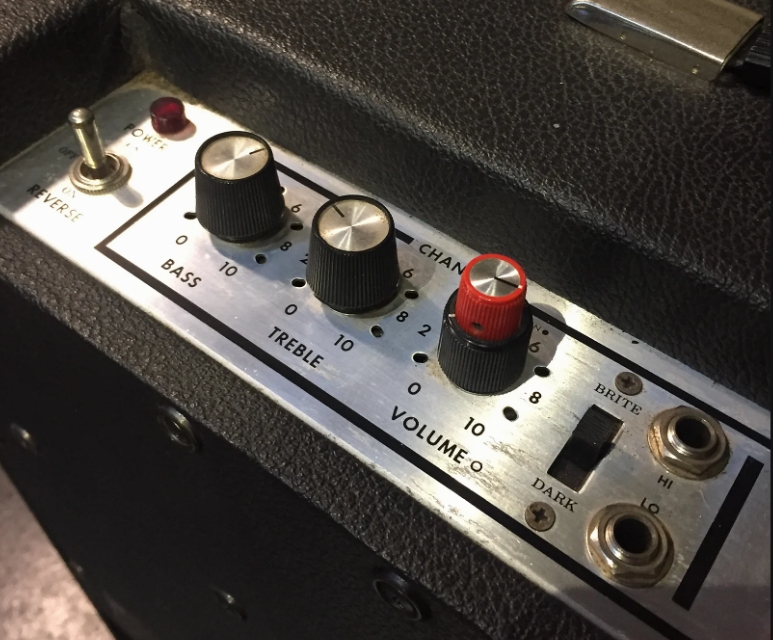 |
Channel 1 controls are Bass, Treble, Volume and Distortion Volume. |
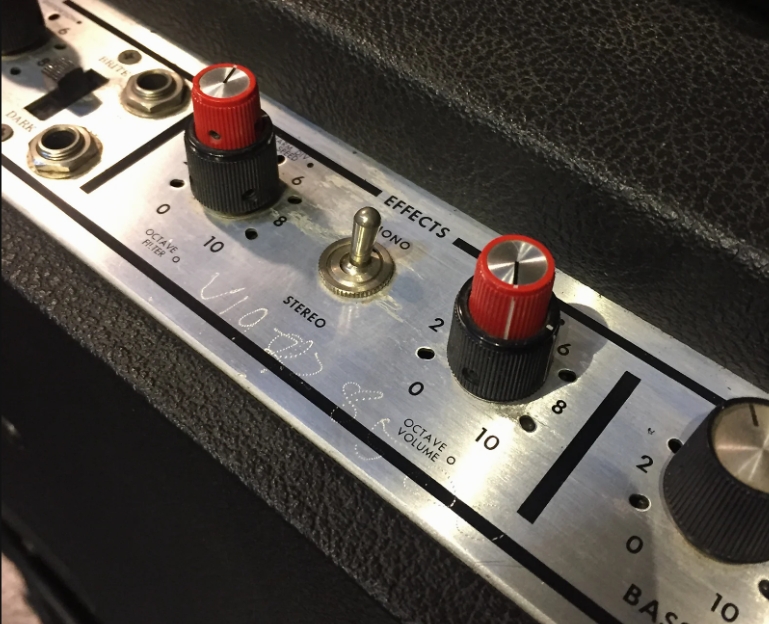 |
The Effects section has Harmonic Divider Speed, Octave Filter, Octave Level and Reverb. There is also a Mono/Stereo switch. |
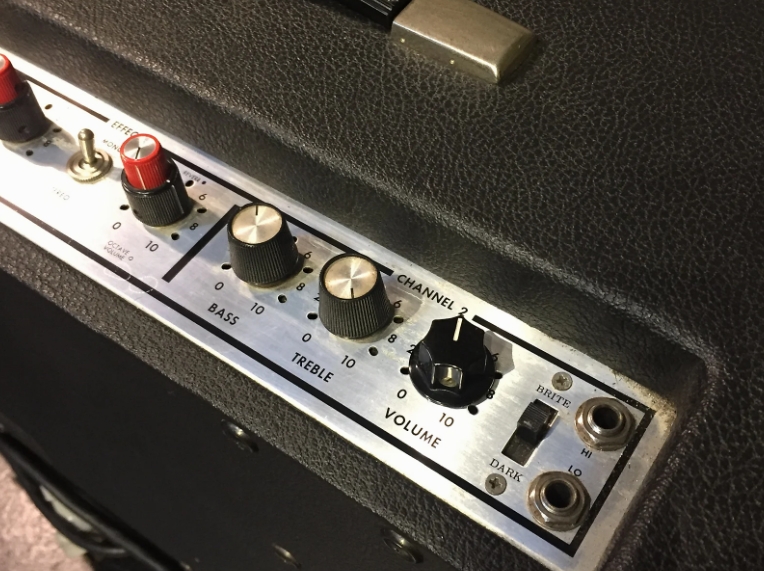 |
Channel 2 controls are Bass, Treble and Volume. Channel 2 does not have any reverb or effects. |
Model 103
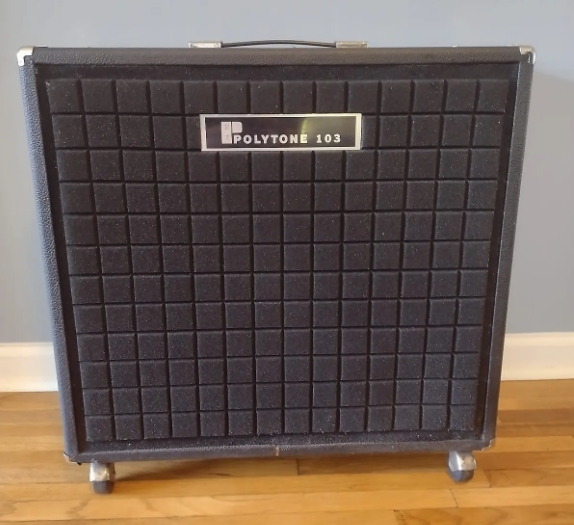 |
The Model 103 appears to the same as the Model 102 version 1 above, with the addition of a second channel and a distortion circuit on Channel 1. Output power is 180 watts. |
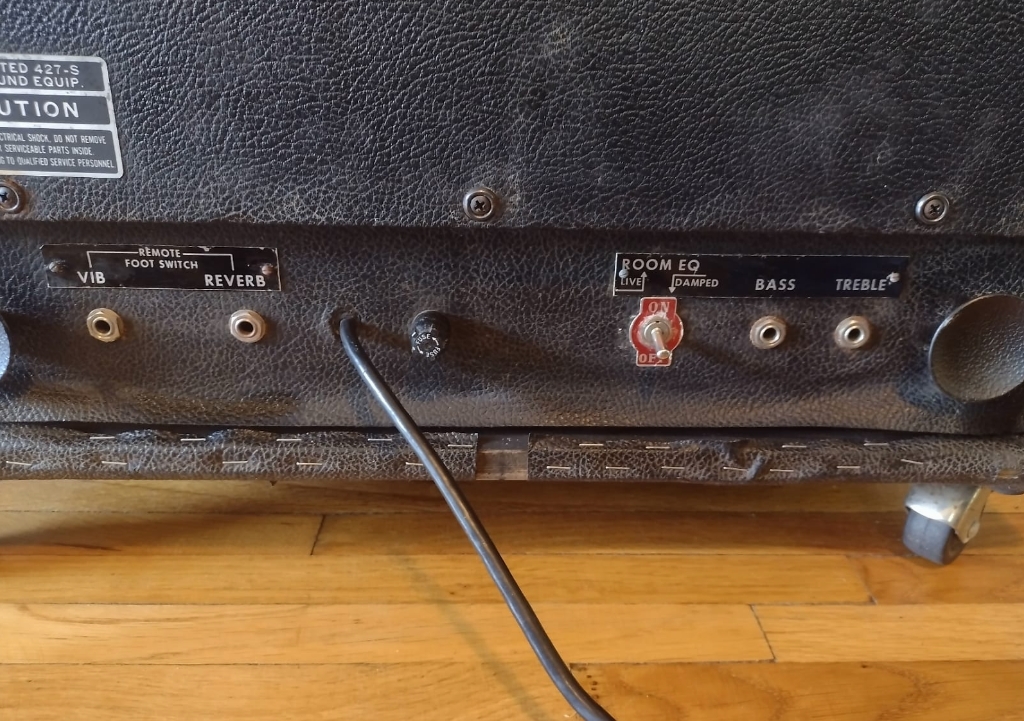 |
The back looks pretty much the same as the Model 102. Here you can a little better view of the "Room EQ" switch. You can also see that this amp has the Bi-Amp feature. |
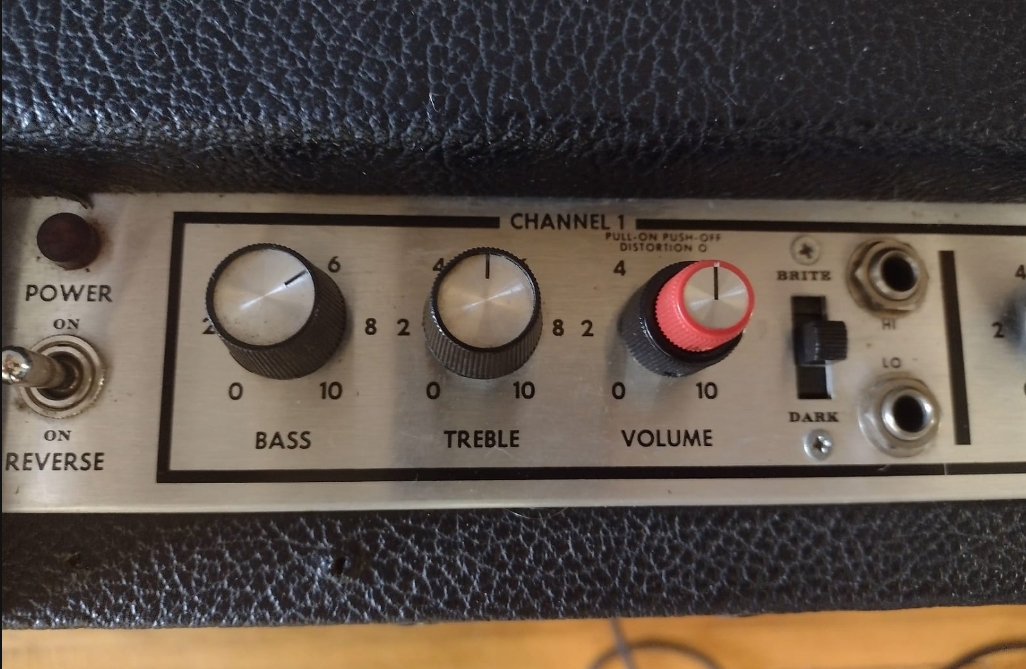 |
Channel 1 controls are Bass, Treble, Volume and Distortion Volume. |
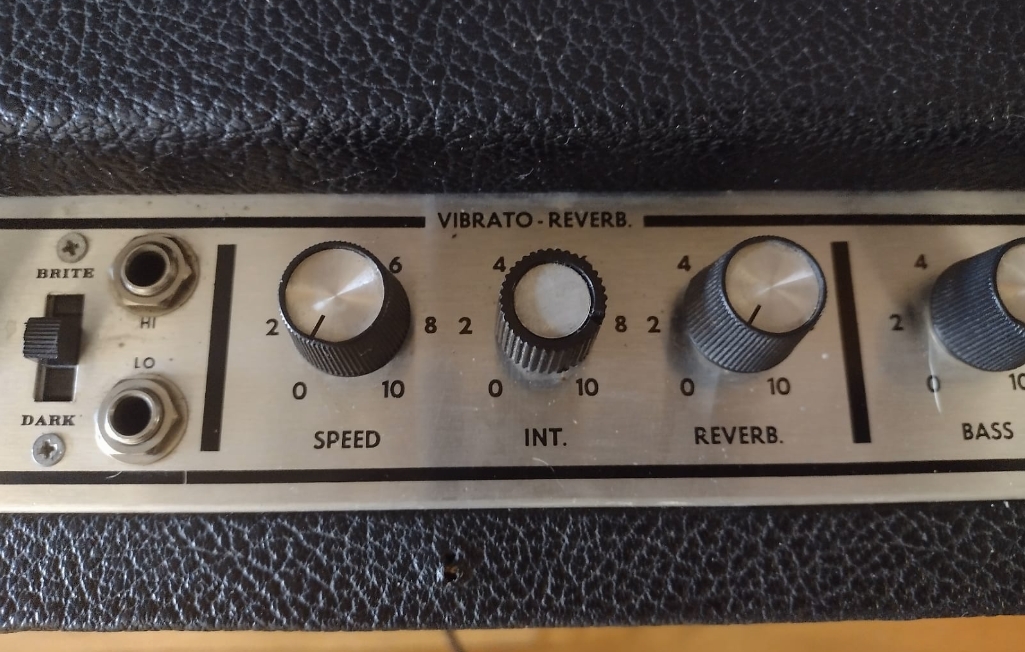 |
Here is a view of the tremolo Speed & Intensity controls with the Reverb control to the right. |
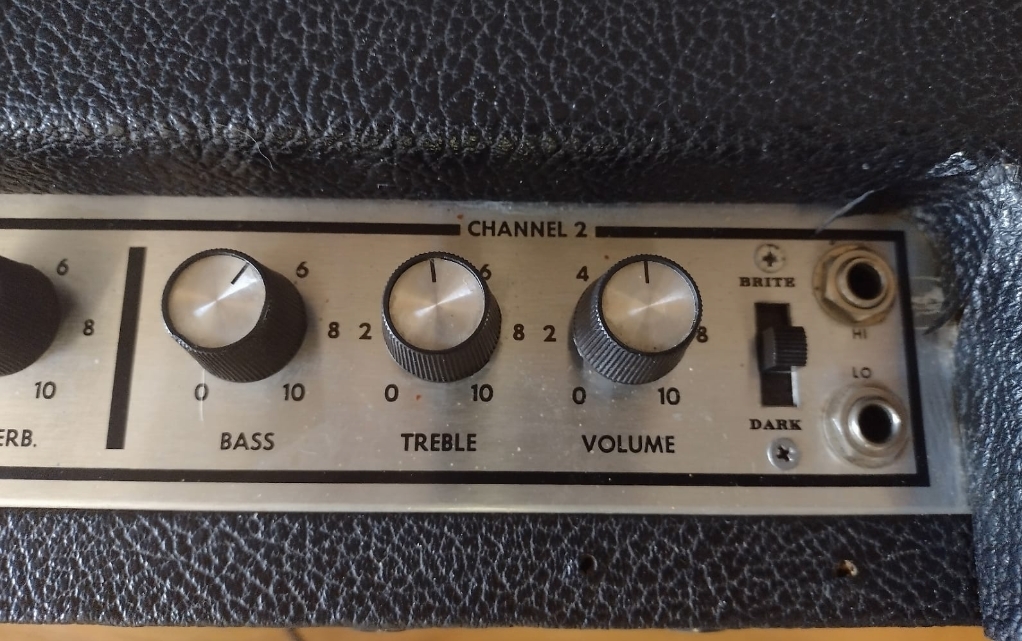 |
Channel 2 controls are Bass, Treble and Volume. |
Model 104 (2x12)
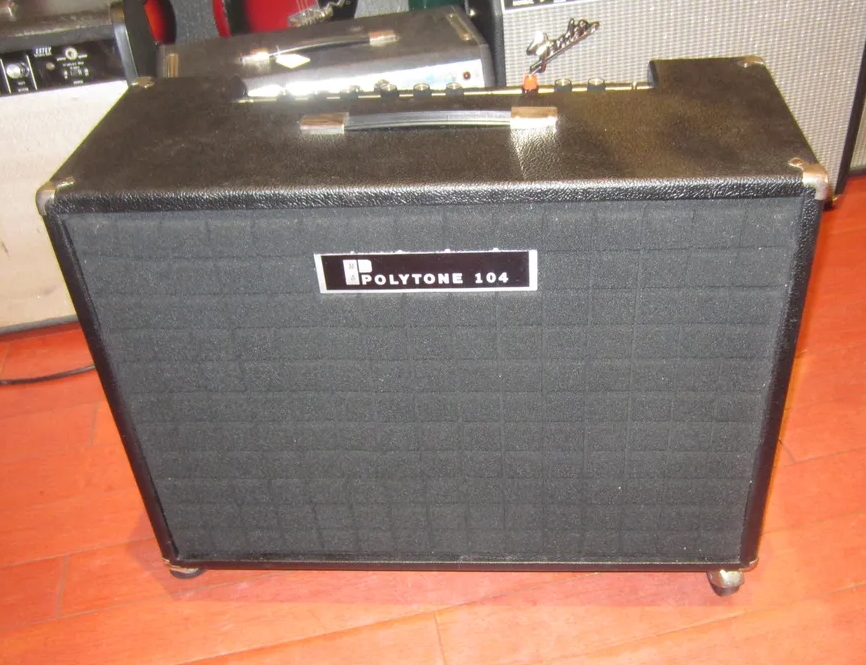 |
The Model 104 (2x12) seems to be the Model 103 with two 12" speakers. I believe this might have been the model that George Benson used on the tune called Breezin', which seems have been a big boost for Polytone sales. George discusses this amp a little bit in his 2024 interview with Rick Beato. He said something along the lines of it sounded beautiful. |
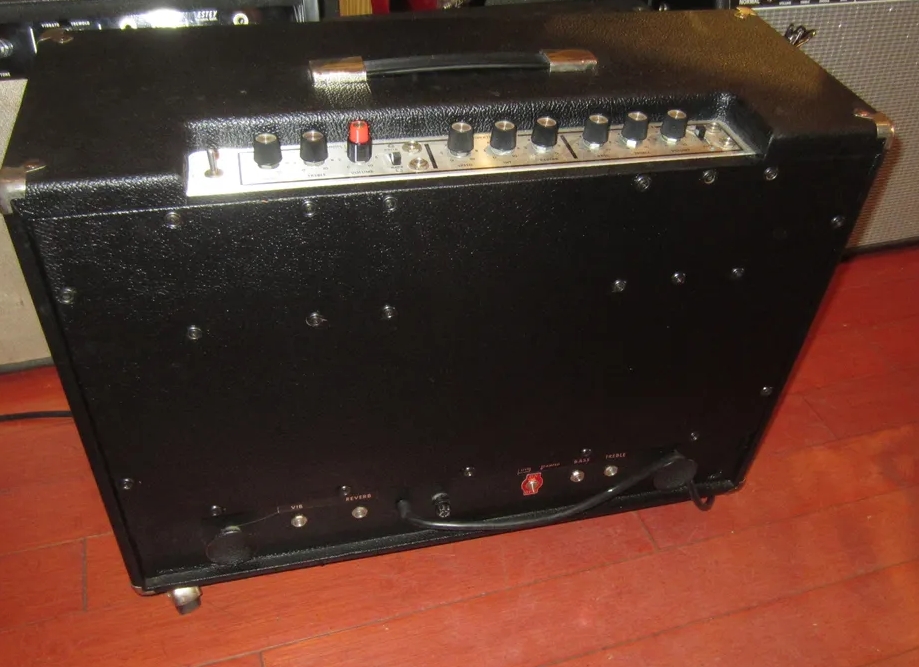 |
A view of the back. This example is covered in soemthing similar to Tolex. |
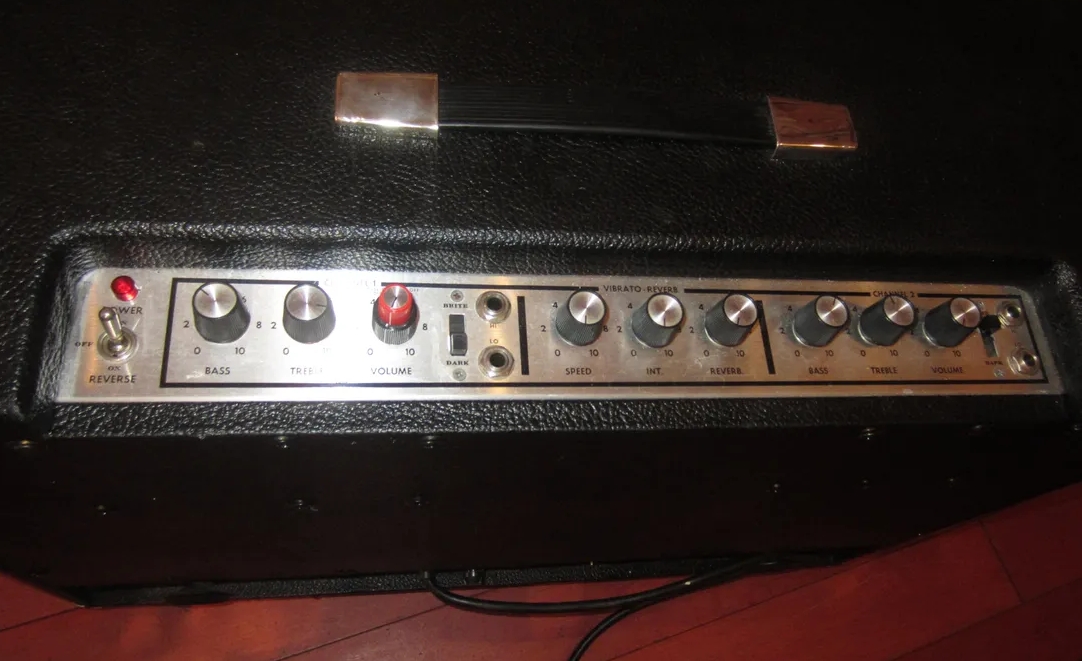 |
Controls are virtually identical to the Model 103. |
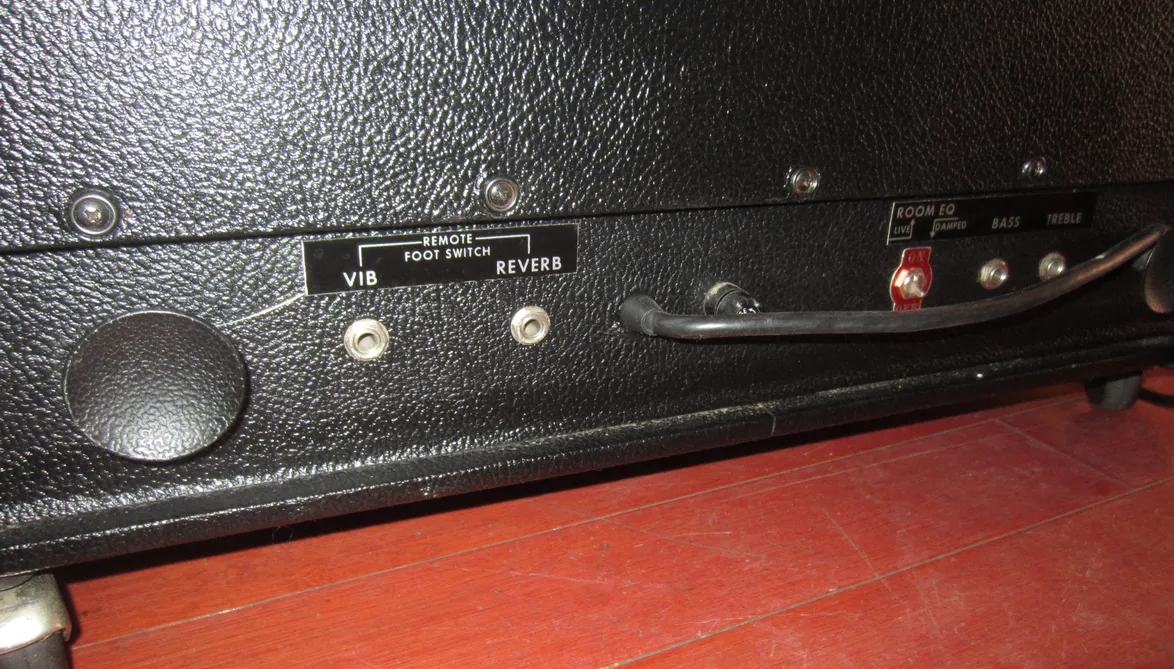 |
The foot switch jacks and Room EQ switch are pretty much the same as the Model 103. |
Model 104 (4x10 "Maxi-Brute")
 |
Here is the Model 104 (4x10). Polytone called this one the Maxi-Brute. This amplifier has four 10" CTS speakers and the same features as the Model 102 version 2 above. Note that here we seem to have the introduction of a grey covering on the speaker baffle. The orginal speaker covering is missing unfortunately. I suspect it was the foam type with the square pattern. |
 |
Here we can see the back. This example has the "soft touch" velvet-like covering on the cabinet. On the back are jacks for the Harmonic Divider (Hi & Lo), Octave Divider (Hi & Low), Rev/Dist and a pair of jacks for the Bi-Amp feature. Some functions of the amp are available only if you have a foot switch to engage them. |
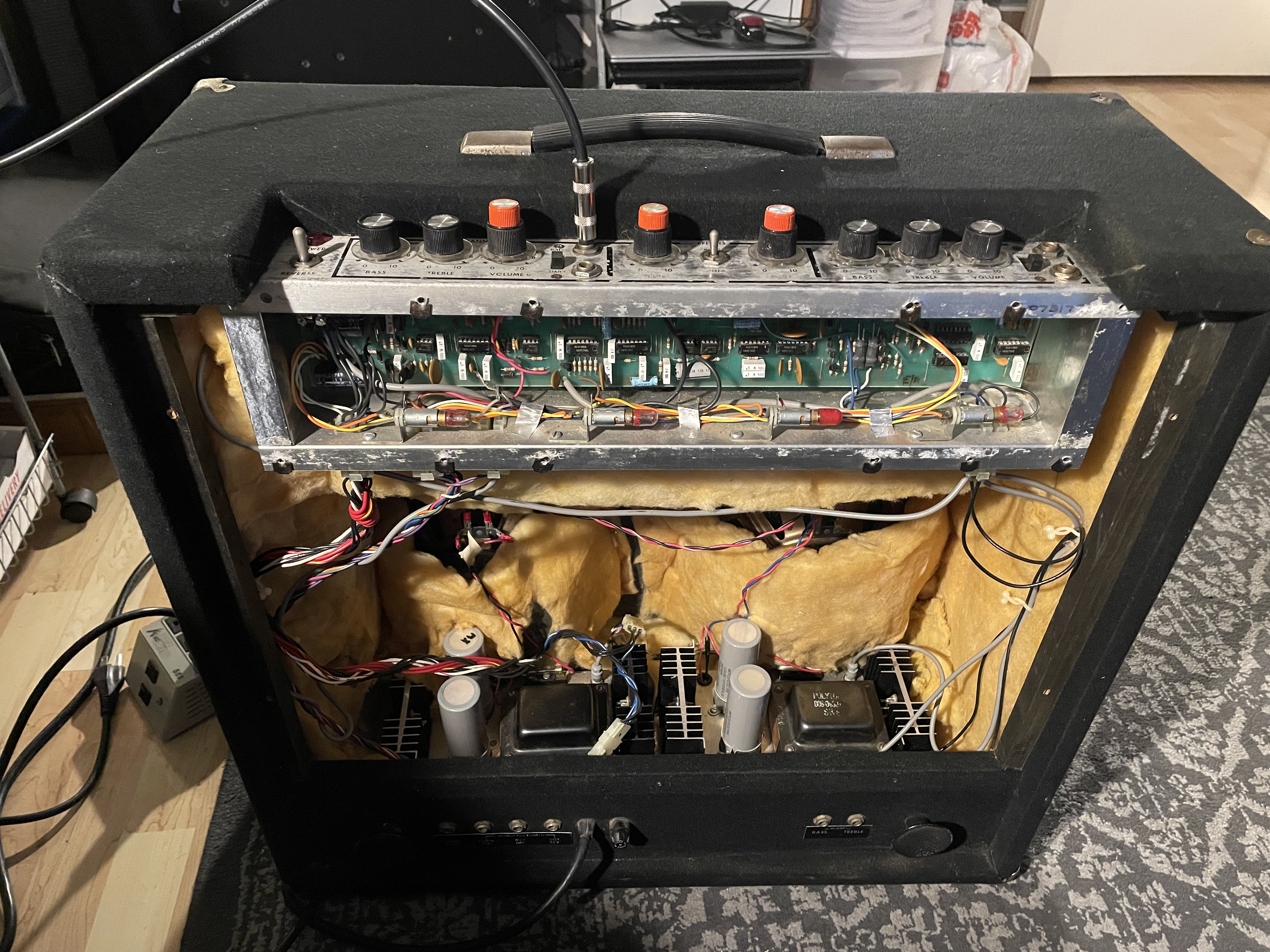 |
With the back cover removed we can see the chassis and pair of power amps at the bottom. This example has the PA-378 power amps in it. |
 |
Control panel is the same as the Model 102 version 2 above. |
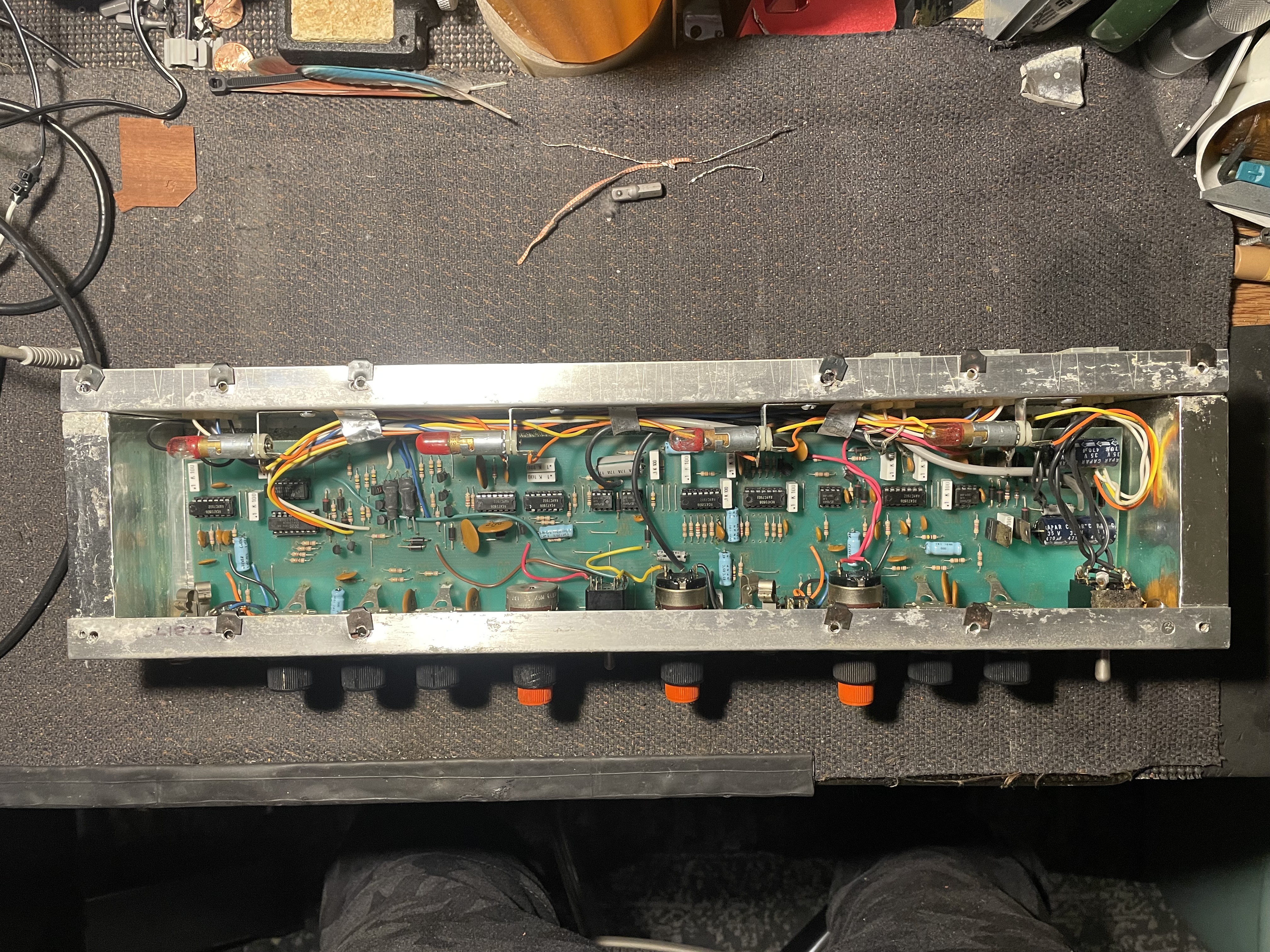 |
A view of the chassis removed from the cabinet. |
Taurus I (2x10)
 |
The Taurus is a departure from the form factor of the amps shown up to this point. It has the controls on the front of the amp, has two channels and utilizes a more conventional speaker grille cloth. It has two 10" speakers and an output power of 125 watts. |
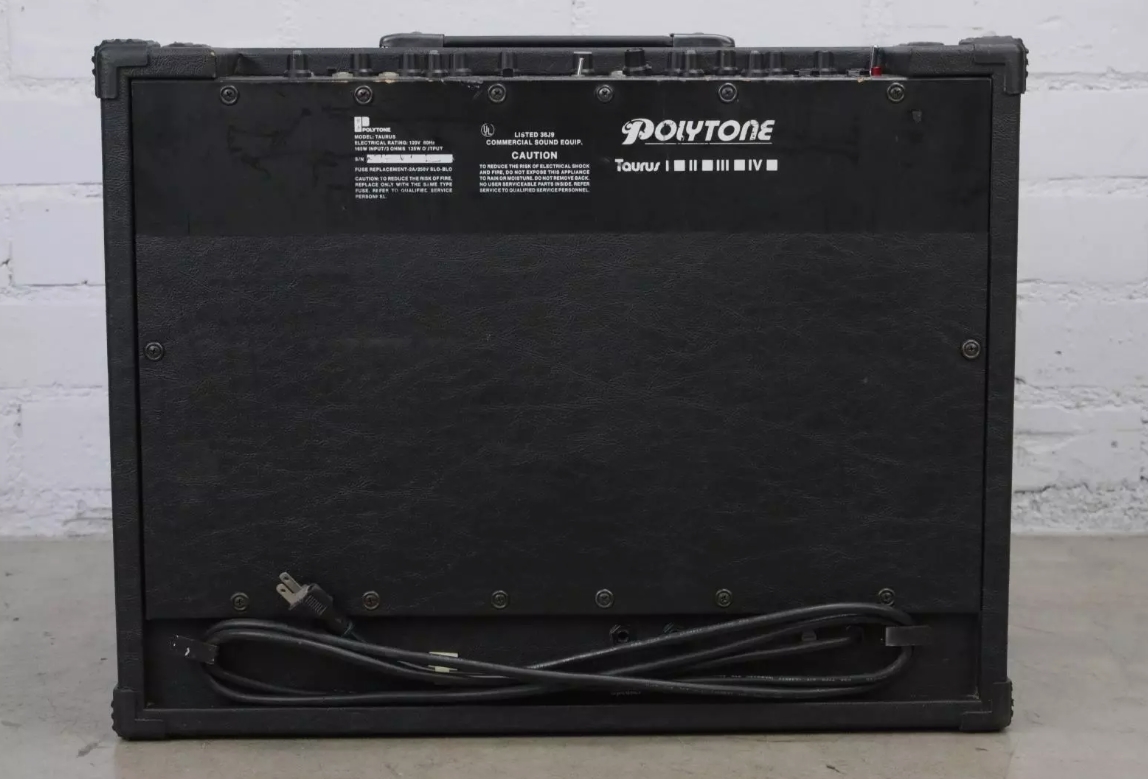 |
The back of the amp has a similar format to some of the Mini Brute models at the top of this page. |
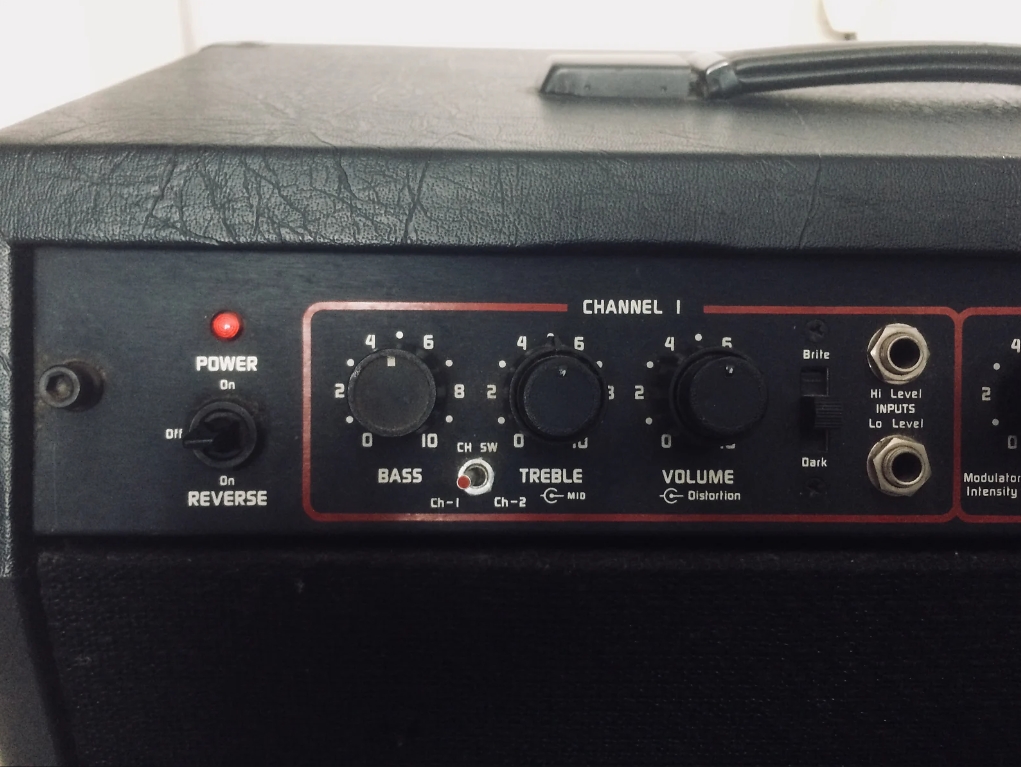 |
Channel 1 controls are the conventional Bass, Treble and Volume but with a Mids control added. It also has the usual Brite/Normal/Dark switch and Hi & Low inputs. There is a Channel 1/Channel 2 switch. Not sure what the function of that is. |
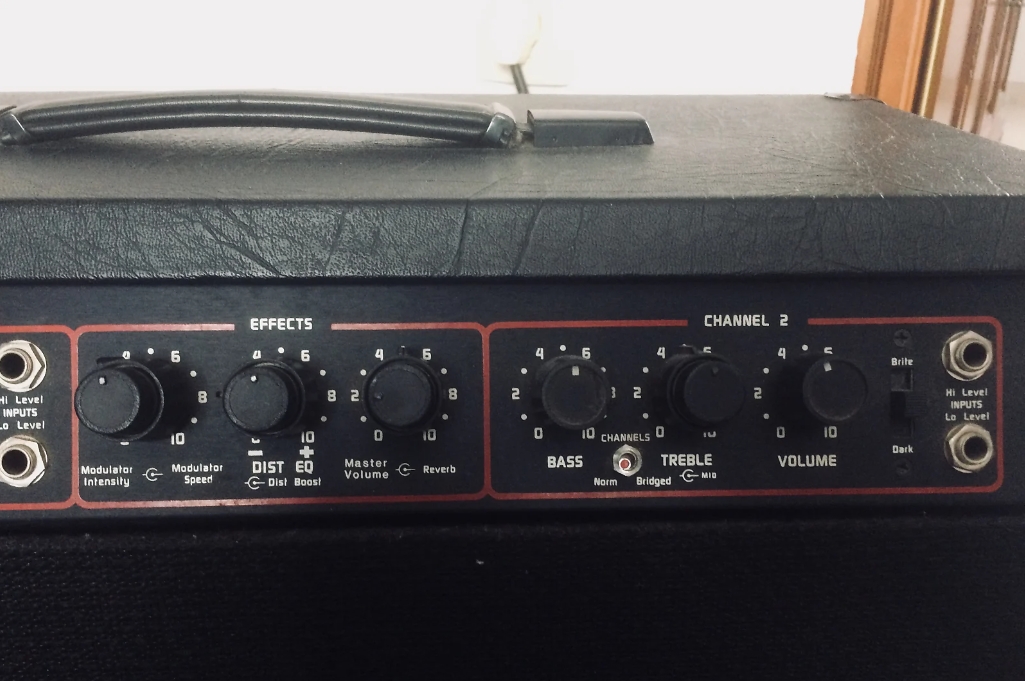 |
Channel 2 controls are same as Channel 1. The Effect section has controls for Modulator Intensity & Speed, Distortion & Boost level Master Volume and Reverb. |
 |
On the back of the amp there are jacks for Main Out, Bi-Amp Bass & Treble, a Guitar/Keyboard switch, a Channel 1/Channel 2 switch, and an Effects Loop with Send & Return with a pair of Volume controls. |
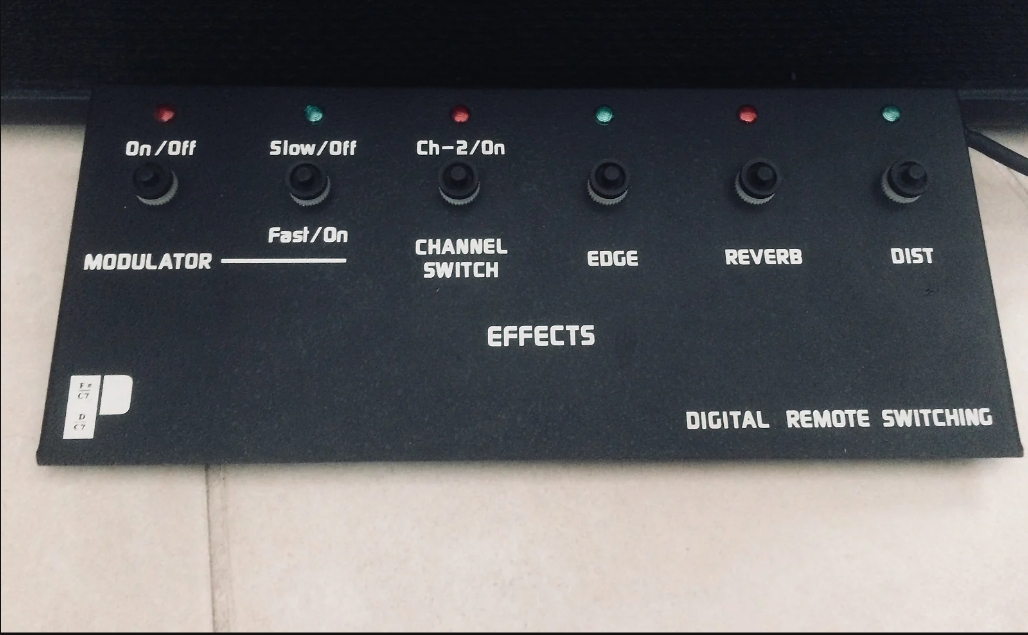 |
This foot switcher allows you to remotely activate various features of the amp. More on that in the Footswitches section below. |
Taurus I (1x12)
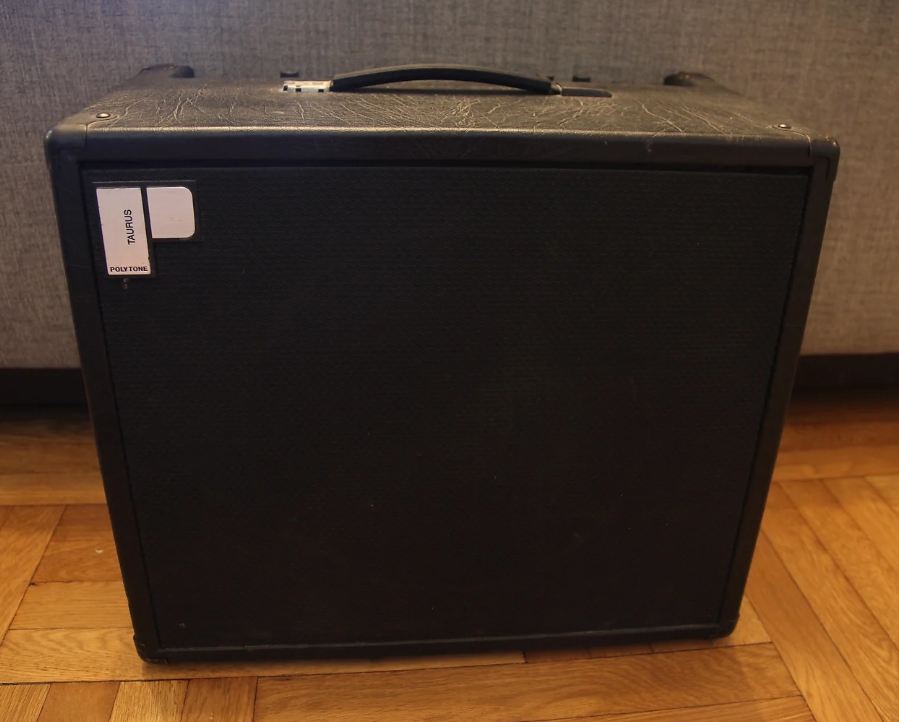 |
This is the Taurus 1 in a 1x12 format. |
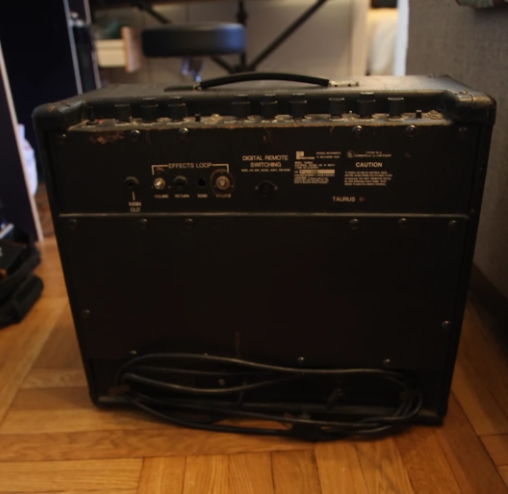 |
The back is similar to the Taurus 1 2x10 version. |
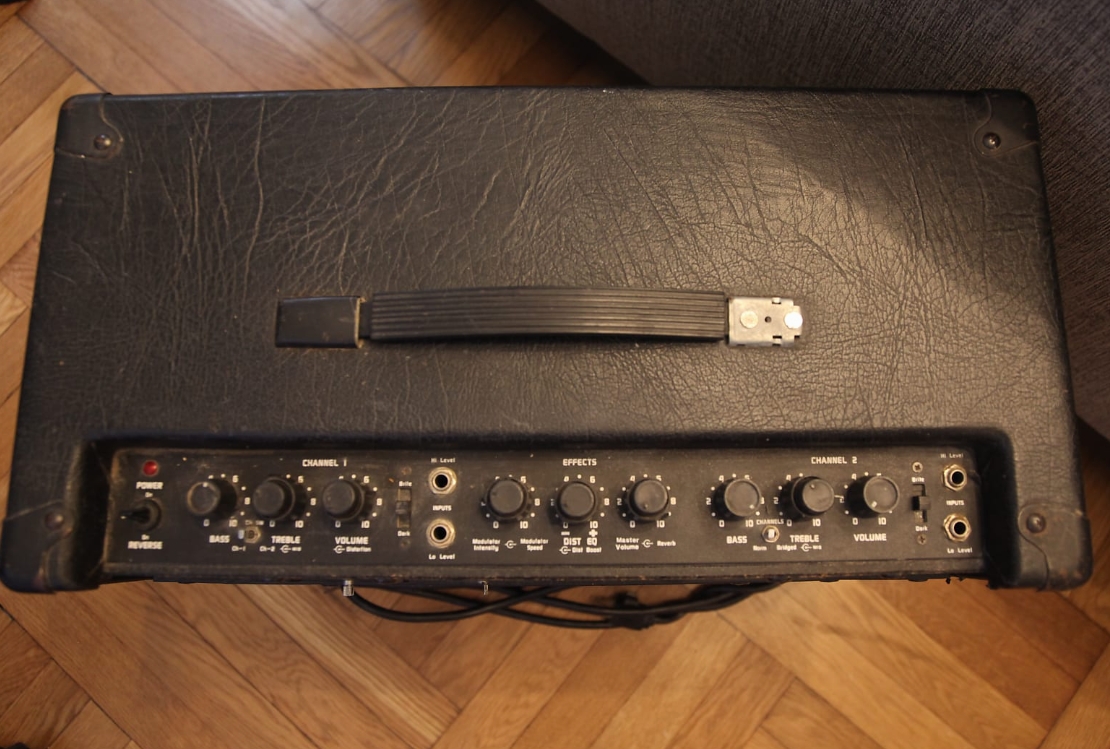 |
The controls are the same as the Taurus 2x10 version but at mounted on top towards the back in standard Polytone fashion. |
Taurus III (1x15)
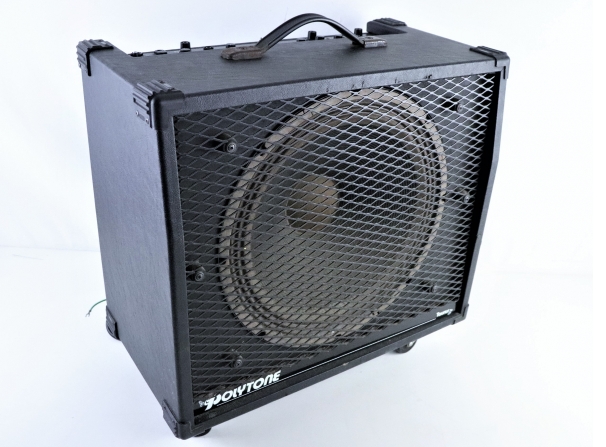 |
The Taurus III is essentially the Taurus IV with a 15" speaker. Power output is 125 watts. |
 |
The controls are same as Taurus IV. For more details, see the Taurus IV shown below. |
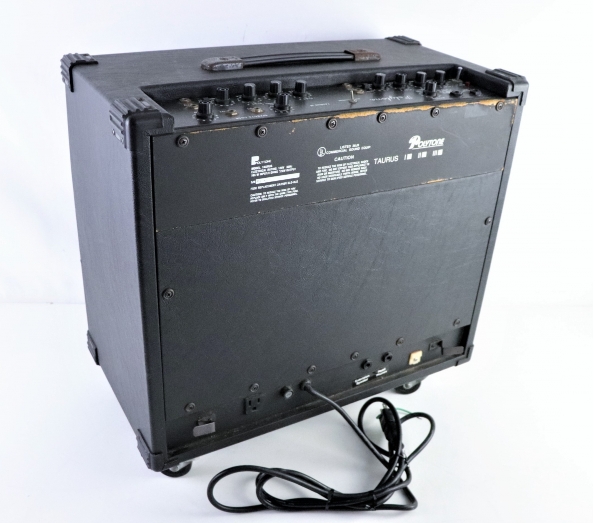 |
Here is a view of the back. |
Taurus IV (2x12)
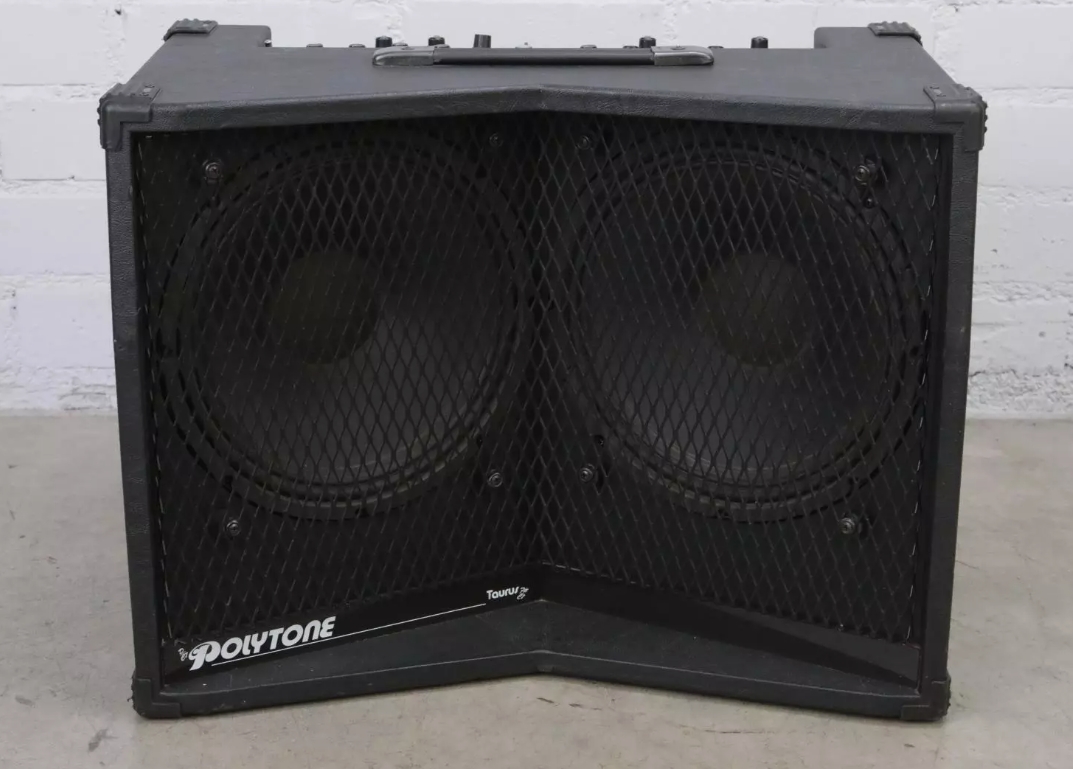 |
The Taurus IV is a very interesting design which uses two 12" speakers at angles to each other via a V-shaped speaker baffle. Power output is 125 watts and it has some features not found on other Polytones. |
 |
The back of this model has the same appearance as some of the later production Mini Brutes. |
 |
Here you can better see the V-shaped configuration of the speaker baffle. It is a very interesting concept and I wonder how that sounds. |
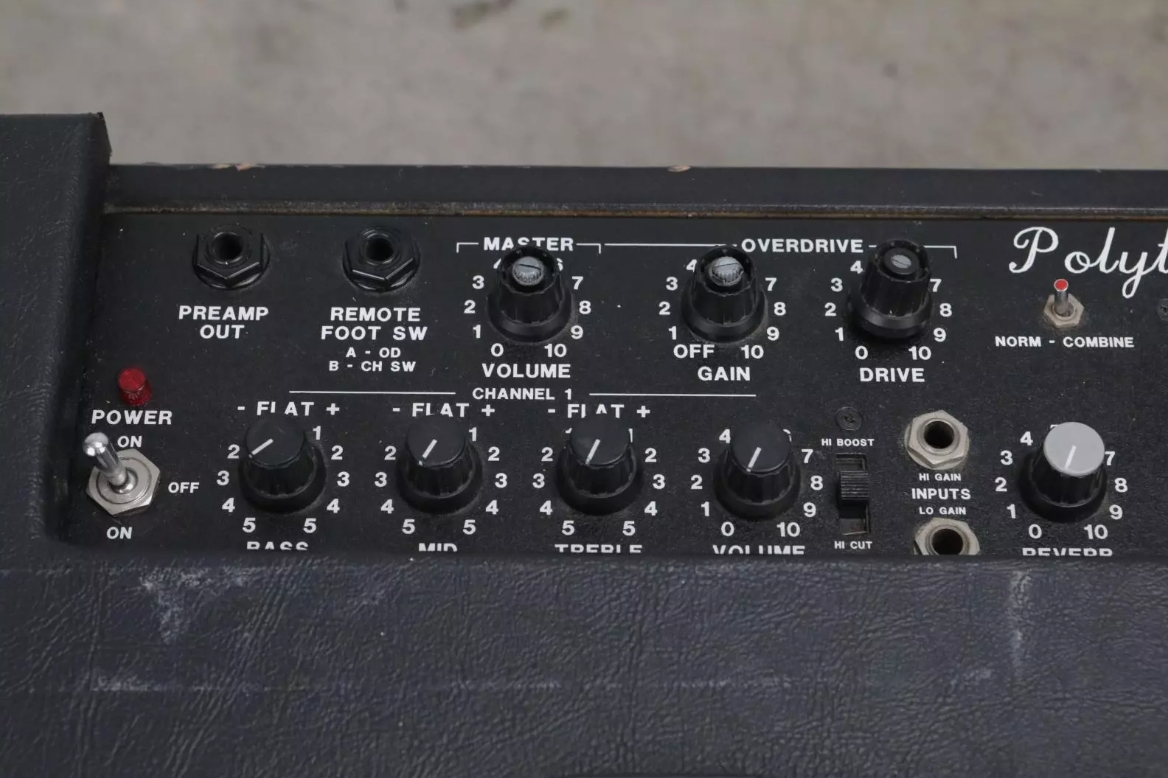 |
The chassis is substantial and has a lot of controls. Here we can see Remote Foot Sw jacks, a Master Volume, an Overdrive section with Gain & Drive controls, a Normal/Combine switch, and Channel 1 controls with Bass, Mids, Treble and Volume controls. Instead of a Brite/Normal/Dark switch they are calling it a Boost/Normal/Hi Cut. And of course, there is the standard Hi & Low input jacks. |
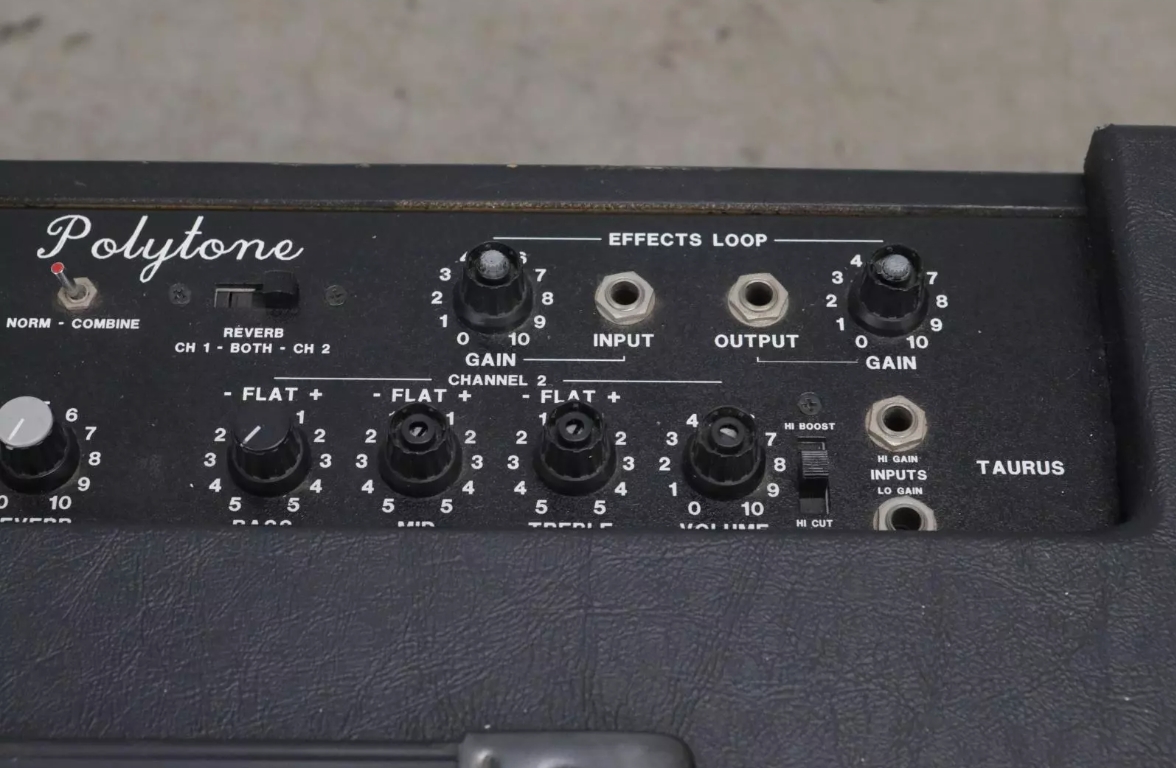 |
Channel 2 has same controls as Channel 1. Above Channel 1 controls are Send and Return jacks for the Effects Loop, with their respective Volume controls. Note this version does not have the RS Modulator feature. |
Taurus Elite
 |
The Taurus Elite is another interesting Polytone offering. This one has THREE channels, a one 15" speaker and two horns, which have an attenuation control (see controls below). Output power is 140 watts RMS and it weighs 47 lbs. It was listed on the Polytone website circa 2004 under Special Orders. The schematic is linked at the bottom of this page. |
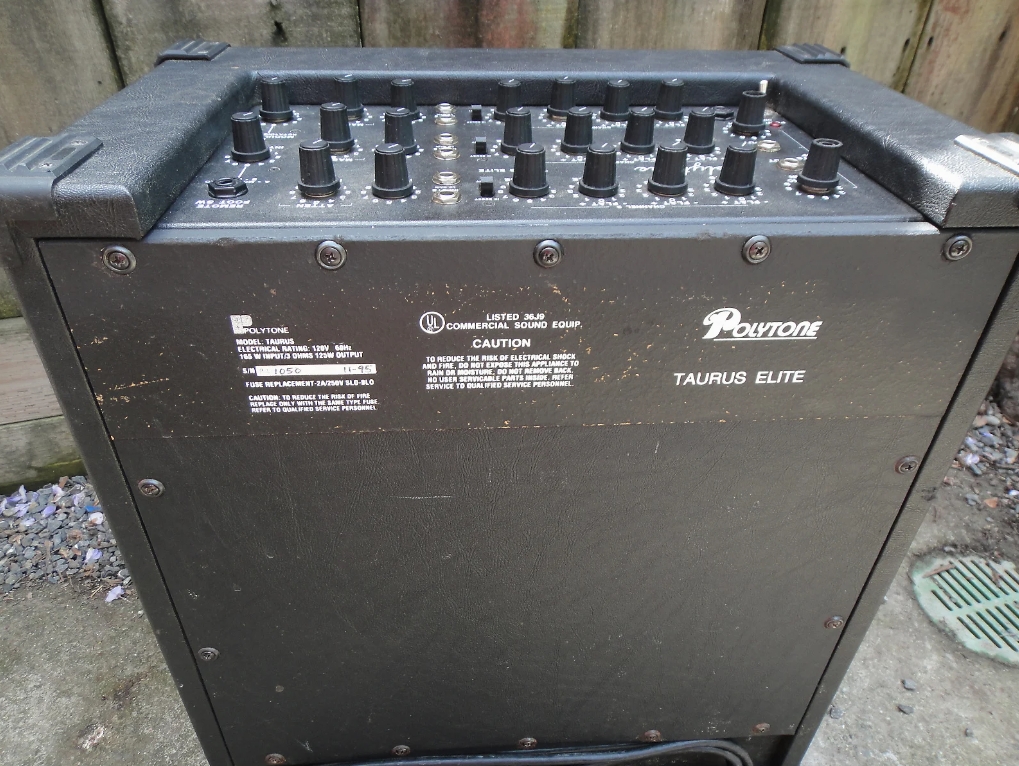 |
The back looks similar to the two Taurus models above. |
 |
On this very substantial chassis there are controls for Channels 1, 2 & 3. They all have Bass, Mid, Treble and Volume. There is a Boost/Normal/Hi Cut switch on every channel, and of course, there are the standard Hi & Low input jacks for each channel. On the right side of the chassis there are Reverb and Master Volume controls for Channels 1 & 2. Channel 3 appears to have a control for Reverb and Horn Attenuation. There are also controls for the RS Modulator and a Remote Footswitch jack. |
Baby Taurus
 |
The "Baby Taurus" is essentially the Mini Brute II in an open back cabinet. Output power is 75 watts and it has an 8" speaker. Controls are Reverb, Treble, Mid, and Bass. Included is the standard Bright/Normal/Dark switch, and the usual Hi & Low inputs. The distortion channel has volume control and Gain -/+. |
 |
The back has a Distortion/Reverb jack, a Main Out, an Ext Speaker jack and Headphones jack. Date code on the speaker appears to be 1986, which seems to line up with when they were using red graphics on black chassis. |
Fusion (1x12 TUBE amp)
 |
The Fusion is a most interesting Polytone amplifier. It's the only tube model they offered as far as I know and it incorporates some interesting features such as a switch that can make it be either 60 watts or 100 watts and "Dial-A-Sound". It uses a single 12" speaker, which is offset to one side of the cabinet. It has two channels and a lot of features. |
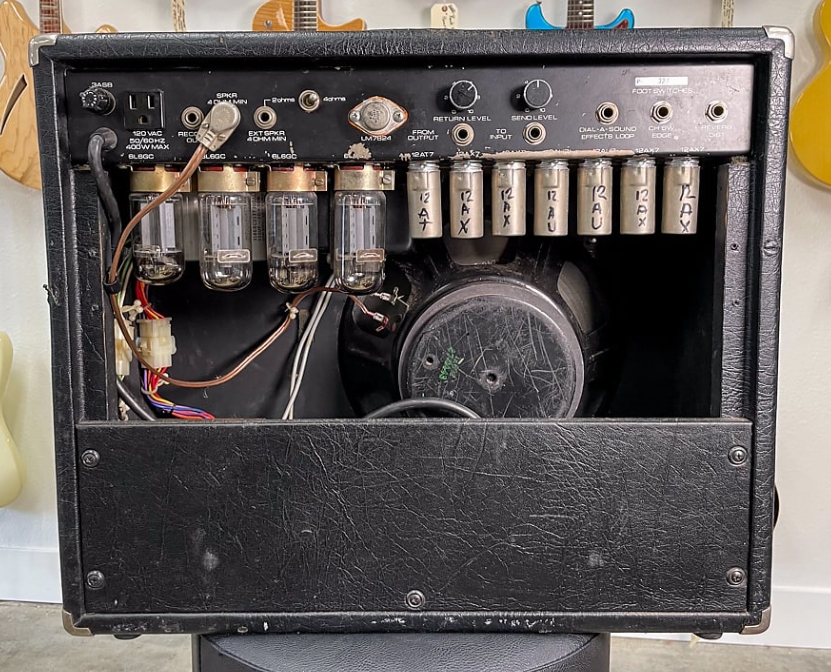 |
Looking at the back, we can see it was designed around four 6L6s. To the right of the power tubes are an array of 12AX7, 12AT7 and 12AU7 preamp tubes. Another departure from Polytone tradition is that this speaker cabinet has an open back. |
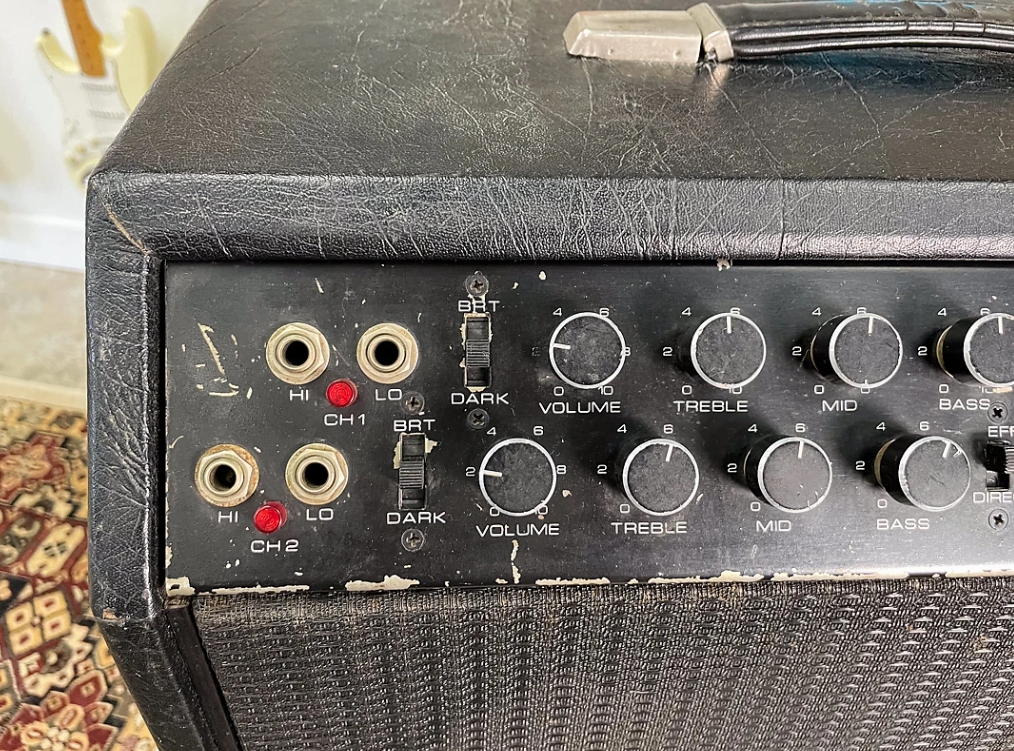 |
Left side of chassis we can see there are Bass, Mid, Treble and Volume controls for each channel. Each channel has a Hi & Low input jack and a Brite/Normal/Dark switch. |
 |
In the middle of the chassis we can see the "Dial-A-Sound" switch with Off, Rock 1, Rock 2, Metal, Jazz and Country settings. I suspect that these are just fixed gain settings somewhere in the preamp section. |
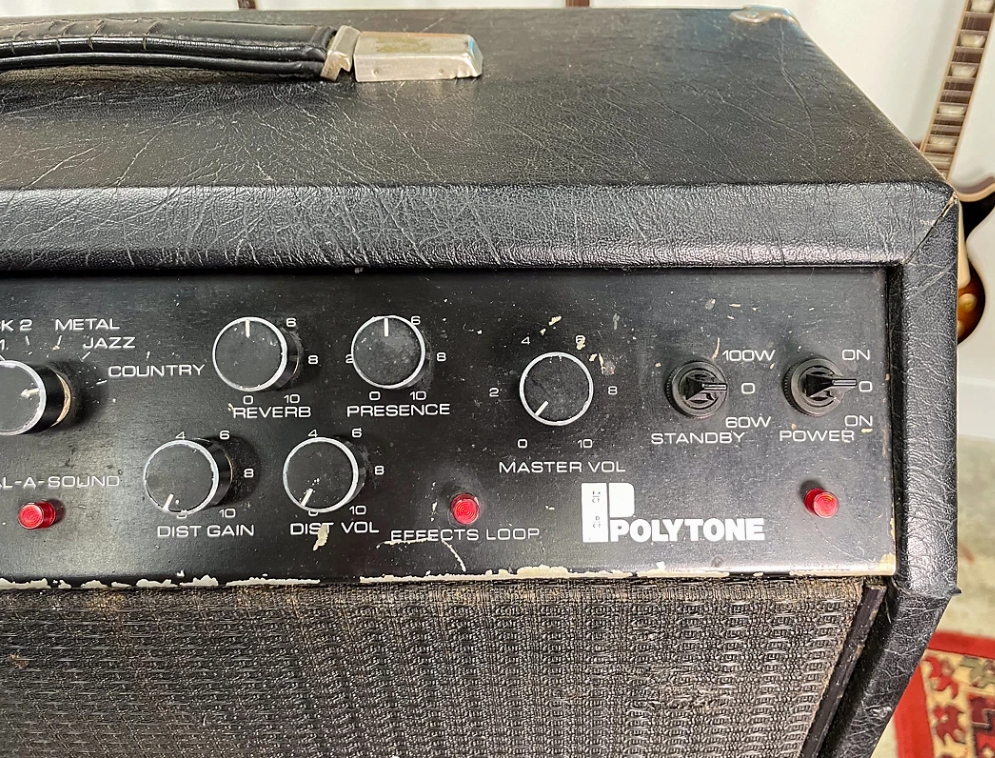 |
On the right side of the cahssis there are Reverb, Presence and Distortion Gain & Volume controls along with the 60 watt/100 watt switch, along with the power and standby switches. |
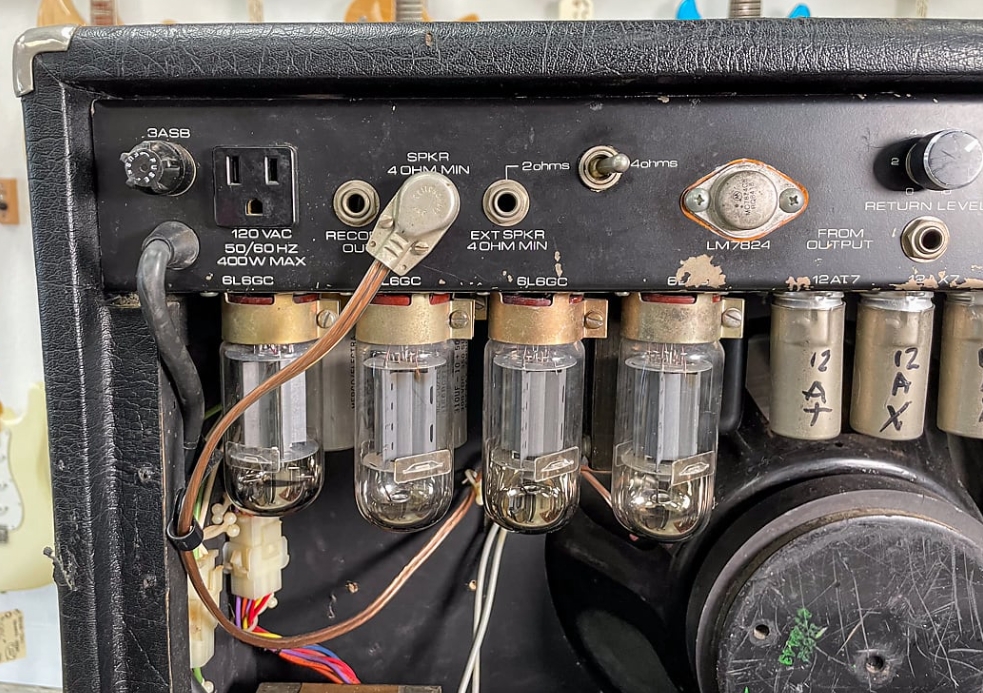 |
Back of chassis at left we have a 120V outlet, speaker jacks and an impedance switch. |
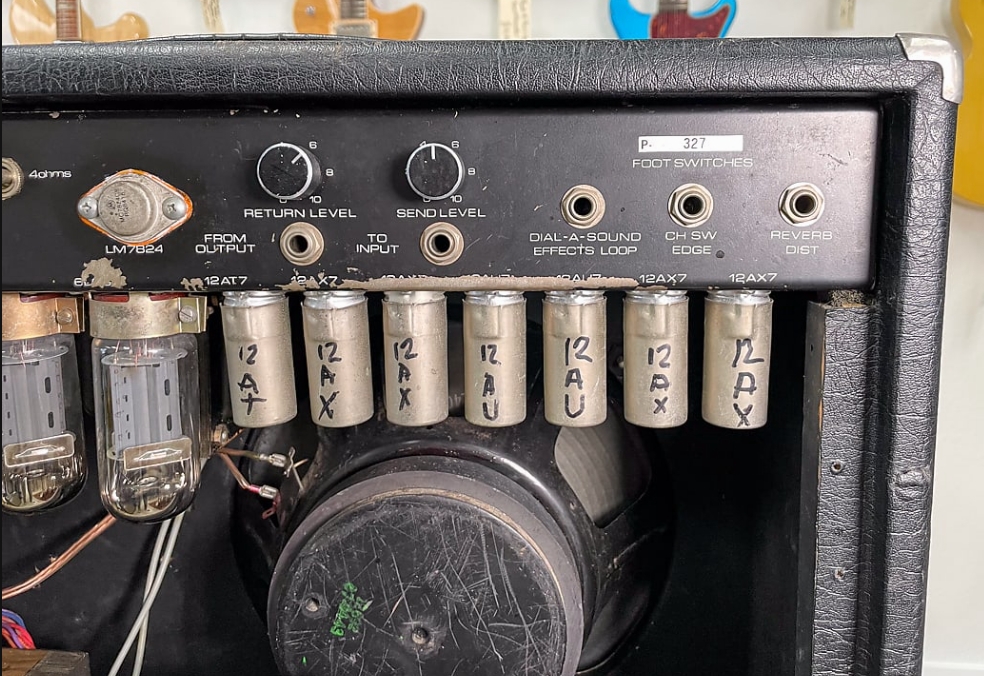 |
Back of chassis at right we have Effects Loop Send & Return with their respective Level controls. There is a jack for Dial-A-Sound Effects Loop, Ch Sw Edge and Reverb/Dist. |
RS Modulator
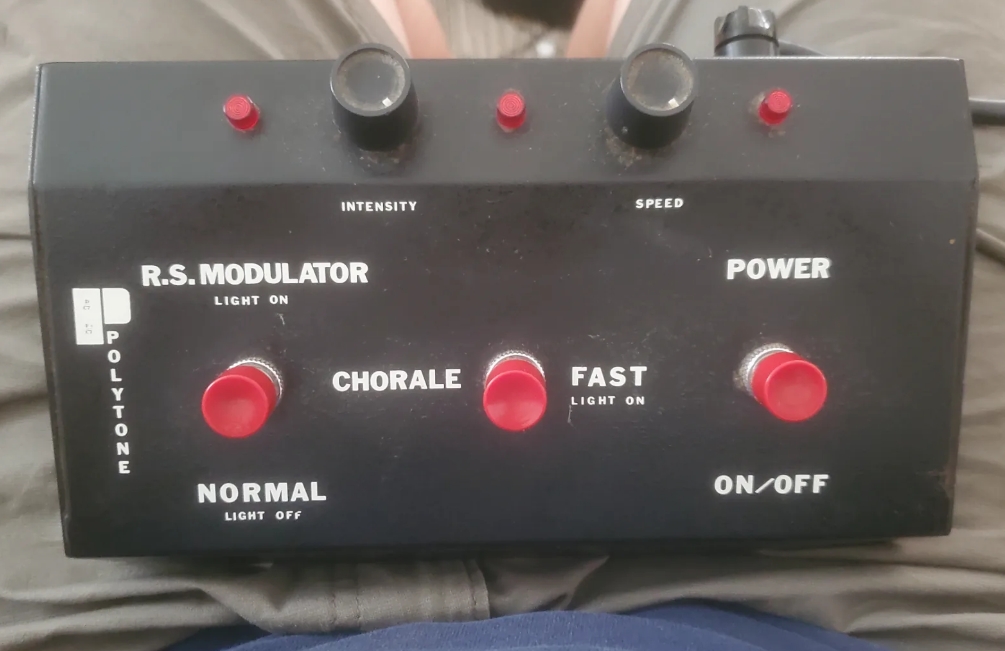 |
This seldom seen standalone pedal powered by 120V reminds me a bit of the Harmonic Divider of the Model 102 & Model 104 amps but has its own flavor. I think it sounds pretty cool and just had to pick up one for myself. The "RS" in the name means Rotary Sound, and the name infers that it's intended to sound like a rotating speaker such as a Leslie. My example has date codes of 1984 & 1985 on some of the IC chips, and in permanent marker is scribbled a date of 1987. This method of dating was also customary on their amps, so likely my example was made in 1987. The RS Modulator appears in the 1989 Polytone catalog. It does everything from a very nice chorus to an actual vibrato (verified via oscilloscope). |
 |
Here is what the circuit board looks like. We can see that it operates on a bipolar power supply (+15V / -15V) via a pair of voltage regulators. It uses six IC chips and half a dozen transistors. I did a lot of searching for a schematic specific to this unit but had no success. I generated my own, which can be found on the RS Modulator page linked at the bottom of this page. The majority of it is shown on the Taurus Elite schematic also linked at the bottom of this page and is what I used to derive the schematic. The circuit is centered around a "PT2201" IC chip (markings were removed from chip), which almost certainly is a TDA1022 BBD chip, a quad 2-input NAND gate IC chip (MC14011) that provides the clock frequencies and an LFO section which creates the modulation effect. The rest of the IC chips are standard general purpose opamps. It's an interesting circuit. |
Multivoicer
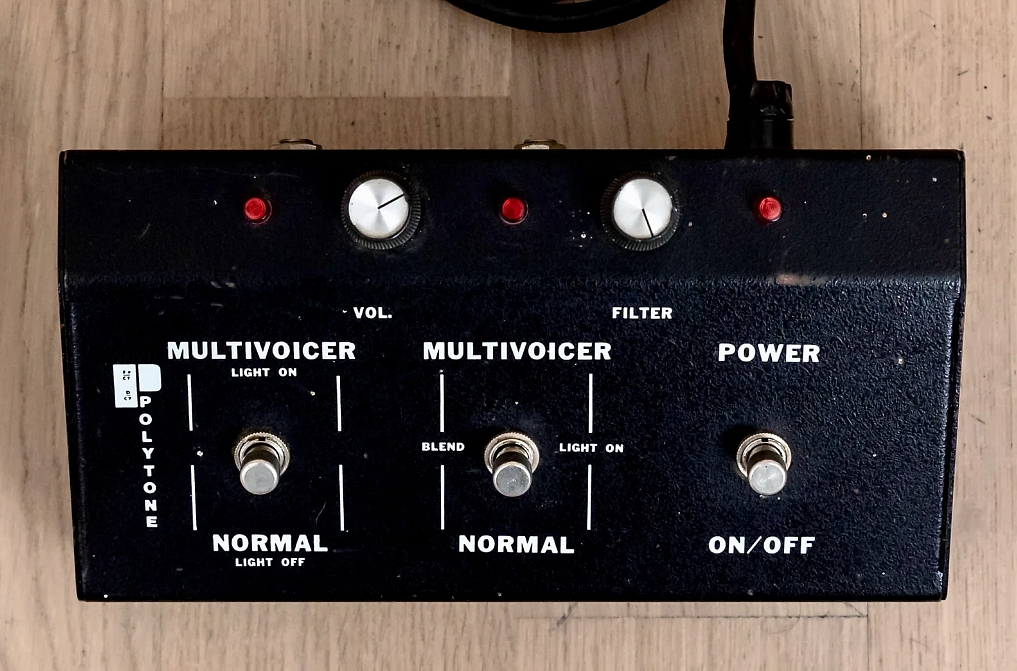 |
Another seldom seen standalone pedal powered by 120V which apparently is a Fuzz and Octave unit. There's only two controls, Volume and Filter. I have no other info on it at the moment but have included it here for posterity. It appears in the 1983 Polytone catalog. Seems to be even more rare than the RS Modulator is. |
Foot Switchers
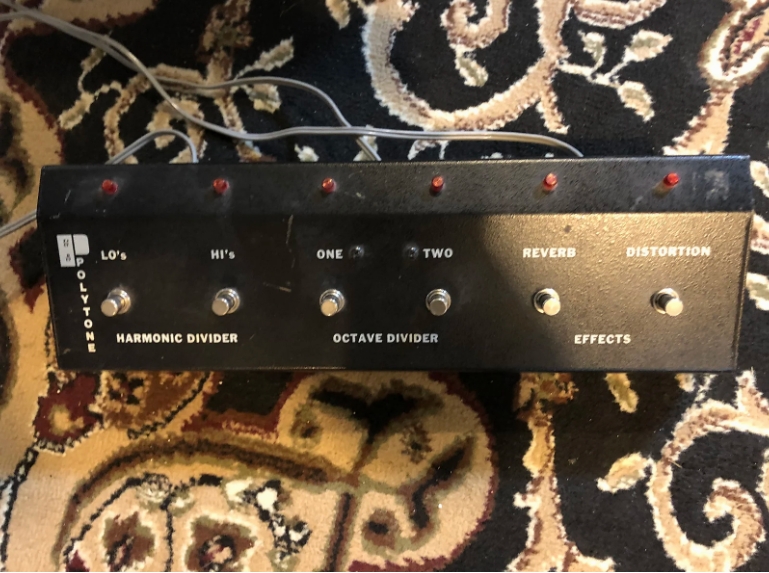 |
This type would be used with the Model 102 & Model 104. It can remotely control the Distortion, Reverb, Harmonic Divider Hi & Lo and the Octave Divider Hi & Lo. It is powered by some "C" batteries. |
 |
It appears that this foot switcher was intended for use with the Model S12L and Model S15L, or any other models that share the same features. |
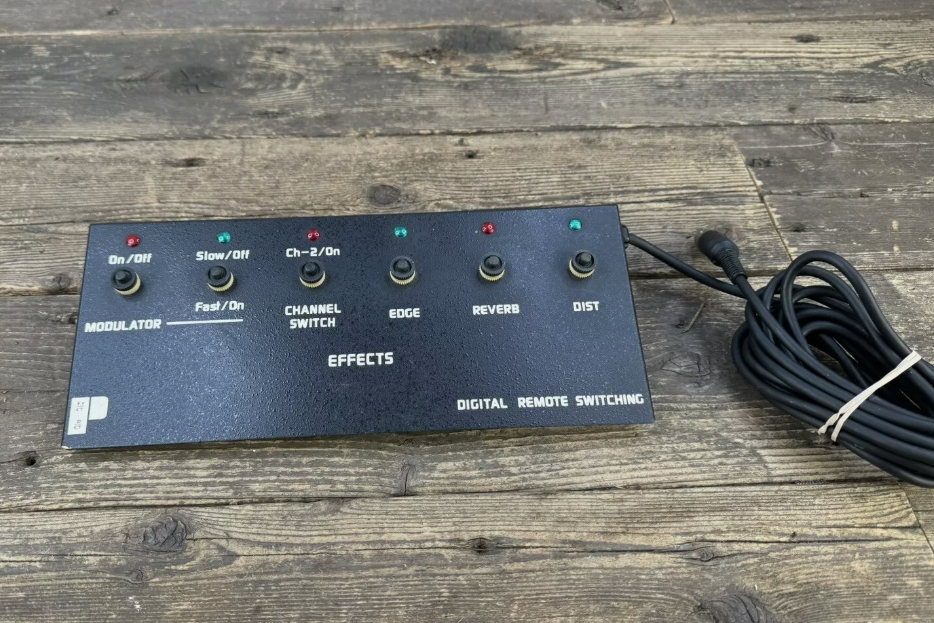 |
This foot switcher is for use with the Taurus 1 and Taurus 4, or any other amps that share the same features. It allows you to remotely activate the RS Modulator and its various features, switch channels and to turn on/off the Edge, Reverb and Distortion. |
 |
Honestly I'm not really sure what amps this one is intended for. It seems to be a generic foot switch that can control two parameters remotely. Or maybe it's intended to be a channel switcher? Yet to be determined. It could be used with the Models S12L & S15L and Mini Brutes I, II, III & VI as far as I can tell. There was also an earlier version that is dark grey (?) with white lettering. |
Power Amps (100 watt)
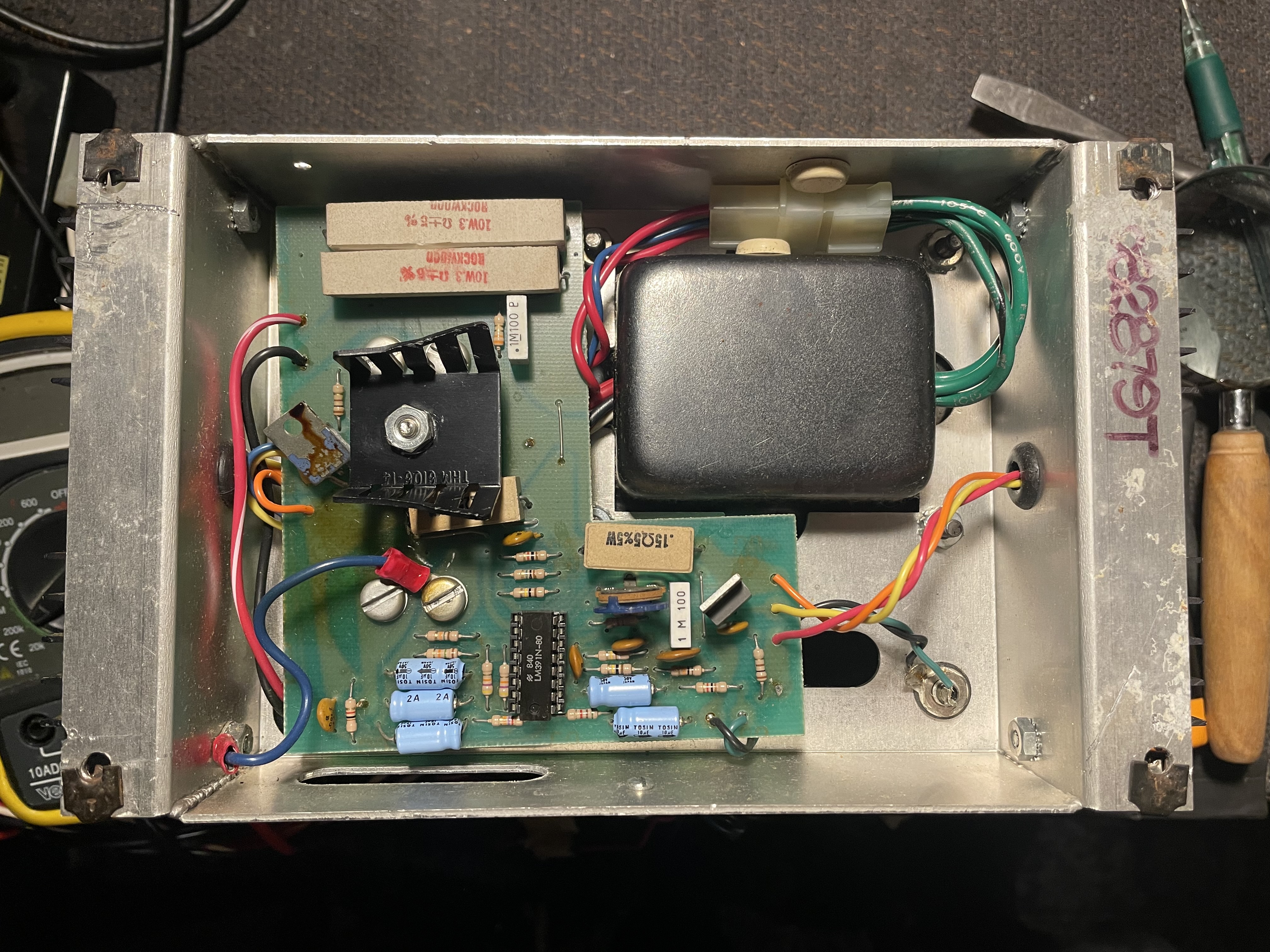 |
The PA-378 was the first version of the PA-378 series. It was based on the LM391 IC chip. It looks pretty much identical to the PA-378A shown below. Here we see the PCB. Below you can see what it looks like externally. See the links at the bottom of this page for a link to my PCB layout. |
 |
This is the PA-378A power amp. Physically the PA-378 and PA-378A look the same, but the PA-378A power amp added protection diodes on the power transistors as well as a thermistor. The easy way to tell if it's the PA-378A is there will be a thermistor on one of the power transistors with wires from it going into the chassis. The large electrolytic caps are the main filter caps, which are 7300uF and rated for 3,000 hours. |
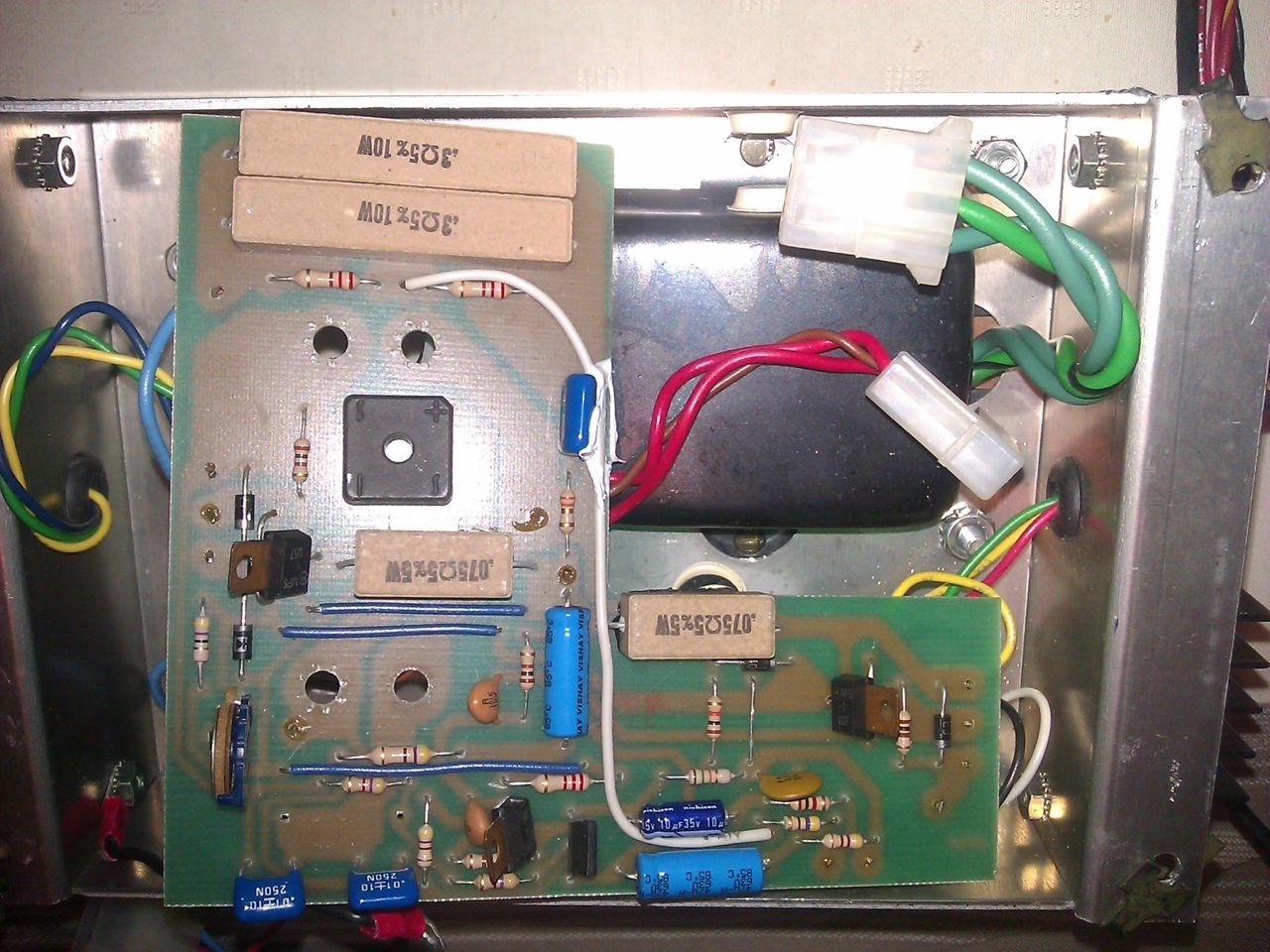 |
It's very easy to identify the PA-378B power amp. There will be no LM391 IC chip on the PCB and the layout of the components
is obviuosly different from the PA-378 & PA-378A circuit boards. See links at bottom of this page for PCB/component layout. |
Power Amps (55 watt & 110 watt)
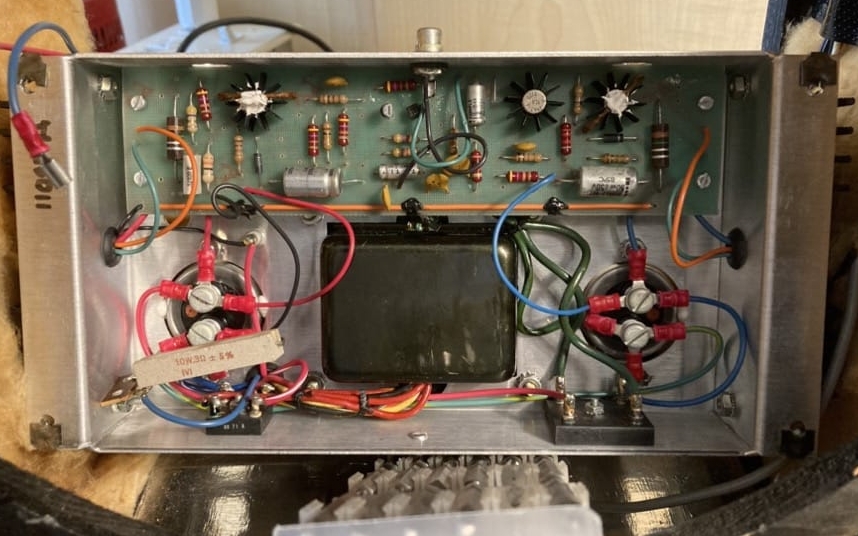 |
This is the 55 watt power supply. It was used in the Model 100, 200 & 103 amps. The 110 watt power supply was used in the Model 101, 104, 212-300 and 215-300. I'm not sure if the 100 watt circuit board looks the same as the 55 watt model. |
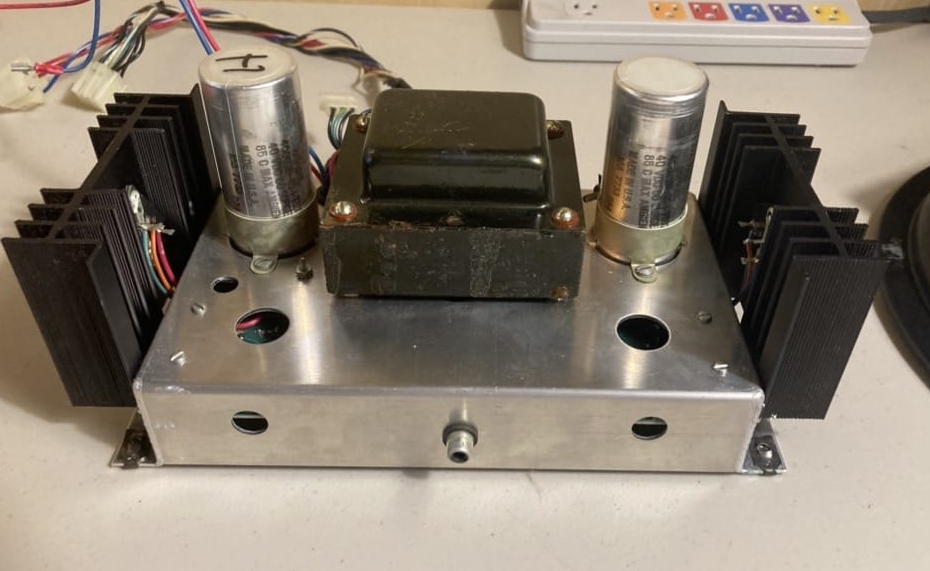 |
From the outside it's very easy to tell these power supplies apart from the PA-378 series power amp. The main filter caps are one on each side of the power transformer vs. two on one side on the PA-378 type. See links at the bottom of this page for schematics of the 55 watt and 110 watt power supplies. |
Power Amp (75 watt)
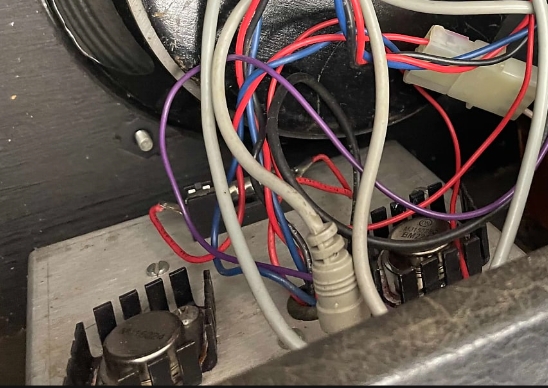 |
This power supply is found in some 75 watt models, such as the Baby Taurus. That's about all the info I have on this one at the moment. I'm not sure if there is a higher wattage version of this one or not. The heat sinks are tiny compared to the other Polytone power amps. Also the very large externally mounted electrolytic caps are not present, which makes fitting various speakers in the cabinet much less of a hassle. It seems that the schematic for this power supply is part of the schematic for the model of amp which these are found in. |
If you have anything to contribute or corrections to point out, please email me via the link on my home page. If I run across any more Polytone amp
models not included here I'll be sure to add those to this page.
The president of Polytone, Tommy Gumina, shown below in front of his North Hollywood office with Joe Pass; date unknown. Note the Mini Brute
amps in the foreground. Joe Pass was the very first guitarist to play and endorse POLYTONE amplifiers and Ray Brown,
the first bass player to play and endorse Tommy Gumina's first bass amp # 101. This association continued for decades until
Joe's death in 1994 and Ray's in 2002. Polytone was founded in 1968. Tommy died in 2013 and the Polytone brand passed on with him.
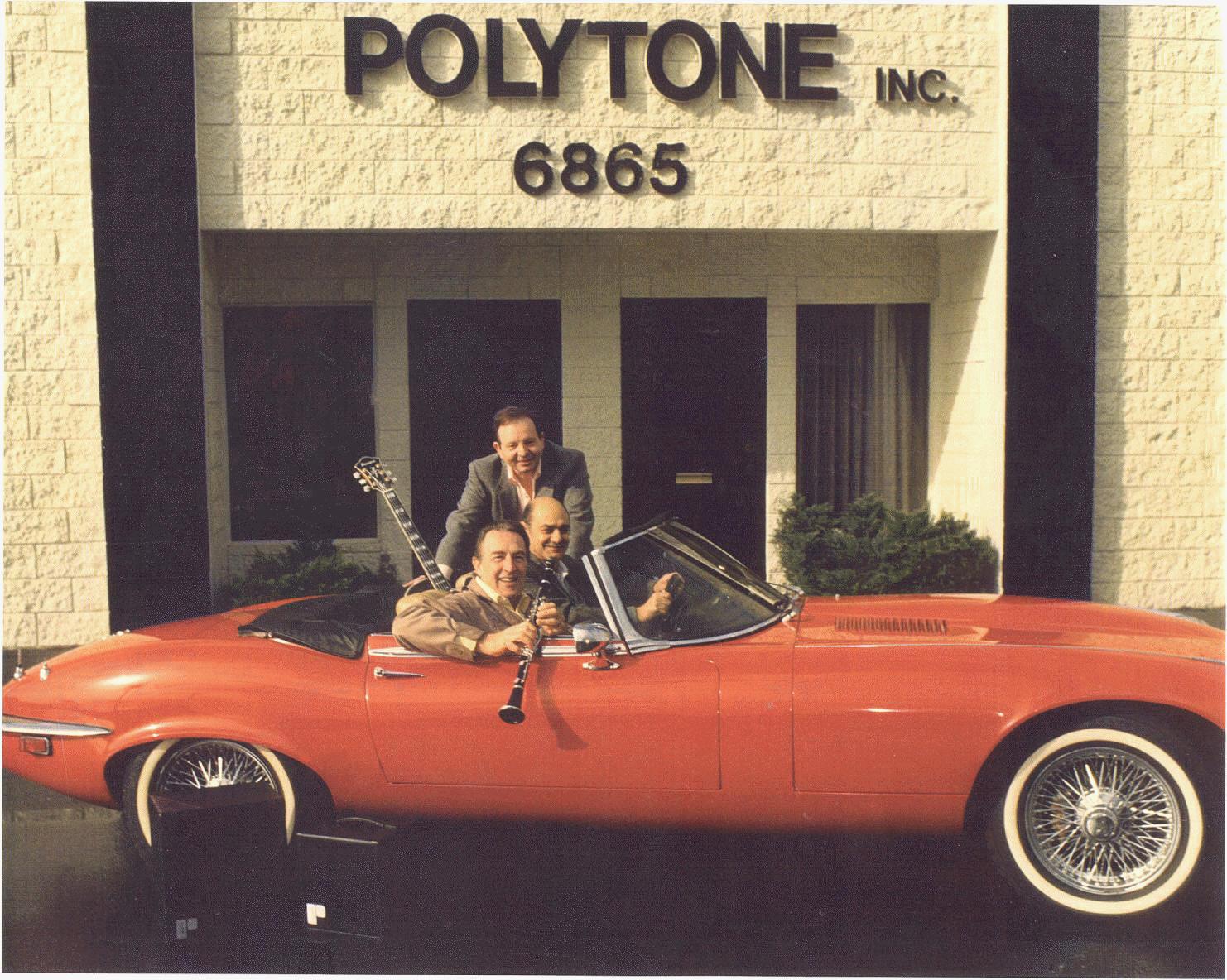
In this undated photo, there was apparently an event which was promoting Polytone. Tommy Gumina (accordian) is playing with Pat Martino (right) and Ron Eschete (left). For a time Pat Martino played Polytone guitars exclusively. Polytone guitars seem to be rather rare birds with their own interesting story.
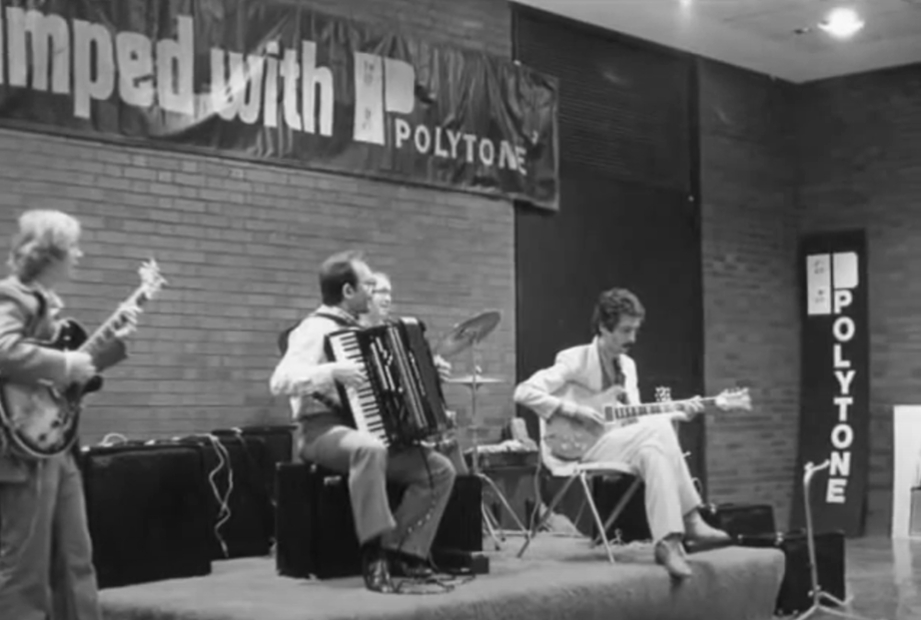
2009 Price List from the Polytone website.
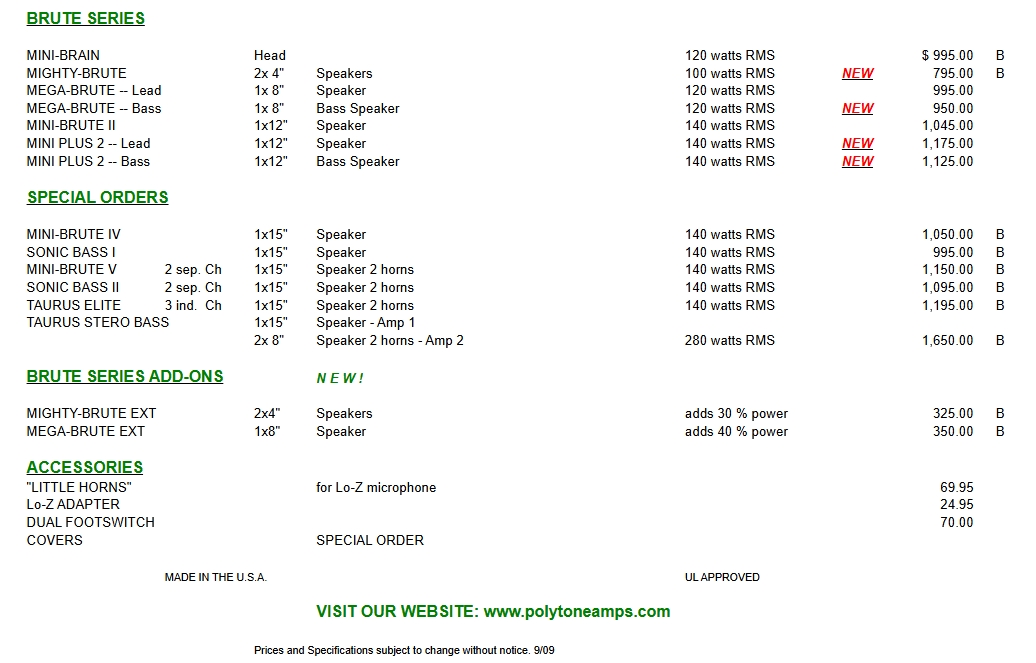

Polytone Mini Brute I, II, III & IV Owners Manual (mid to late 1990s)
Polytone Mini Brutes with Sonic Circuit Owners Manual (late 90s-early 2000s)
Polytone Mini Brute V Owners Manual
Polytone Mini Brute Series Schematic
Polytone Mini Brutes with Reverb Schematic
Polytone Mini Brute PCB & Component Layout (No Reverb or Distortion)
Polytone Mini Brute PCB & Component Layout (Models with Reverb and/or Distortion)
Polytone Mini Brute II PCB & Component Layout (578C PCB)
Polytone Taurus Elite Schematic
Polytone Model 100, 102 & 103 Schematic
Polytone Maxi-Brute Model 104 PCB Layout
Polytone PA378 Power Supply Schematic
Polytone PA378 Power Supply PCB Layout
Polytone PA378B Power Supply PCB Layout
Polytone 55 Watt Power Supply Schematic